ALMA Part 2
- “This is the earliest evidence of how a supermassive black hole is affecting the galaxy around it,” said Feige Wang, a Hubble Fellow at the University of Arizona’s Steward Observatory and leader of the research team. “From observations of less distant galaxies, we know that this has to happen, but we have never seen it happening so early in the Universe.”
- The huge mass of J0313–1806’s black hole at such an early time in the Universe’s history rules out two theoretical models for how such objects formed, the astronomers said. In the first of these models, individual massive stars explode as supernovae and collapse into black holes that then coalesce into larger black holes. In the second, dense clusters of stars collapse into a massive black hole. In both cases, however, the process takes too long to produce a black hole as massive as the one in J0313-1806 by the age at which we see it.
- “This tells you that no matter what you do, the seed of this black hole must have formed by a different mechanism,” said Xiaohui Fan, also of the University of Arizona. “In this case, it’s a mechanism that involves vast quantities of primordial, cold hydrogen gas directly collapsing into a seed black hole.”
- The ALMA observations of J0313–1806 provided tantalizing details about the quasar host galaxy, which is forming new stars at a rate 200 times that of our Milky Way. “This is a relatively high star formation rate in galaxies of similar age, and it indicates that the quasar host galaxy is growing very fast,” said Jinyi Yang, the second author of the report, who is a Peter A. Strittmatter Fellow at the University of Arizona.
- The quasar’s brightness indicates that the black hole is swallowing the equivalent of 25 Suns every year. The energy released by that rapid feeding, the astronomers said, probably is powering a powerful outflow of ionized gas seen moving at about 20 percent of the speed of light.
- Such outflows are thought to be what ultimately stops star formation in the galaxy.
- “We think those supermassive black holes were the reason why many of the big galaxies stopped forming stars at some point,” Fan said. “We observe this ‘quenching’ at later times, but until now, we didn’t know how early this process began in the history of the Universe. This quasar is the earliest evidence that quenching may have been happening at very early times.”
- This process also will leave the black hole with nothing left to eat and halt its growth, Fan pointed out.
- In addition to ALMA, the astronomers used the 6.5-meter Magellan Baade telescope, the Gemini North telescope and W.M. Keck Observatory in Hawaii, and the Gemini South telescope in Chile.
- The astronomers plan to continue studying J0313-1806 and other quasars with ground-based and space-based telescopes.
• January 11, 2021: “This is the first time we have observed a typical massive star-forming galaxy in the distant Universe about to ‘die’ because of a massive cold gas ejection,” says Annagrazia Puglisi, lead researcher on the new study, from the Durham University, UK, and the Saclay Nuclear Research Centre (CEA-Saclay), France. The galaxy, ID2299, is distant enough that its light takes some 9 billion years to reach us; we see it when the Universe was just 4.5 billion years old. 67)
- The gas ejection is happening at a rate equivalent to 10,000 Suns per year, and is removing an astonishing 46% of the total cold gas from ID2299. Because the galaxy is also forming stars very rapidly, hundreds of times faster than our Milky Way, the remaining gas will be quickly consumed, shutting down ID2299 in just a few tens of million years.
- The event responsible for the spectacular gas loss, the team believes, is a collision between two galaxies, which eventually merged to form ID2299. The elusive clue that pointed the scientists towards this scenario was the association of the ejected gas with a “tidal tail”. Tidal tails are elongated streams of stars and gas extending into interstellar space that result when two galaxies merge, and they are usually too faint to see in distant galaxies. However, the team managed to observe the relatively bright feature just as it was launching into space, and were able to identify it as a tidal tail.
- Most astronomers believe that winds caused by star formation and the activity of black holes at the centers of massive galaxies are responsible for launching star-forming material into space, thus ending galaxies’ ability to make new stars. However, the new study published today in Nature Astronomy suggests that galactic mergers can also be responsible for ejecting star-forming fuel into space.
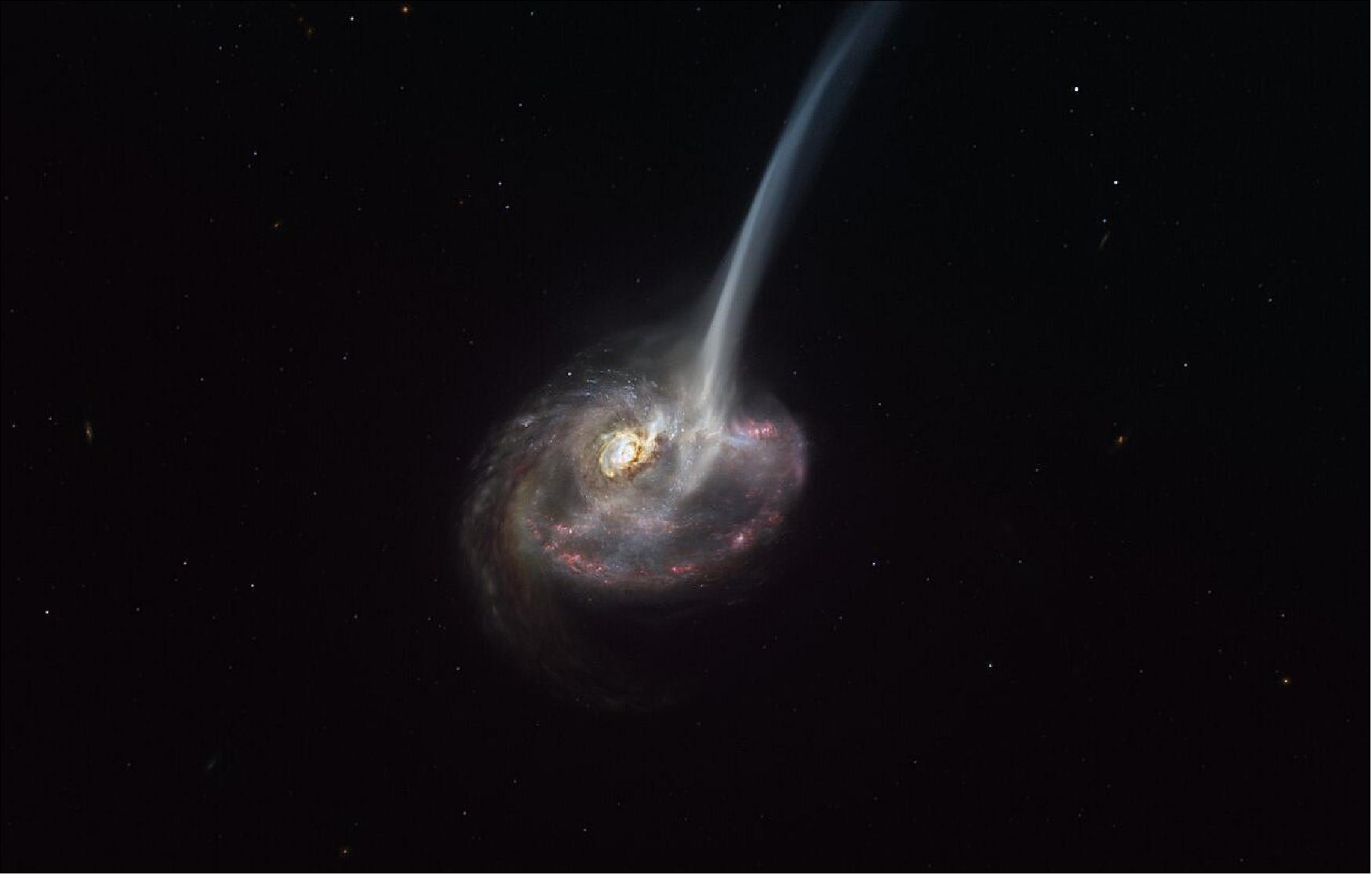
- “Our study suggests that gas ejections can be produced by mergers and that winds and tidal tails can appear very similar,” says study co-author Emanuele Daddi of CEA-Saclay. Because of this, some of the teams that previously identified winds from distant galaxies could in fact have been observing tidal tails ejecting gas from them. “This might lead us to revise our understanding of how galaxies ‘die’,” Daddi adds. 68)
- Puglisi agrees about the significance of the team’s finding, saying: "I was thrilled to discover such an exceptional galaxy! I was eager to learn more about this weird object because I was convinced that there was some important lesson to be learned about how distant galaxies evolve."
- This surprising discovery was made by chance, while the team were inspecting a survey of galaxies made with ALMA, designed to study the properties of cold gas in more than 100 far-away galaxies. ID2299 had been observed by ALMA for only a few minutes, but the powerful observatory, located in northern Chile, allowed the team to collect enough data to detect the galaxy and its ejection tail.
- "ALMA has shed new light on the mechanisms that can halt the formation of stars in distant galaxies. Witnessing such a massive disruption event adds an important piece to the complex puzzle of galaxy evolution," says Chiara Circosta, a researcher at the University College London, UK, who also contributed to the research.
- In the future, the team could use ALMA to make higher-resolution and deeper observations of this galaxy, enabling them to better understand the dynamics of the ejected gas. Observations with the future ESO’s Extremely Large Telescope could allow the team to explore the connections between the stars and gas in ID2299, shedding new light on how galaxies evolve.
• December 16, 2020: On Friday 11 December, ESO Director General Xavier Barcons received the Order of Bernardo O’Higgins Grand Cross, at a ceremony chaired by Carolina Valdivia, the Chilean Undersecretary of Foreign Affairs. 69)

- The Order Bernardo O’Higgins is a recognition by the Chilean State for foreign citizens’ outstanding work in the fields of art, science, education, industry, commerce or humanitarian or social cooperation.
- During the ceremony, held at the Ministry of Foreign Affairs, Barcons received the award for paving new ways towards a deeper understanding between Chile and ESO.
- “On behalf of the Ministry of Foreign Affairs, I would like to extend our sincere thanks for your collaboration and for helping us boost the establishment of a new astronomical paradigm in our country that is based on a regional, fair, inclusive and citizen-oriented approach. This includes cutting edge cooperation agreements, through which Chile –with its National Research and Development Agency– and ESO can equally contribute to highlight the scientific and technological work of our fellow nationals worldwide”, said Valdivia during the ceremony.
- ESO’s Director General received the award on behalf of the entire organization. “Shortly after I took office as ESO Director General, we embarked on this joint journey towards new and more ambitious horizons, promoting true cooperation to help build towards a future that capitalizes on the knowledge society and the fourth industrial revolution”, said Barcons.
• December 8, 2020: Linda Tacconi, a senior astronomer at the Max Planck Institute for Extraterrestrial Physics (MPE) in Garching, Germany, has been elected as the next president of ESO’s main governing body, the Council. 70)

- “I am honored to have been chosen as president of the ESO Council,” Tacconi says. “The coming years represent a very exciting time for the organization, as the first light of ESO’s Extremely Large Telescope approaches and current facilities, such as ESO’s Very Large Telescope, continue at the forefront of astronomical research. The various ESO observatories will work in synergy, furthering our knowledge of the Universe and strengthening ESO’s position as a world-leader in ground-based astronomy. I look forward to sharing in this experience and working with Council to support ESO in maintaining this leadership role.”
- Tacconi completed her PhD at the University of Massachusetts, USA, in 1988 and later worked at the Netherlands Foundation for Research in Astronomy, in Dwingeloo, before starting her career at the MPE in 1991. In 2012, she received the Lancelot M. Berkeley New York Community Trust Prize in recognition of her contributions to the field of astronomy, in particular for her work on cold gas in massive star-forming galaxies in the young universe.
- Tacconi has been strongly involved with ESO for a number of years, including in Council where she has served as the German Scientific Delegate since 2016. In addition to her role in Council, she was the chair of ESO’s Scientific Technical Committee in 2006–2008. She has also served on several other international committees, including as chair of the Programme Committee and of the Science Advisory Committee of IRAM, an international research institute for millimeter astronomy. She currently serves on the ALMA Board and chairs the Senior Committee for the European Space Agency’s (ESA’s) Voyage 2050, a programme to define ESA’s space science roadmap for 2035–2050.
- Tacconi succeeds Willy Benz from the University of Bern, Switzerland, in leading the ESO Council. ESO’s Director General, Xavier Barcons, expresses his thanks to the former president: “I would like to thank Willy on behalf of all ESO staff for his tireless work as Council President, particularly during these unprecedented times. I look forward to continuing working with Linda in her new role as Council President.”
• November 30, 2020: Astronomers have detected fast-moving carbon monoxide gas flowing away from a young, low-mass star: a unique stage of planetary system evolution which may provide insight into how our own solar system evolved and suggests that the way systems develop may be more complicated than previously thought. 71)
- Although it remains unclear how the gas is being ejected so fast, the team of researchers, led by the University of Cambridge, believe it may be produced from icy comets being vaporised in the star’s asteroid belt. The results have been accepted for publication in the Monthly Notices of the Royal Astronomical Society and will be presented at the Five Years After HL Tau virtual conference.
- The detection was made with the Atacama Large Millimeter/submillimeter Array (ALMA) in Chile, as part of a survey of young ‘class III’ stars, reported in an earlier paper. Some of these class III stars are surrounded by debris discs, which are believed to be formed by the ongoing collisions of comets, asteroids and other solid objects, known as planetesimals, in the outer reaches of recently formed planetary systems. The leftover dust and debris from these collisions absorbs light from their central stars and re-radiate that energy as a faint glow that can be studied with ALMA.
- In the inner regions of planetary systems, the processes of planet formation are expected to result in the loss of all the hottest dust, and class IIII stars are those that are left with - at most - dim, cold dust. These faint belts of cold dust are similar to the known debris discs seen around other stars, similar to the Kuiper belt in our own solar system, which is known to host much larger asteroids and comets.
- In the survey, the star in question, ‘NO Lup’, which is about 70% the mass of our sun, was found to have a faint, low-mass dusty disc, but it was the only class III star where carbon monoxide gas was detected, a first for this type of young star with ALMA. While it is known that many young stars still host the gas-rich planet-forming discs they are born with, NO Lup is more evolved, and might have been expected to have lost this primordial gas after its planets had formed.
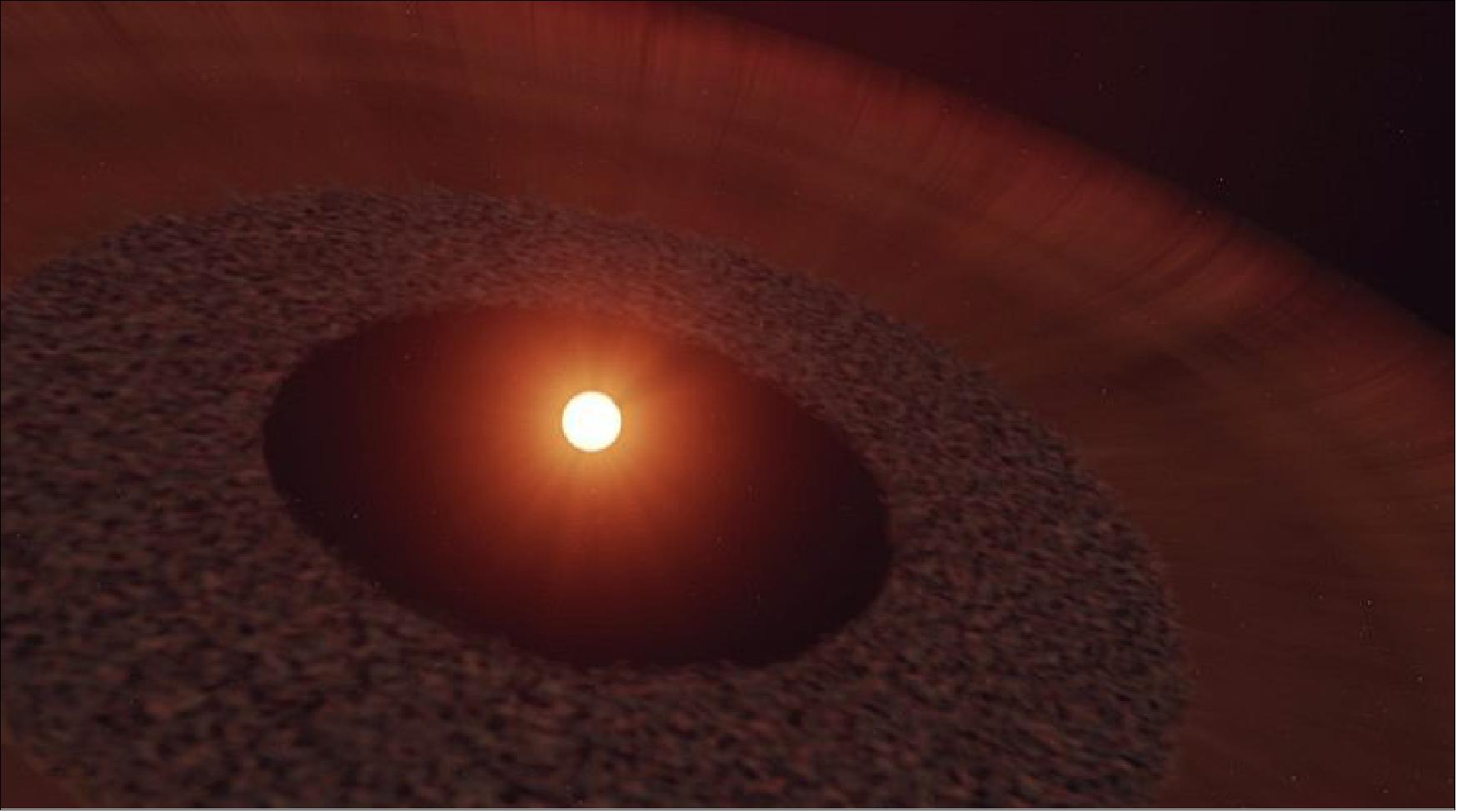
- While the detection of carbon monoxide gas is rare, what made the observation unique was the scale and speed of the gas, which prompted a follow-up study to explore its motion and origins.
- “Just detecting carbon monoxide gas was exciting, since no other young stars of this type had been previously imaged by ALMA,” said first author Joshua Lovell, a PhD student from the Cambridge’s Institute of Astronomy. “But when we looked closer, we found something even more unusual: given how far away the gas was from the star, it was moving much faster than expected. This had us puzzled for quite some time.” 72)
- Grant Kennedy, Royal Society University Research Fellow at the University of Warwick, who led the modelling work on the study, came up with a solution to the puzzle. “We found a simple way to explain it: by modelling a gas ring, but giving the gas an extra kick outward,” he said. “Other models have been used to explain young discs with similar mechanisms, but this disc is more like a debris disc where we haven’t witnessed winds before. Our model showed the gas is entirely consistent with a scenario in which it’s being launched out of the system at around 22 km/s, which is much higher than any stable orbital speed.”
- Further analysis also showed that the gas may be produced during collisions between asteroids, or during periods of sublimation – the transition from a solid to a gaseous phase – on the surface of the star’s comets, expected to be rich in carbon monoxide ice.
- There has been recent evidence of this same process in our own solar system from NASA’s New Horizons mission, when it observed the Kuiper Belt object Ultima Thule in 2019 and found sublimation evolution on the surface of the comet, which happened around 4.5 billion years ago. The same event that vaporised comets in our own solar system billions of years ago may have therefore been captured for the first time over 400 light years away, in a process that may be common around planet-forming stars, and have implications for how all comets, asteroids, and planets evolve.
- “This fascinating star is shedding light on what kind of physical processes are shaping planetary systems shortly after they are born, just after they have emerged from being enshrouded by their protoplanetary disk,” said co-author Professor Mark Wyatt, also from the Institute of Astronomy. “While we have seen gas produced by planetesimals in older systems, the shear rate at which gas is being produced in this system and its outflowing nature are quite remarkable, and point to a phase of planetary system evolution that we are witnessing here for the first time.”
- While the puzzle isn’t fully solved, and further detailed modelling will be required to understand how the gas is being ejected so quickly, what is sure is that this system is set to be the target of more intense follow-up measurements.
- “We’re hoping that ALMA will be back online next year, and we’ll be making the case to observe this system again in greater detail,” said Lovell. “Given how much we have learned about this early stage of planetary system evolution with only a short 30-minute observation, there is still so much more that this system can tell us.”
• November 23, 2020: Stellar systems like our own form inside interstellar clouds of gas and dust that collapse producing young stars surrounded by protoplanetary disks. Planets form within these protoplanetary disks, leaving clear gaps, which have been recently observed in evolved systems, at the time when the mother cloud has been cleared out. ALMA has now revealed an evolved protoplanetary disk with a large gap still being fed by the surrounding cloud via large accretion filaments. This shows that accretion of material onto the protoplanetary disk is continuing for times longer than previously thought, affecting the evolution of the future planetary system. 73)
- A team of astronomers led by Dr. Felipe Alves from the Center for Astrochemical Studies (CAS) at the Max Planck Institute for Extraterrestrial Physics (MPE) used the Atacama Large Millimeter/submillimeter Array (ALMA) to study the accretion process in the stellar object [BHB2007] 1, a system located at the tip of the Pipe Molecular Cloud. The ALMA data reveal a disk of dust and gas around the protostar, and large filaments of gas around this disk. The scientists interpret these filaments as accretion streamers feeding the disk with material extracted from the ambient cloud. The disk reprocesses the accreted material, delivering it to the protostar. The structure observed is very unusual for stellar objects at this stage of evolution — with an estimated age of 1,000,000 years — when circumstellar disks are already formed and matured for planet formation. “We were quite surprised to observe such prominent accretion filaments falling into the disk”, said Alves. “The accretion filament activity demonstrates that the disk is still growing while simultaneously nurturing the protostar.” 74)
![Figure 46: This false-color image shows the filaments of accretion around the protostar [BHB2007] 1. The large structures are inflows of molecular gas (CO) nurturing the disk surrounding the protostar. The inset shows the dust emission from the disk, which is seen edge-on. The "holes" in the dust map represent an enormous ringed cavity seen (sideways) in the disk structure (image credit: MPE)](https://www.eoportal.org/ftp/satellite-missions/a/Alma_300622/Alma_Auto3F.jpeg)
- The team also reports the presence of an enormous cavity within the disk. The cavity has a width of 70 astronomical units, and it encompasses a compact zone of hot molecular gas. In addition, supplementary data at radio frequencies by the Very Large Array (VLA) point to the existence of non-thermal emission in the same spot where the hot gas was detected. These two lines of evidence indicate that a substellar object — a young giant planet or brown dwarf — is present within the cavity. As this companion accretes material from the disk, it heats up the gas and possibly powers strong ionized winds and/or jets. The team estimates that an object with a mass between 4 and 70 Jupiter masses is needed to produce the observed gap in the disk.
- “We present a new case of star and planet formation happening in tandem,” states Paola Caselli, director at MPE and head of the CAS group. “Our observations strongly indicate that protoplanetary disks keep accreting material also after planet formation has started. This is important because the fresh material falling onto the disk will affect both the chemical composition of the future planetary system and the dynamical evolution of the whole disk.” These observations also put new time constraints for planet formation and disk evolution, shedding light on how stellar systems like our own are sculpted from the original cloud.
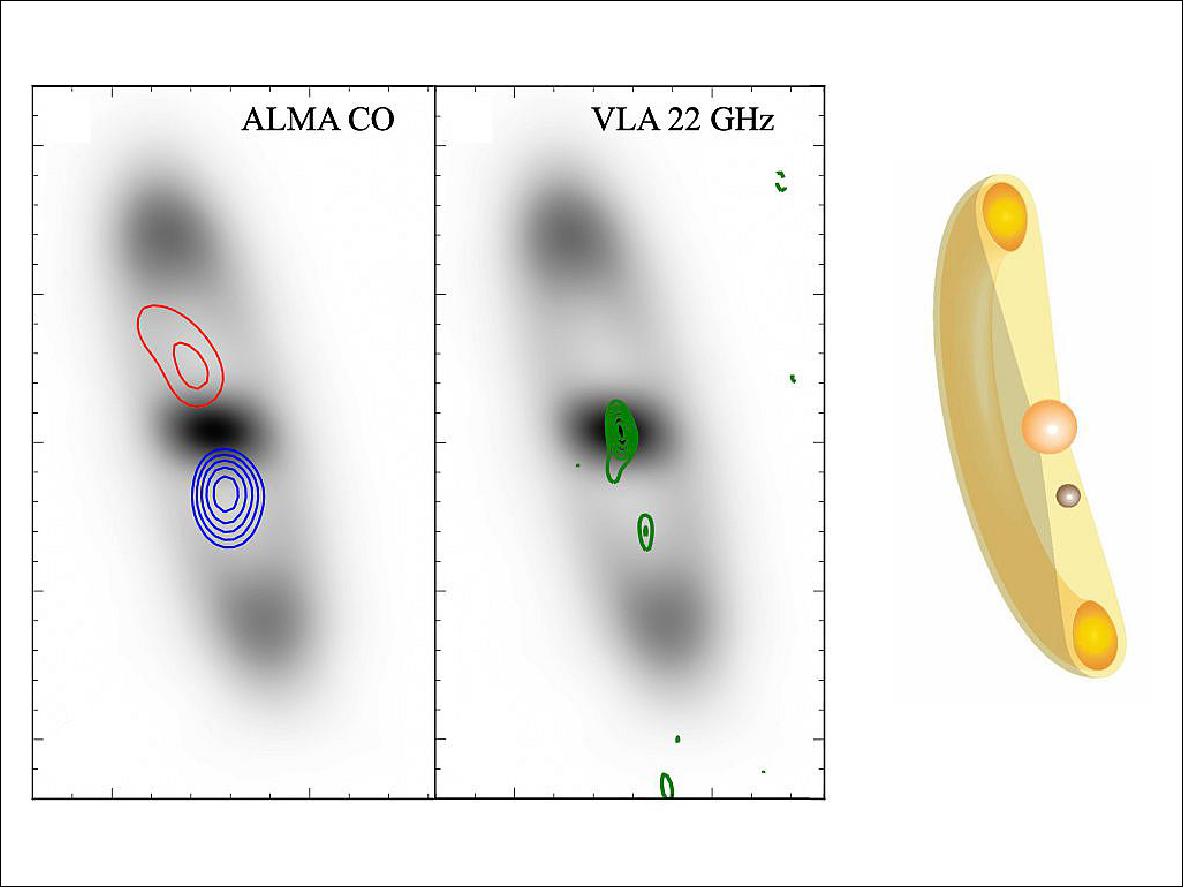
• October 21, 2020: New radio images from the Atacama Large Millimeter/submillimeter Array (ALMA) show for the first time the direct effect of volcanic activity on the atmosphere of Jupiter’s moon Io. 75)
- Io is the most volcanically active moon in our solar system. It hosts more than 400 active volcanoes, spewing out sulfur gases that give Io its yellow-white-orange-red colors when they freeze out on its surface.
- Although it is extremely thin – about a billion times thinner than Earth’s atmosphere – Io has an atmosphere that can teach us about Io’s volcanic activity and provide us a window into the exotic moon’s interior and what is happening below its colorful crust.
- Previous research has shown that Io’s atmosphere is dominated by sulfur dioxide gas, ultimately sourced from volcanic activity. “However, it is not known which process drives the dynamics in Io’s atmosphere,” said Imke de Pater of the University of California, Berkeley. “Is it volcanic activity, or gas that has sublimated (transitioned from solid to gaseous state) from the icy surface when Io is in sunlight?“
- To distinguish between the different processes that give rise to Io’s atmosphere, a team of astronomers used ALMA to make snapshots of the moon when it passed in and out of Jupiter’s shadow (they call this an “eclipse”).
- “When Io passes into Jupiter’s shadow, and is out of direct sunlight, it is too cold for sulfur dioxide gas, and it condenses onto Io’s surface. During that time we can only see volcanically-sourced sulfur dioxide. We can therefore see exactly how much of the atmosphere is impacted by volcanic activity,” explained Statia Luszcz-Cook from Columbia University, New York.
- Thanks to ALMA’s exquisite resolution and sensitivity, the astronomers could, for the first time, clearly see the plumes of sulfur dioxide (SO2) and sulfur monoxide (SO) rise up from the volcanoes. Based on the snapshots, they calculated that active volcanoes directly produce 30-50 percent of Io’s atmosphere.
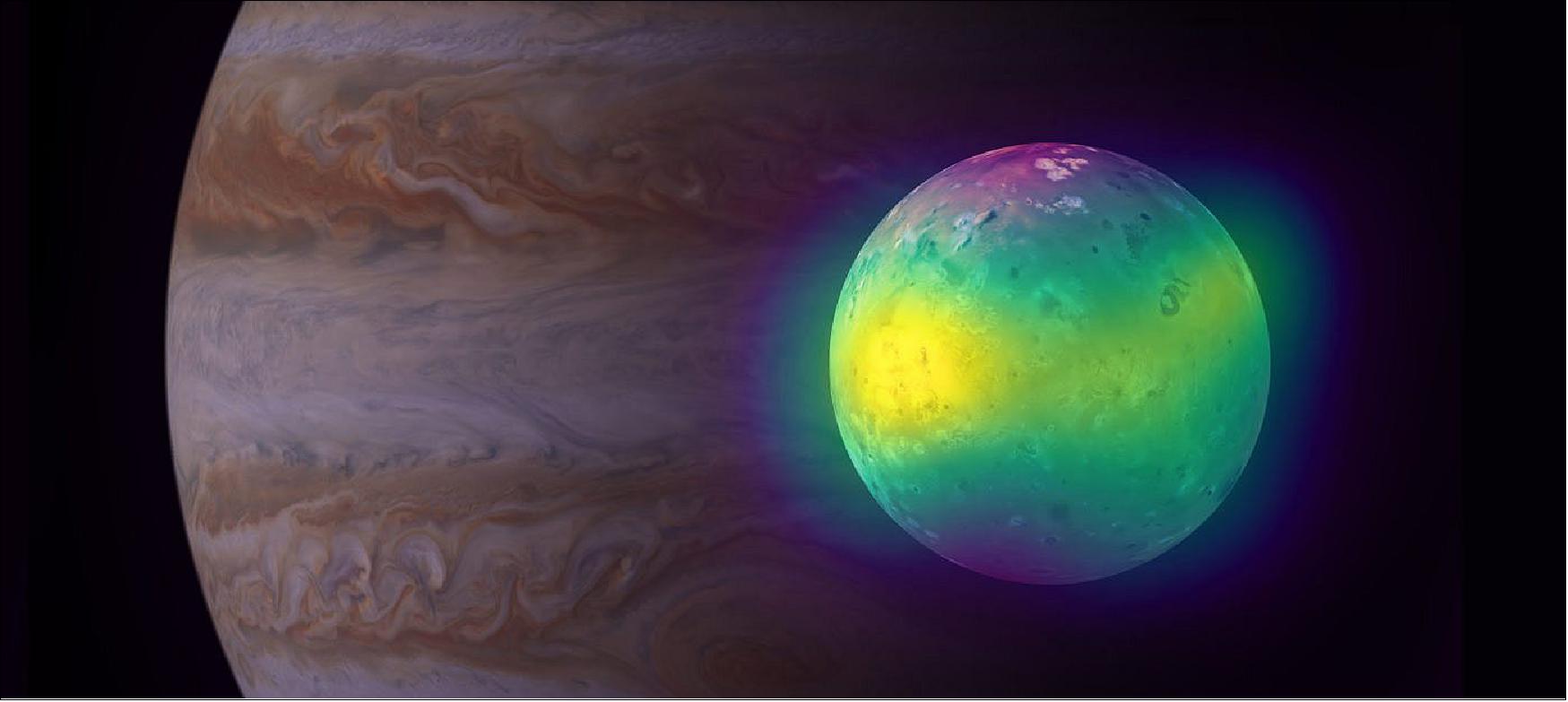
- The ALMA images also showed a third gas coming out of volcanoes: potassium chloride (KCl). “We see KCl in volcanic regions where we do not see SO2 or SO,” said Luszcz-Cook. “This is strong evidence that the magma reservoirs are different under different volcanoes.”
- Io is volcanically active due to a process called tidal heating. Io orbits Jupiter in an orbit that is not quite circular and, like our Moon always faces the same side of Earth, so does the same side of Io always face Jupiter. The gravitational pull of Jupiter’s other moons Europa and Ganymede causes tremendous amounts of internal friction and heat, giving rise to volcanoes such as Loki Patera, which spans more than 200 kilometers (124 miles) across. “By studying Io’s atmosphere and volcanic activity we learn more about not only the volcanoes themselves, but also the tidal heating process and Io’s interior,” added Luszcz-Cook.
- A big unknown remains the temperature in Io’s lower atmosphere. In future research, the astronomers hope to measure this with ALMA. “To measure the temperature of Io’s atmosphere, we need to obtain a higher resolution in our observations, which requires that we observe the moon for a longer period of time. We can only do this when Io is in sunlight since it does not spend much time in eclipse,” said de Pater. “During such an observation, Io will rotate by tens of degrees. We will need to apply software that helps us make un-smeared images. We have done this previously with radio images of Jupiter made with ALMA and the Very Large Array (VLA).”
- Imke de Pater and Statia Luszcz-Cook worked with Patricio Rojo of the Universidad de Chile, Erin Redwing of the University of California, Berkeley, Katherine de Kleer of the California Institute of Technology (Caltech), and Arielle Moullet of SOFIA/USRA in California.
- This research titled “ALMA Observations of Io Going into and Coming out of Eclipse” has been accepted for publication in The Planetary Science Journal. Preprint: https://arxiv.org/abs/2009.07729
• October 7, 2020: Astronomers have found compelling evidence that planets start to form while infant stars are still growing. The high-resolution image obtained with the Atacama Large Millimeter/submillimeter Array (ALMA) shows a young proto-stellar disk with multiple gaps and rings of dust. This new result, just published in Nature, shows the youngest and most detailed example of dust rings acting as cosmic cradles, where the seeds of planets form and take hold. 76) 77)
- An international team of scientists led by Dominique Segura-Cox at the Max Planck Institute for Extraterrestrial Physics (MPE) in Germany targeted the proto-star IRS 63 with the ALMA radio observatory. This system is 470 light years from Earth and located deep within the dense L1709 interstellar cloud in the Ophiuchus constellation. Proto-stars as young as IRS 63 are still swaddled in a large and massive blanket of gas and dust called an envelope, and the proto-star and disk feed from this reservoir of material.
![Figure 49: The dense L1709 region of the Ophiuchus Molecular Cloud, mapped by the Herschel Space Telescope, which surrounds and ... [more], image credit: MPE, D. Segura-Cox, Herschel data from ESA/Herschel/SPIRE/PACS/D. Arzoumanian)](https://www.eoportal.org/ftp/satellite-missions/a/Alma_300622/Alma_Auto3C.jpeg)
- In systems older than 1,000,000 years, after the proto-stars have finished gathering most of their mass, rings of dust have been previously detected in great numbers. IRS 63 is different: at under 500,000 years old, it is less than half the age of other young stars with dust rings and the proto-star will still grow significantly in mass. “The rings in the disk around IRS 63 are so young,” emphasizes Segura-Cox. “We used to think that stars entered adulthood first and then were the mothers of planets that came later. But now we see that proto-stars and planets grow and evolve together from early times, like siblings.”
- Planets face some serious obstacles during their earliest stages of formation. They have to grow from tiny dust particles, smaller than household dust here on Earth. “The rings in the disk of IRS 63 are vast pile-ups of dust, ready to combine into planets,” notes co-author Anika Schmiedeke at MPE. However, even after the dust clumps together to form a planet embryo, the still-forming planet could disappear by spiraling inwards and being consumed by the central proto-star. If planets do start to form very early and at large distances from the proto-star, they may better survive this process.
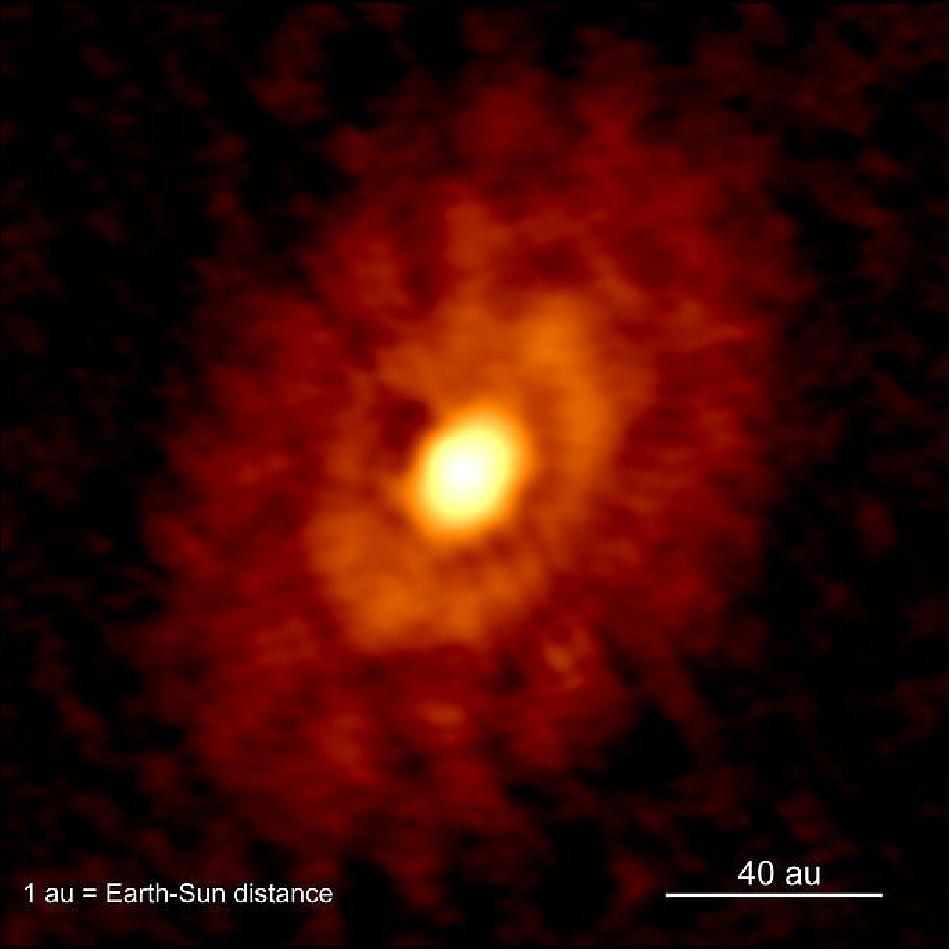
- The team of researchers found that there is about 0.5 Jupiter masses of dust in the young disk of IRS 63 further than 20 au from its center (at a distance similar to the Uranus orbit in our solar system). That is not counting the amount of gas, which could add up to 100 times more material. It takes at least 0.03 Jupiter masses of solid material to form a planet core that will efficiently accrete gas and grow to form a giant gas planet. Team member Jaime Pineda at MPE adds, “These results show that we must focus on the youngest systems to truly understand planet formation.” For example, there is growing evidence that Jupiter may have actually formed much farther out in the Solar System, beyond the Neptune orbit, and then migrated inwards to its present location. Similarly, the dust surrounding IRS 63 shows that there is enough material far from the proto-star and at a stage young enough that there is a chance for this Solar System analogue to form planets in the way that Jupiter is suspected to have formed.
- “The size of the disk is very similar to our own Solar System,” Segura-Cox explains. “Even the mass of the proto-star is just a little less than our Sun's. Studying such young planet-forming disks around proto-stars can give us important insights into our own origins.”
![Figure 51: The rings and gaps in the IRS 63 dust disk compared to a sketch of orbits in our own Solar System at the same scale ... [more], image credit: MPE, D. Segura-Cox)](https://www.eoportal.org/ftp/satellite-missions/a/Alma_300622/Alma_Auto3A.jpeg)
• September 18, 2020: Astronomers used the Atacama Large Millimeter/submillimeter Array (ALMA) to observe a set of stellar winds around aging stars and present an explanation for the mesmerizing shapes of planetary nebulae. Contrary to common consensus, the team found that stellar winds are not spherical but have a form similar to that of planetary nebulae. The team concludes that interaction with an accompanying star or exoplanet shapes both the stellar winds and planetary nebulae. The findings were published in Science. 78) 79) 80)
- Dying stars swell and cool to eventually become red giants. They produce stellar winds, flows of particles that the star expels, which causes them to lose mass. Because detailed observations were lacking, astronomers have always assumed that these winds were spherical, like the stars they surround. As the star evolves further, it heats up again, and the stellar radiation causes the expanding ejected layers of stellar material to glow, forming a planetary nebula.
- For centuries, astronomers were in the dark about the extraordinary variety of colorful shapes observed in planetary nebulas. The nebulae all seem to have a certain symmetry but are rarely round. “The Sun – which will ultimately become a red giant – is as round as a billiard ball, so we wondered: how can such a star produce all these different shapes?” says corresponding author Leen Decin (KU Leuven).
- Her team observed stellar winds around cool red giant stars with the ALMA observatory in Chile, the world’s largest radio telescope. For the first time, they gathered an extensive, detailed collection of observations. Each of them made using the same method, crucial to compare the data, and exclude biases directly.
- What the astronomers saw surprised them. “We noticed these winds are anything but symmetrical or round,” Professor Decin says. “Some of them are quite similar in shape to planetary nebulae.”
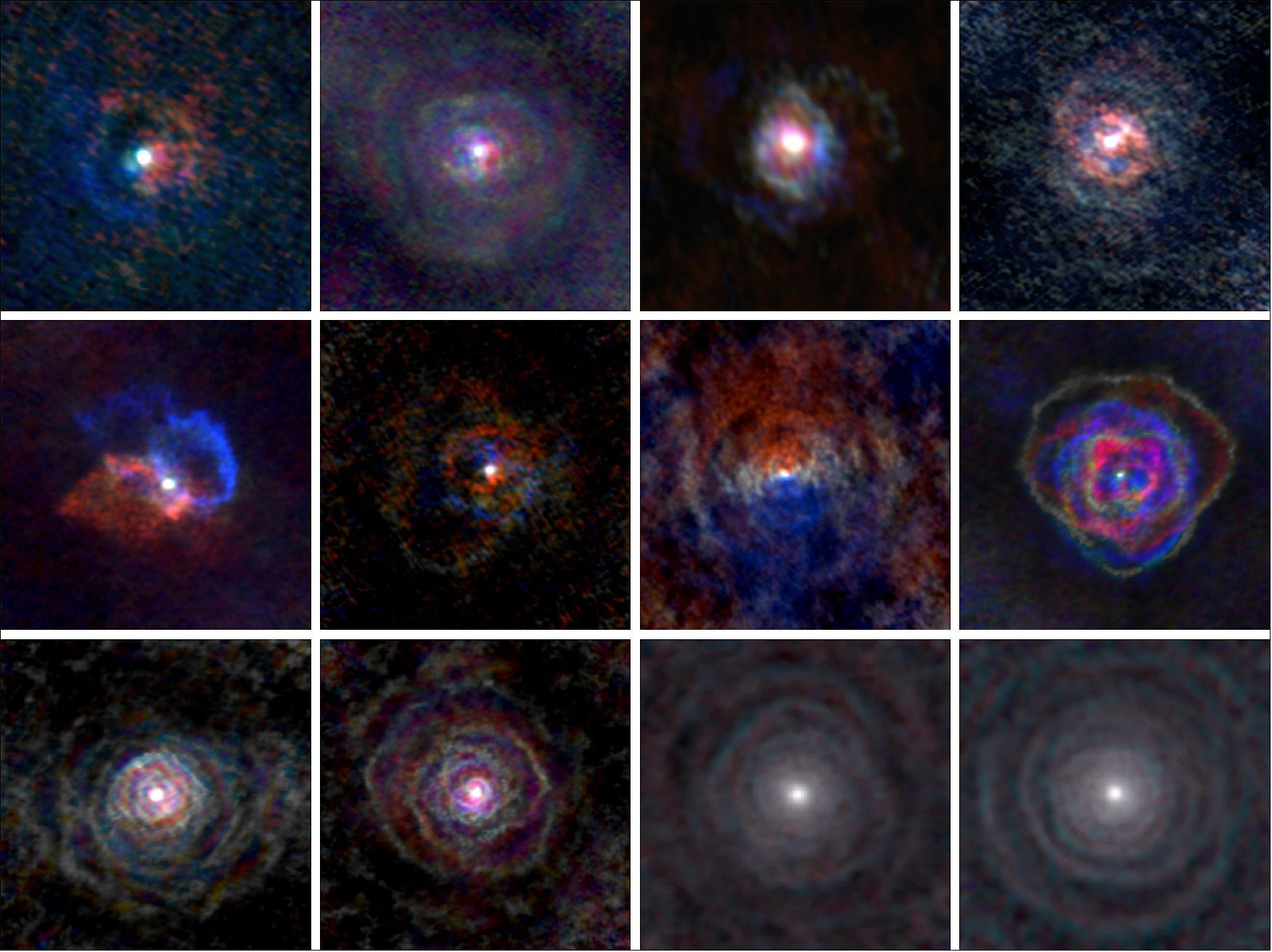
- The researchers could even identify different categories of shapes. “Some stellar winds were disk-shaped, others contained spirals, and we identified cones in a third group.” This is a clear indication that the shapes weren’t created randomly. The team realized that other low-mass stars or even heavy planets in the dying star’s vicinity were causing the different patterns. These companions are too small and dim to detect directly. “Just like how a spoon that you stir in a cup of coffee with some milk can create a spiral pattern, the companion sucks material towards it as it revolves around the star and shapes the stellar wind,” Decin explains.
- The team put this theory into models, and indeed: the shape of the stellar winds can be explained by the companions surrounding them. The rate at which the cool evolved star is losing its mass due to the stellar wind is an important parameter.
- Up until now, calculations about the evolution of stars were based on the assumption that aging Sun-like stars have spherical stellar winds. “Our findings change a lot. Since the complexity of stellar winds was not accounted for in the past, any previous mass-loss rate estimate of old stars could be wrong by up to a factor of 10.” The team is now doing further research to see how this might impact calculations of other crucial characteristics of stellar and galactic evolution.
- The study also helps envision what the Sun might look like when it dies in 7000 million years. “Jupiter or even Saturn – because they have such a big mass – are going to influence whether the Sun spends its last millennia at the heart of a spiral, a butterfly, or any of the other entrancing shapes we see in planetary nebulae today,” Decin notes. “Our calculations now indicate that a weak spiral will form in the stellar wind of the old dying Sun.”
- “We were very excited when we explored the first images,” says co-author Miguel Montargès (KU Leuven). “Each star, which was only a number before, became an individual by itself. Now, to us, they have their own identity. This is the magic of having high-precision observations: stars are no longer just points anymore.”
- The study is part of the ATOMIUM project, which aims to learn more about the physics and chemistry of old stars. “Cool aging stars are considered boring, old and simple, but we now prove that they are not: they tell the story of what comes after. It took us some time to realize that stellar winds can have the shape of rose petals (see, for example, the stellar wind of R Aquilae). But, as Antoine de Saint-Exupéry said in his book Le Petit Prince: ‘C’est le temps que tu as perdu pour ta rose, qui fait ta rose si importante’ – ‘It’s the time you spent on your rose that makes your rose so important,'” Decin concludes.
• August 12, 2020: Astronomers using the ALMA (Atacama Large Millimeter/submillimeter Array), in which the European Southern Observatory (ESO) is a partner, have revealed an extremely distant and therefore very young galaxy that looks surprisingly like our Milky Way. The galaxy is so far away its light has taken more than 12 billion years to reach us: we see it as it was when the Universe was just 1.4 billion years old. It is also surprisingly unchaotic, contradicting theories that all galaxies in the early Universe were turbulent and unstable. This unexpected discovery challenges our understanding of how galaxies form, giving new insights into the past of our Universe. 81)
- “This result represents a breakthrough in the field of galaxy formation, showing that the structures that we observe in nearby spiral galaxies and in our Milky Way were already in place 12 billion years ago,” says Francesca Rizzo, PhD student from the Max Planck Institute for Astrophysics in Germany, who led the research published today in Nature. While the galaxy the astronomers studied, called SPT0418-47, doesn’t appear to have spiral arms, it has at least two features typical of our Milky Way: a rotating disc and a bulge, the large group of stars packed tightly around the galactic center. This is the first time a bulge has been seen this early in the history of the Universe, making SPT0418-47 the most distant Milky Way look-alike.
- “The big surprise was to find that this galaxy is actually quite similar to nearby galaxies, contrary to all expectations from the models and previous, less detailed, observations,” says co-author Filippo Fraternali, from the Kapteyn Astronomical Institute, University of Groningen in the Netherlands. In the early Universe, young galaxies were still in the process of forming, so researchers expected them to be chaotic and lacking the distinct structures typical of more mature galaxies like the Milky Way.
- Studying distant galaxies like SPT0418-47 is fundamental to our understanding of how galaxies formed and evolved. This galaxy is so far away we see it when the Universe was just 10% of its current age because its light took 12 billion years to reach Earth. By studying it, we are going back to a time when these baby galaxies were just beginning to develop.
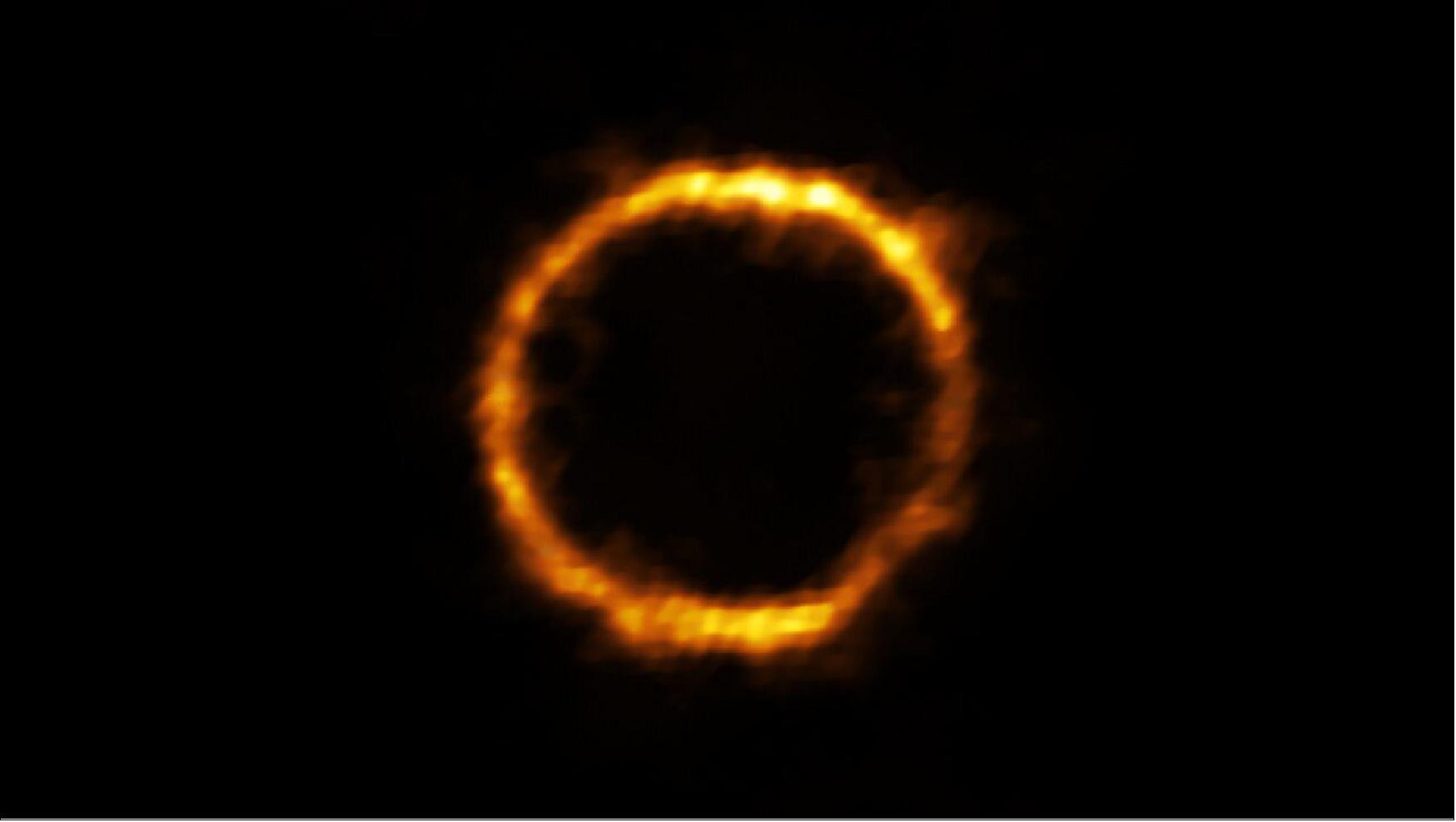
- Because these galaxies are so far away, detailed observations with even the most powerful telescopes are almost impossible as the galaxies appear small and faint. The team overcame this obstacle by using a nearby galaxy as a powerful magnifying glass — an effect known as gravitational lensing — allowing ALMA to see into the distant past in unprecedented detail. In this effect, the gravitational pull from the nearby galaxy distorts and bends the light from the distant galaxy, causing it to appear misshapen and magnified.
- The gravitationally lensed, distant galaxy appears as a near-perfect ring of light around the nearby galaxy, thanks to their almost exact alignment. The research team reconstructed the distant galaxy’s true shape and the motion of its gas from the ALMA data using a new computer modelling technique. “When I first saw the reconstructed image of SPT0418-47 I could not believe it: a treasure chest was opening,” says Rizzo.
- “What we found was quite puzzling; despite forming stars at a high rate, and therefore being the site of highly energetic processes, SPT0418-47 is the most well-ordered galaxy disc ever observed in the early Universe,” stated co-author Simona Vegetti, also from the Max Planck Institute for Astrophysics. “This result is quite unexpected and has important implications for how we think galaxies evolve." The astronomers note, however, that even though SPT0418-47 has a disc and other features similar to those of spiral galaxies we see today, they expect it to evolve into a galaxy very different from the Milky Way, and join the class of elliptical galaxies, another type of galaxies that, alongside the spirals, inhabit the Universe today.
- This unexpected discovery suggests the early Universe may not be as chaotic as once believed and raises many questions on how a well-ordered galaxy could have formed so soon after the Big Bang. This ALMA finding follows the earlier discovery announced in May of a massive rotating disc seen at a similar distance. SPT0418-47 is seen in finer detail, thanks to the lensing effect, and has a bulge in addition to a disc, making it even more similar to our present-day Milky Way than the one studied previously.
- Future studies, including with ESO’s Extremely Large Telescope, will seek to uncover how typical these ‘baby’ disc galaxies really are and whether they are commonly less chaotic than predicted, opening up new avenues for astronomers to discover how galaxies evolved. 82)
• July 9, 2020: At this time, the COVID-19 pandemic continues to affect the lives of ALMA staff and users around the world. Although in some of the ALMA regions the situation is slowly improving, in other regions, including Chile, the evolution of the outbreak remains highly uncertain. 83)
- Because of the on-going situation in Chile, ALMA operations unfortunately remain suspended. ALMA staff continue to monitor the situation very carefully and work on the development of detailed plans for the return to operations, which will be initiated when the situation allows. We will keep updating the user community on the developments.
- Northern Chile was recently hit by a magnitude 6.8 earthquake. Fortunately this caused no injuries to ALMA staff and no serious damage at the ALMA site. This was followed by extremely high winds, that led to some minor damage at the ALMA OSF (Operations Support Facility).
- As always, the ALMA Regional Centers provide support to their respective communities, and can assist in the analysis of your data and help with archive research projects. If you have any questions on this, or comments or concerns related to the situation at ALMA, please contact the ALMA helpdesk.
• July 2, 2020: Astronomers created a stunning new image showing celestial fireworks in star cluster G286.21+0.17. 84)
- Most stars in the universe, including our Sun, were born in massive star clusters. These clusters are the building blocks of galaxies, but their formation from dense molecular clouds is still largely a mystery.
- The image of cluster G286.21+0.17 (Figure 54) is a multiwavelength mosaic. The cluster is located in the Carina region of our galaxy, about 8000 light-years away.
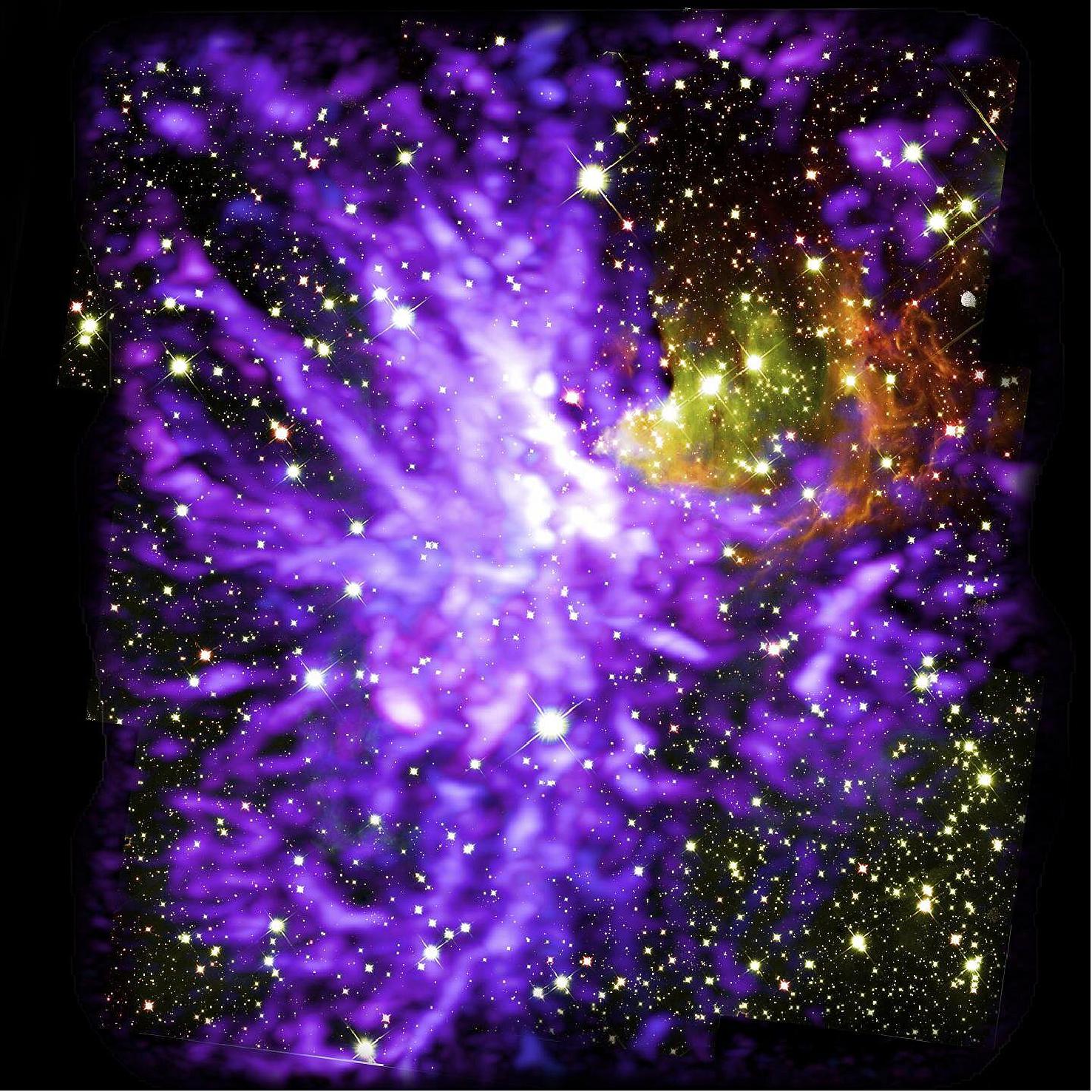
- Dense clouds made of molecular gas (purple ‘fireworks streamers’) are revealed by ALMA. The telescope observed the motions of turbulent gas falling into the cluster, forming dense cores that ultimately create individual stars.
- The stars in the image are revealed by their infrared light, as seen by Hubble, including a large group of stars bursting out from one side of the cloud. The powerful winds and radiation from the most massive of these stars are blasting away the molecular clouds, leaving faint wisps of glowing, hot dust (shown in yellow and red).
- “This image shows stars in various stages of formation within this single cluster,” said Yu Cheng of the University of Virginia in Charlottesville, Virginia, and lead author of two papers published in The Astrophysical Journal. 85) 86)
- Hubble revealed about a thousand newly-formed stars with a wide range of masses. Additionally, ALMA showed that there is a lot more mass present in dense gas that still has to undergo collapse. “Overall the process may take at least a million years to complete,” Cheng added.
- “This illustrates how dynamic and chaotic the process of star birth is,” said co-author Jonathan Tan of Chalmers University in Sweden and the University of Virginia and principal investigator of the project. “We see competing forces in action: gravity and turbulence from the cloud on one side, and stellar winds and radiation pressure from the young stars on the other. This process sculpts the region. It is amazing to think that our own Sun and planets were once part of such a cosmic dance.”
- “The phenomenal resolution and sensitivity of ALMA are evident in this stunning image of star formation,” said Joe Pesce, NSF Program Officer for NRAO/ALMA. “Combined with the Hubble Space Telescope data we can clearly see the power of multiwavelength observations to help us understand these fundamental universal processes.”
• July 6, 2020: The molecular gas in galaxies is organized into a hierarchy of structures. The molecular material in giant molecular gas clouds travels along intricate networks of filamentary gas lanes towards the congested centers of gas and dust where it is compressed into stars and planets, much like the millions of people commuting to cities for work around the world. To better understand this process, a team of astronomers led by Jonathan Henshaw at Max Planck Institute for Astronomy (MPIA) have measured the motion of gas flowing from galaxy scales down to the scales of the gas clumps within which individual stars form. Their results show that the gas flowing through each scale is dynamically interconnected: while star and planet formation occurs on the smallest scales, this process is controlled by a cascade of matter flows that begin on galactic scales. These results are published today in the scientific journal Nature Astronomy. 87) 88)
- The scientists use data from the following observatories: Atacama Large Millimeter/submillimeter Array (ALMA), Morita Atacama Compact Array, Five College Radio Astronomy Observatory (FCRAO), Institut de Radioastronomie Millimétrique (IRAM) Plateau de Bure Interferometer, Mopra Radio Telescope, and HSO (Herschel Space Observatory).
- The molecular gas in galaxies is set into motion by physical mechanisms such as galactic rotation, supernova explosions, magnetic fields, turbulence, and gravity, shaping the structure of the gas. Understanding how these motions directly impact star and planet formation is difficult, because it requires quantifying gas motion over a huge range in spatial scale, and then linking this motion to the physical structures we observe. Modern astrophysical facilities now routinely map huge areas of the sky, with some maps containing millions of pixels, each with hundreds to thousands of independent velocity measurements. As a result, measuring these motions is both scientifically and technologically challenging.
- In order to address these challenges, an international team of researchers led by Jonathan Henshaw at the MPIA in Heidelberg set out to measure gas motions throughout a variety of different environments using observations of the gas in the Milky Way and a nearby galaxy. They detect these motions by measuring the apparent change in the frequency of light emitted by molecules caused by the relative motion between the source of the light and the observer; a phenomenon known as the Doppler effect. By applying novel software designed by Henshaw and Ph.D. student Manuel Riener (a co-author on the paper; also at MPIA), the team were able to analyze millions of measurements. “This method allowed us to visualize the interstellar medium in a new way,” says Henshaw.
- The researchers found that cold molecular gas motions appear to fluctuate in velocity, reminiscent in appearance of waves on the surface of the ocean. These fluctuations represent gas motion. “The fluctuations themselves weren’t particularly surprising, we know that the gas is moving,” says Henshaw. Steve Longmore, co-author of the paper, based at Liverpool John Moores University, adds, “What surprised us was how similar the velocity structure of these different regions appeared. It didn’t matter if we were looking at an entire galaxy or an individual cloud within our own galaxy, the structure is more or less the same.”
- To better understand the nature of the gas flows, the team selected several regions for close examination, using advanced statistical techniques to look for differences between the fluctuations. By combining a variety of different measurements, the researchers were able to determine how the velocity fluctuations depend on the spatial scale.
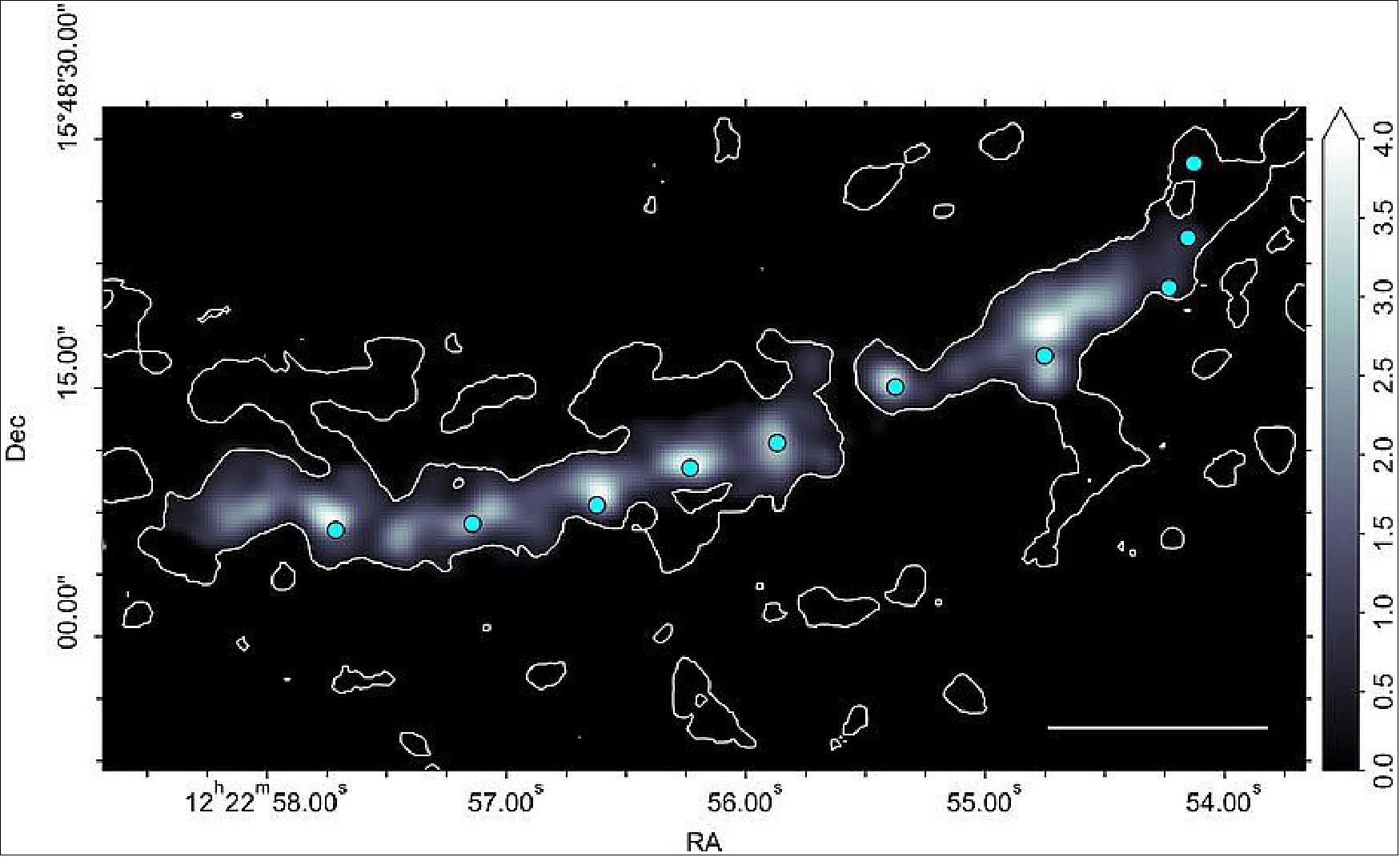
- “A neat feature of our analysis techniques is that they are sensitive to periodicity,” explains Henshaw. “If there are repeating patterns in your data, such as equally spaced giant molecular clouds along a spiral arm, we can directly identify the scale on which the pattern repeats.” The team identified three filamentary gas lanes, which, despite tracing vastly different scales, all seemed to show structure that was roughly equidistantly spaced along their crests, like beads on a string, whether it was giant molecular clouds along a spiral arm or tiny “cores” forming stars along a filament.
- The team discovered that the velocity fluctuations associated with equidistantly spaced structure all showed a distinctive pattern. “The fluctuations look like waves oscillating along the crests of the filaments, they have a well-defined amplitude and wavelength,” says Henshaw adding, “The periodic spacing of the giant molecular clouds on large-scales or individual star-forming cores on small-scales is probably the result of their parent filaments becoming gravitationally unstable. We believe that these oscillatory flows are the signature of gas streaming along spiral arms or converging towards the density peaks, supplying new fuel for star formation.”
- In contrast, the team found that the velocity fluctuations measured throughout giant molecular clouds, on scales intermediate between entire clouds and the tiny cores within them, show no obvious characteristic scale. Diederik Kruijssen, co-author of the paper based at Heidelberg University explains: “The density and velocity structures that we see in giant molecular clouds are ‘scale-free’, because the turbulent gas flows generating these structures form a chaotic cascade, revealing ever smaller fluctuations as you zoom in – much like a Romanesco broccoli, or a snowflake. This scale-free behavior takes place between two well-defined extremes: the large scale of the entire cloud, and the small scale of the cores forming individual stars. We now find that these extremes have well-defined characteristic sizes, but in between them chaos rules.”
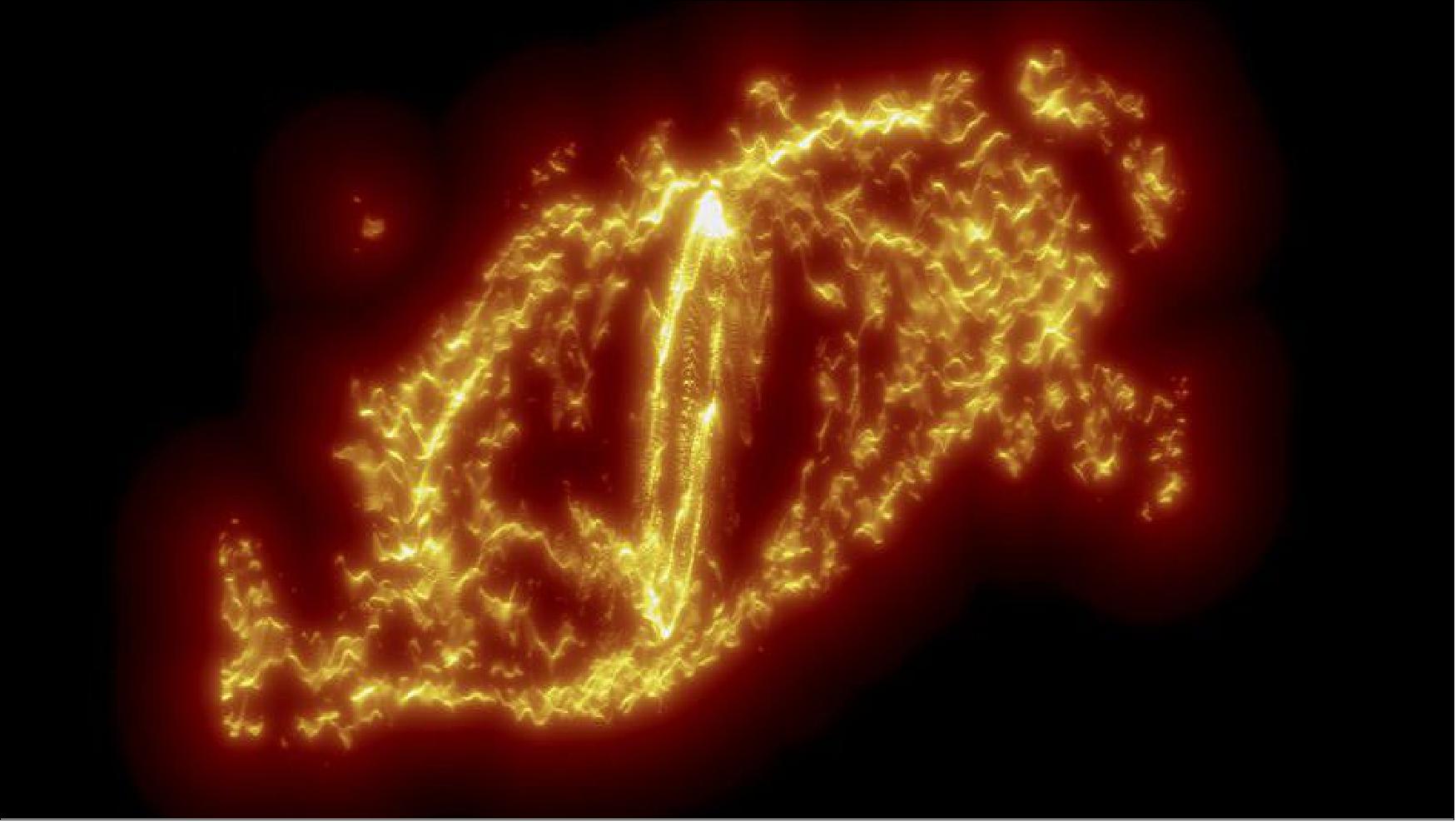
• June 16, 2020: An international team of astronomers has created the most detailed map yet of the atmosphere of the red supergiant star Antares. The unprecedented sensitivity and resolution of both the Atacama Large Millimeter/submillimeter Array (ALMA) and the National Science Foundation’s Karl G. Jansky Very Large Array (VLA) revealed the size and temperature of Antares’ atmosphere from just above the star’s surface, throughout its chromosphere, and all the way out to the wind region. 89) 90)
- Red supergiant stars, like Antares and its more well-known cousin Betelgeuse, are huge, relatively cold stars at the end of their lifetime. They are on their way to run out of fuel, collapse, and become supernovae. Through their vast stellar winds, they launch heavy elements into space, thereby playing an important role in providing the essential building blocks for life in the universe. But it is a mystery how these enormous winds are launched. A detailed study of the atmosphere of Antares, the closest supergiant star to Earth, provides a crucial step towards an answer.
- The ALMA and VLA map of Antares is the most detailed radio map yet of any star, other than the Sun. ALMA observed Antares close to its surface (its optical photosphere) in shorter wavelengths, and the longer wavelengths observed by the VLA revealed the star’s atmosphere further out. As seen in visible light, Antares’ diameter is approximately 700 times larger than the Sun. But when ALMA and the VLA revealed its atmosphere in radio light, the supergiant turned out to be even more gigantic.
- “The size of a star can vary dramatically depending on what wavelength of light it is observed with,” explained Eamon O’Gorman of the Dublin Institute for Advanced Studies in Ireland and lead author of the study published in the June 16 edition of the journal Astronomy & Astrophysics. “The longer wavelengths of the VLA revealed the supergiant’s atmosphere out to nearly 12 times the star’s radius.”
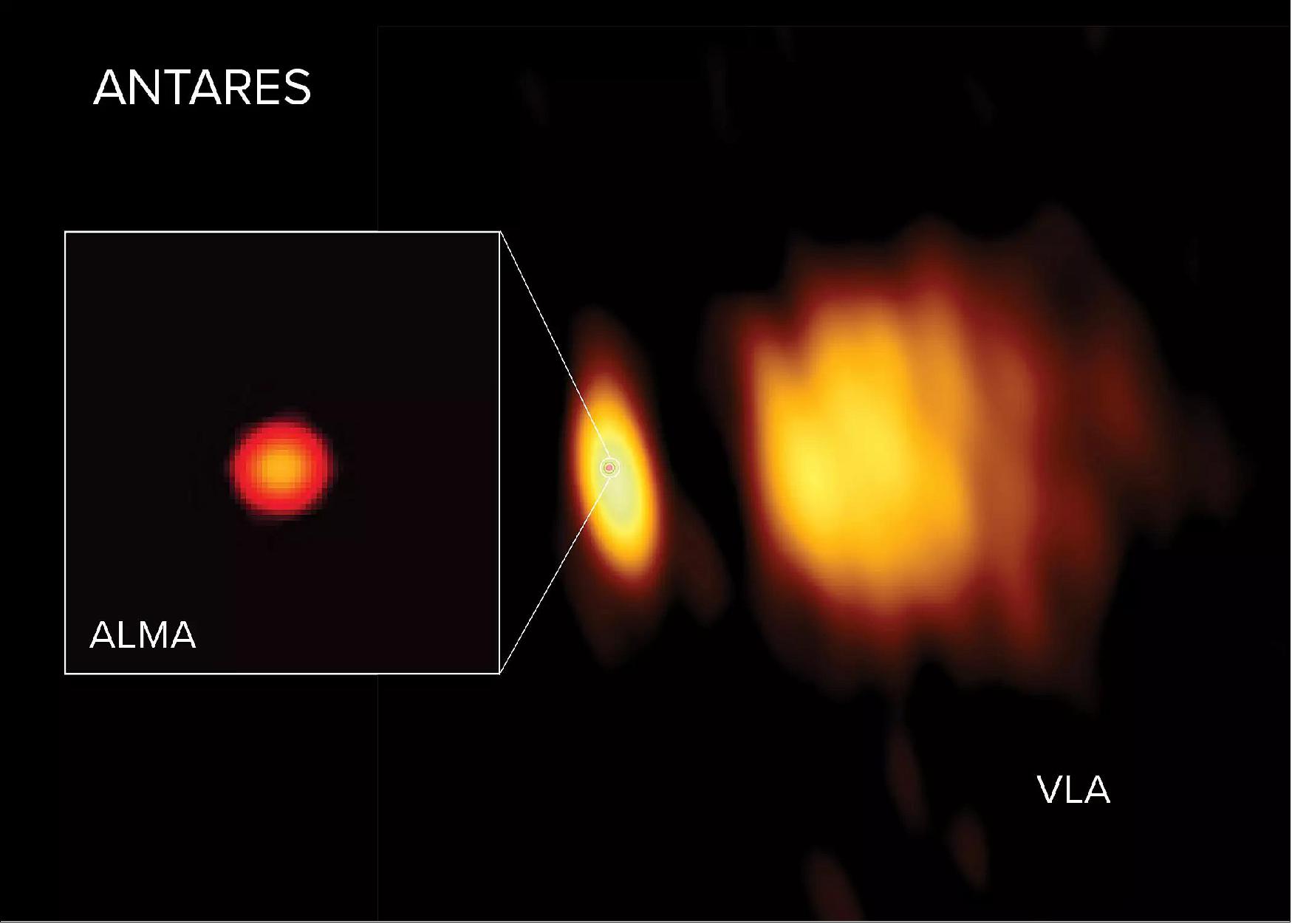
- The radio telescopes measured the temperature of most of the gas and plasma in Antares’ atmosphere. Most noticeable was the temperature in the chromosphere. This is the region above the star’s surface that is heated up by magnetic fields and shock waves created by the vigorous roiling convection at the stellar surface – much like the bubbling motion in a pot of boiling water. Not much is known about chromospheres, and this is the first time that this region has been detected in radio waves.
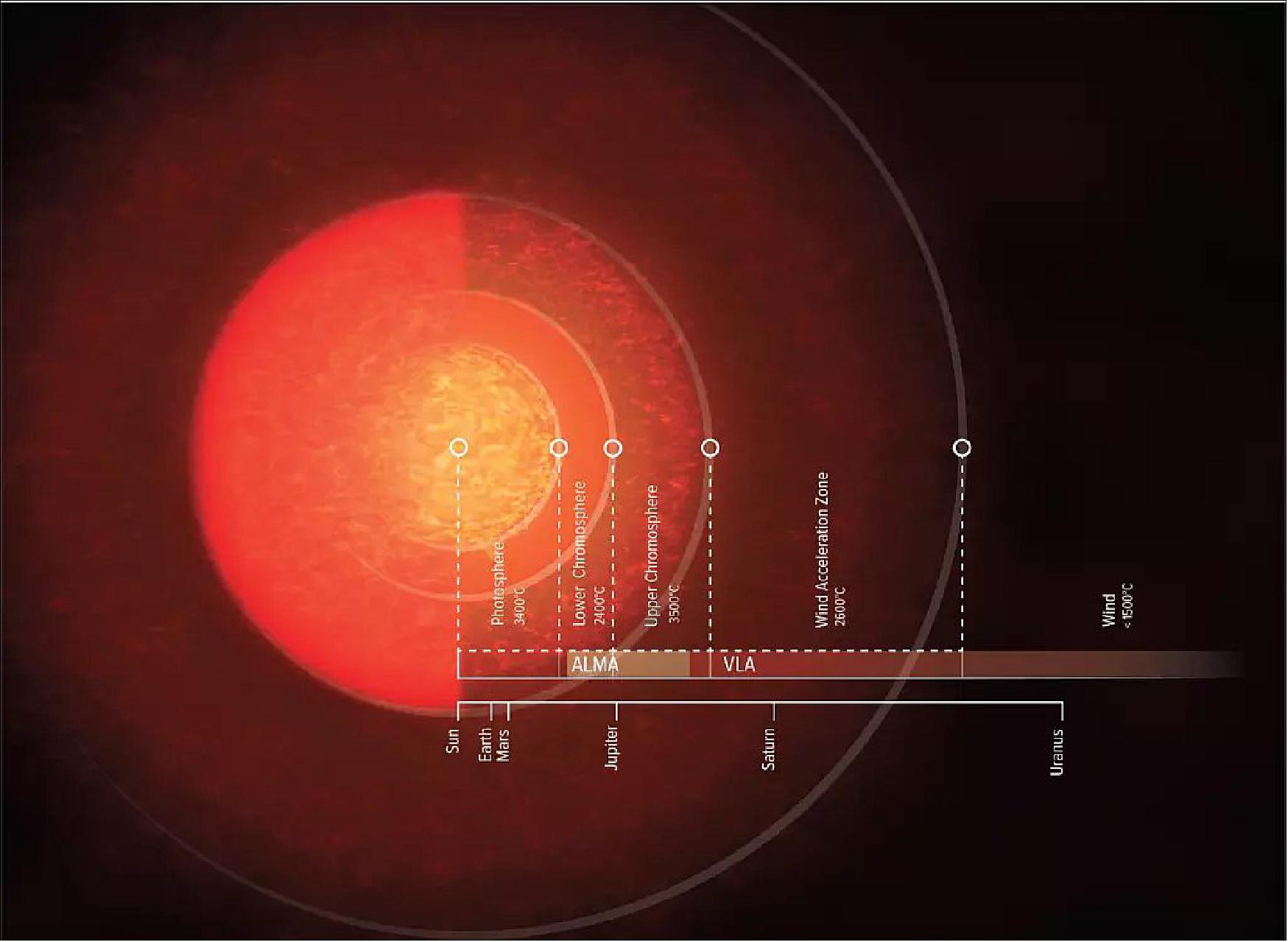
- Thanks to ALMA and the VLA, the scientists discovered that the star’s chromosphere extends out to 2.5 times the star’s radius (our Sun’s chromosphere is only 1/200th of its radius). They also found that the temperature of the chromosphere is lower than previous optical and ultraviolet observations have suggested. The temperature peaks at 3,500 degrees Celsius (6,400 degrees Fahrenheit), after which it gradually decreases. As a comparison, the Sun’s chromosphere reaches temperatures of almost 20,000 degrees Celsius.
- “We found that the chromosphere is ‘lukewarm’ rather than hot, in stellar temperatures,” said O’Gorman. “The difference can be explained because our radio measurements are a sensitive thermometer for most of the gas and plasma in the star’s atmosphere, whereas past optical and ultraviolet observations were only sensitive to very hot gas and plasma.”
- “We think that red supergiant stars, such as Antares and Betelgeuse, have an inhomogeneous atmosphere,” said co-author Keiichi Ohnaka of the Universidad Católica del Norte in Chile who previously observed Antares’ atmosphere in infrared light. “Imagine that their atmospheres are a painting made out of many dots of different colors, representing different temperatures. Most of the painting contains dots of the lukewarm gas that radio telescopes can see, but there are also cold dots that only infrared telescopes can see, and hot dots that UV telescopes see. At the moment we can’t observe these dots individually, but we want to try that in future studies.”
- In the ALMA and VLA data, astronomers for the first time saw a clear distinction between the chromosphere and the region where winds start to form. In the VLA image, a huge wind is visible, ejected from Antares and lit up by its smaller but hotter companion star Antares B.
- “When I was a student, I dreamt of having data like this,” said co-author Graham Harper of the University of Colorado, Boulder. “Knowing the actual sizes and temperatures of the atmospheric zones gives us a clue of how these huge winds start to form and how much mass is being ejected.”
- “Our innate understanding of the night sky is that stars are just points of light. The fact we can map the atmospheres of these supergiant stars in detail, is a true testament to technological advances in interferometry. These tour de force observations bring the universe close, right into our own backyard,” said Chris Carilli of the National Radio Astronomy Observatory, who was involved in the first observations of Betelgeuse at multiple radio wavelengths with the VLA in 1998.
• June 9, 2020: High-resolution observations of a young star forming system clearly unveil a pair of protostars at their earliest stages of evolution deeply embedded within the source IRAS 16293-2422 in the Ophiuchus molecular cloud. The team led by the MPE (Max Planck Institute for Extraterrestrial Physics) in Garching, Germany, used the ALMA interferometer not only to pin down the source configuration, but also to measure the gas and stellar kinematics, determining the mass of the young binary. The two close protostars are somewhat heavier than previously thought and they revolve around each other once in about 400 years. 91)
- The system called IRAS 16293-2422 is one of the brightest star-forming regions in our neighborhood. It is located in the Ophiuchus molecular cloud at a distance of about 460 light-years and has been widely studied, also because it shows strong emission of numerous complex organic molecules, building blocks of pre-biotic species. However, until now the detailed configuration of the region was unclear, with observations at different wavelengths showing multiple compact sources at slightly different locations. This confusion was due to the large amount of material in front of the nascent protostars, expected at these earliest stages of formation.
- An international team of astronomers led by the Max Planck Institute for Extraterrestrial Physics (MPE) has now obtained high-resolution radio observations with the ALMA interferometer, which clearly reveals two compact sources A1 and A2 in addition to the well-known protostar B (see Figure 59). “Our observations confirm the location of the two close protostars and reveal that each is surrounded by a very small dust disk. Both, in turn, are in turn embedded in a large amount of material showing complex patterns” remarks María José Maureira from MPE, the lead author of the study. 92)
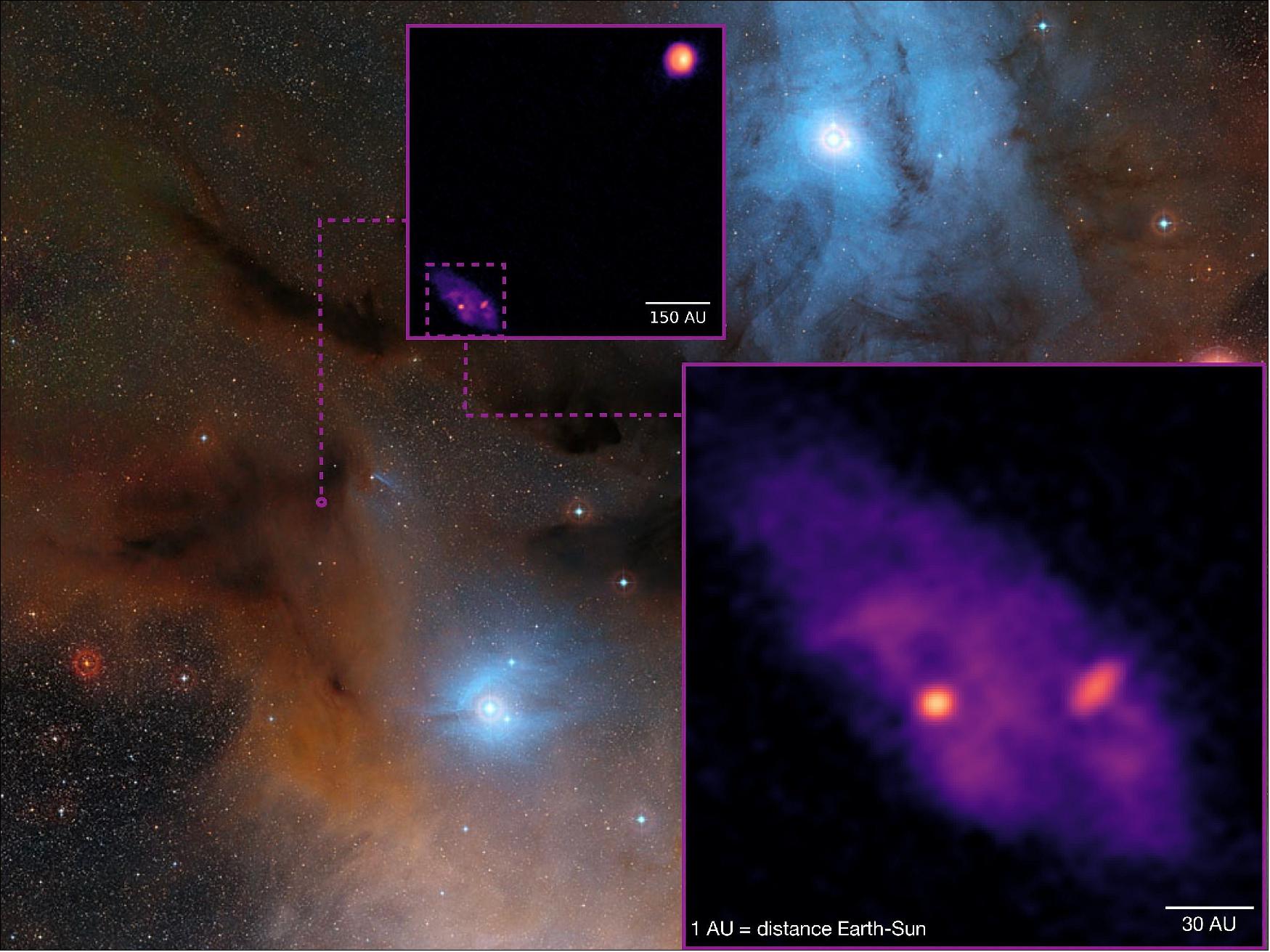
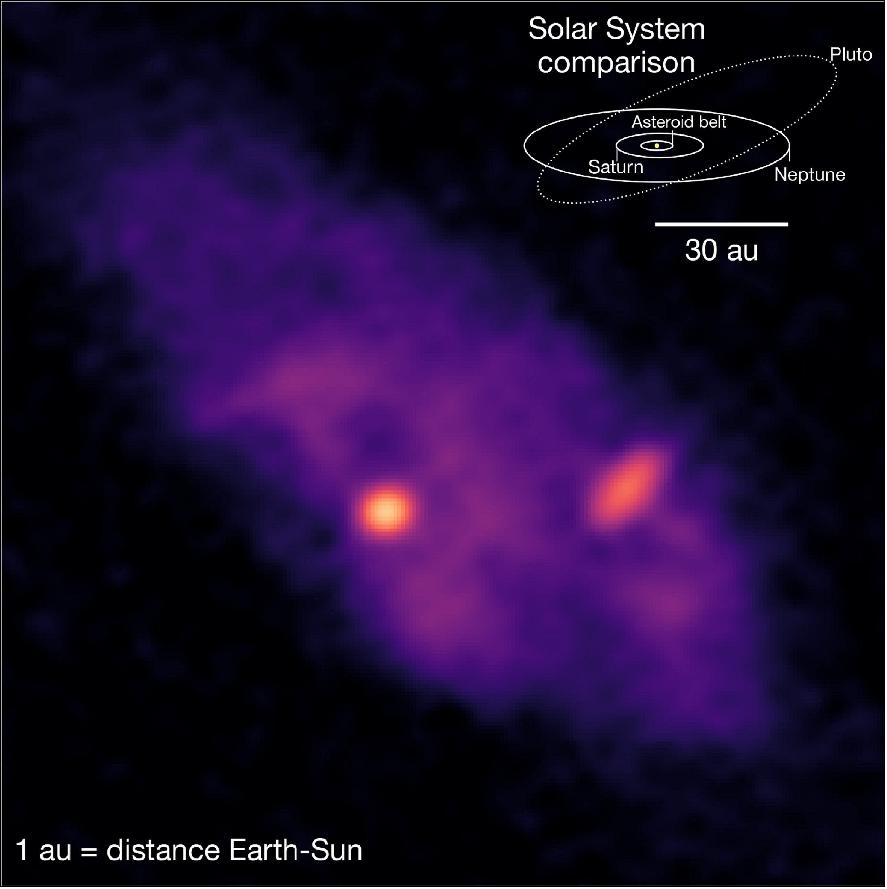
- The source A1 has a mass of a bit less than 1 solar mass and is embedded in a small dust disk about the size of the asteroid belt; the source A2 has a mass of about 1.4 solar masses and is embedded in a somewhat larger disk (see Figure 60). Interestingly, this disk around A2 also appears at an angle compared to the overall orientation of the larger cloud structure, while the disk around the source B – at a much larger distance – is seen face-on, indicating a rather chaotic formation history.
- In addition to direct imaging of the dust emission, the team also obtained information on the motion of the gas around the stars through observations of spectral lines of organic molecules, which well trace the high-density region surrounding the discovered binary system. This allowed them to get an independent mass measurement and to confirm that A1 and A2 form a bound pair.
- Combining their latest observations with data collected over the past 30 years, the team found that the two stars orbit each other once every 360 years at a distance similar to the extent of Pluto’s orbit, where the orbit is tilted by about 60° (see Figure 61). “This is the first time that we were able to derive the full orbital parameters of a binary system at this early stage of star formation,” points out Jaime Pineda from MPE, who contributed to the modelling.
- “With these results we are finally able to dive into one of the most embedded and youngest proto-stellar systems, unveiling its dynamical structure and complex morphology, where we clearly see filamentary material connecting the circumstellar disks to the surrounding region and likely to the cirbumbinary disk. The small disks are probably still being fed and growing!” emphasizes Paola Caselli, director at MPE and head of the Center for Astrochemical Studies. “This was only possible thanks to the great sensitivity of ALMA and the observations of molecules which uniquely trace these dense regions. Molecules send us signals at very specific frequencies, and, following changes of such frequencies across the region (due to internal motions) one can reconstruct the complex kinematics of the system. This is the power of astrochemistry.”
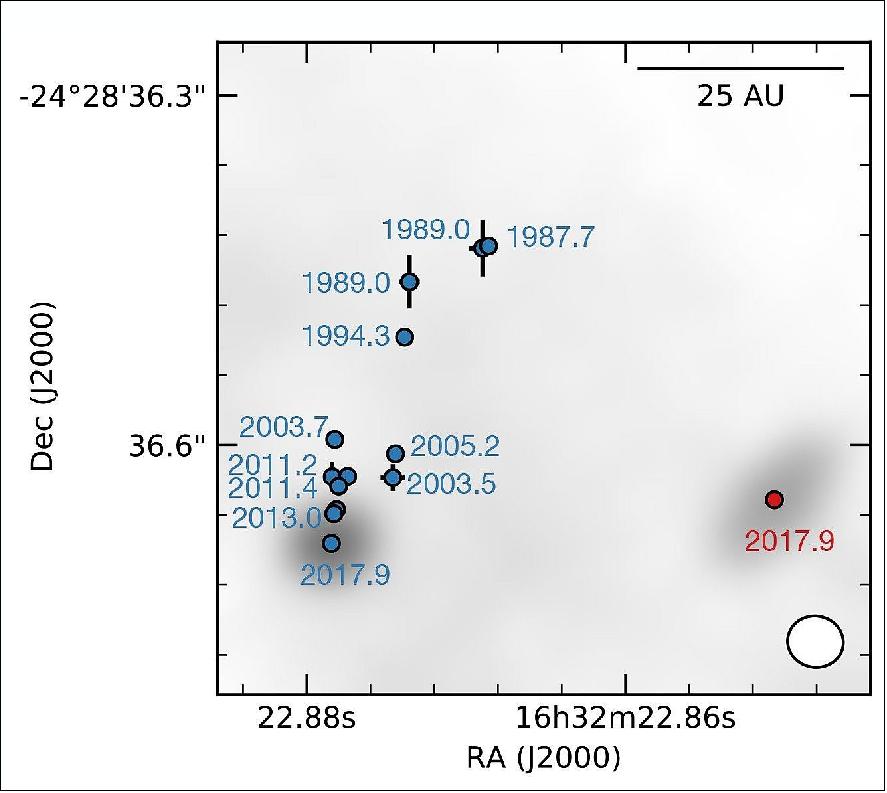
• May 22, 2020: Astronomers of NAOJ (National Astronomy Observatory, Japan) and Keio University using the Atacama Large Millimeter/submillimeter Array (ALMA) found quasi-periodic flickers in millimeter-waves from the center of the Milky Way, Sagittarius (Sgr) A*. The team interpreted these blinks to be due to the rotation of radio spots circling the supermassive black hole with an orbit radius smaller than that of Mercury. This is an interesting clue to investigate space-time with extreme gravity. 93)
- “It has been known that Sgr A* sometimes flares up in millimeter wavelength,” tells Yuhei Iwata, the lead author of the paper published in the Astrophysical Journal Letters and a graduate student at Keio University, Japan. “This time, using ALMA, we obtained high-quality data of radio-wave intensity variation of Sgr A* for 10 days, 70 minutes per day. Then we found two trends: quasi-periodic variations with a typical time scale of 30 minutes and hour-long slow variations.”
- Astronomers presume that a supermassive black hole with a mass of 4 million suns is located at the center of Sgr A*. Flares of Sgr A* have been observed not only in millimeter wavelength, but also in infrared light and X-ray. However, the variations detected with ALMA are much smaller than the ones previously detected, and it is possible that these levels of small variations always occur in Sgr A*.
- The black hole itself does not produce any kind of emission. The source of the emission is the scorching gaseous disk around the black hole. The gas around the black hole does not go straight to the gravitational well, but it rotates around the black hole to form an accretion disk.
- The team focused on short timescale variations and found that the variation period of 30 minutes is comparable to the orbital period of the innermost edge of the accretion disk with the radius of 0.2 astronomical units (1 astronomical unit corresponds to the distance between the Earth and the Sun: 150 million kilometers). For comparison, Mercury, the solar system’s innermost planet, circles around the Sun at a distance of 0.4 astronomical units. Considering the colossal mass at the center of the black hole, its gravity effect is also extreme in the accretion disk.
- “This emission could be related with some exotic phenomena occurring at the very vicinity of the supermassive black hole,” says Tomoharu Oka, a professor at Keio University.
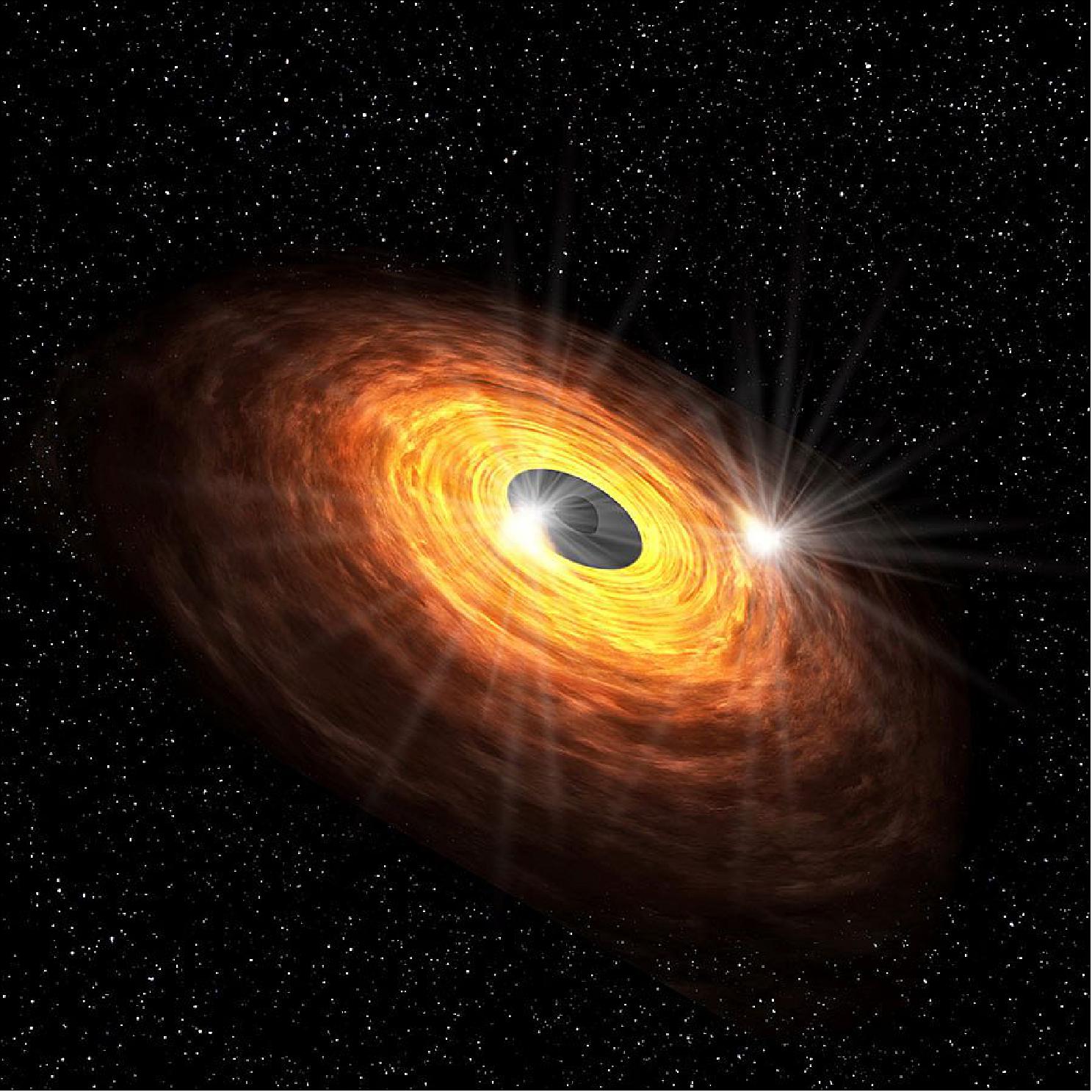
- Their scenario is as follows. Hot spots are sporadically formed in the disk and circle around the black hole, emitting strong millimeter waves. According to Einstein’s special relativity theory, the emission is largely amplified when the source is moving toward the observer with a speed comparable to that of light. The rotation speed of the inner edge of the accretion disk is quite large, so this extraordinary effect arises. The astronomers believe that this is the origin of the short-term variation of the millimeter emission from Sgr A*.
- The team supposes that the variation might affect the effort to make an image of the supermassive black hole with the Event Horizon Telescope. “In general, the faster the movement is, the more difficult it is to take a photo of the object,” says Oka. “Instead, the variation of the emission itself provides compelling insight for the gas motion. We may witness the very moment of gas absorption by the black hole with a long-term monitoring campaign with ALMA.” The researchers aim to draw out independent information to understand the mystifying environment around the supermassive black hole. 94)
• May 20, 2020: In our 13.8 billion-year-old universe, most galaxies like our Milky Way form gradually, reaching their large mass relatively late. But a new discovery made with the Atacama Large Millimeter/submillimeter Array (ALMA) of a massive rotating disk galaxy, seen when the universe was only ten percent of its current age, challenges the traditional models of galaxy formation. This research appears on 20 May 2020 in the journal Nature. 95) 96)
- Galaxy DLA0817g, nicknamed the Wolfe Disk after the late astronomer Arthur M. Wolfe, is the most distant rotating disk galaxy ever observed. The unparalleled power of ALMA made it possible to see this galaxy spinning at 170 miles (272 kilometers) per second, similar to our Milky Way.
- “While previous studies hinted at the existence of these early rotating gas-rich disk galaxies, thanks to ALMA we now have unambiguous evidence that they occur as early as 1.5 billion years after the Big Bang,” said lead author Marcel Neeleman of the Max Planck Institute for Astronomy in Heidelberg, Germany.
How Did the Wolfe Disk Form?
- The discovery of the Wolfe Disk provides a challenge for many galaxy formation simulations, which predict that massive galaxies at this point in the evolution of the cosmos grew through many mergers of smaller galaxies and hot clumps of gas.
- “Most galaxies that we find early in the universe look like train wrecks because they underwent consistent and often ‘violent’ merging,” explained Neeleman. “These hot mergers make it difficult to form well-ordered, cold rotating disks like we observe in our present universe.”
- In most galaxy formation scenarios, galaxies only start to show a well-formed disk around 6 billion years after the Big Bang. The fact that the astronomers found such a disk galaxy when the universe was only ten percent of its current age, indicates that other growth processes must have dominated.
- “We think the Wolfe Disk has grown primarily through the steady accretion of cold gas,” said J. Xavier Prochaska, of the University of California, Santa Cruz and coauthor of the paper. “Still, one of the questions that remains is how to assemble such a large gas mass while maintaining a relatively stable, rotating disk.”
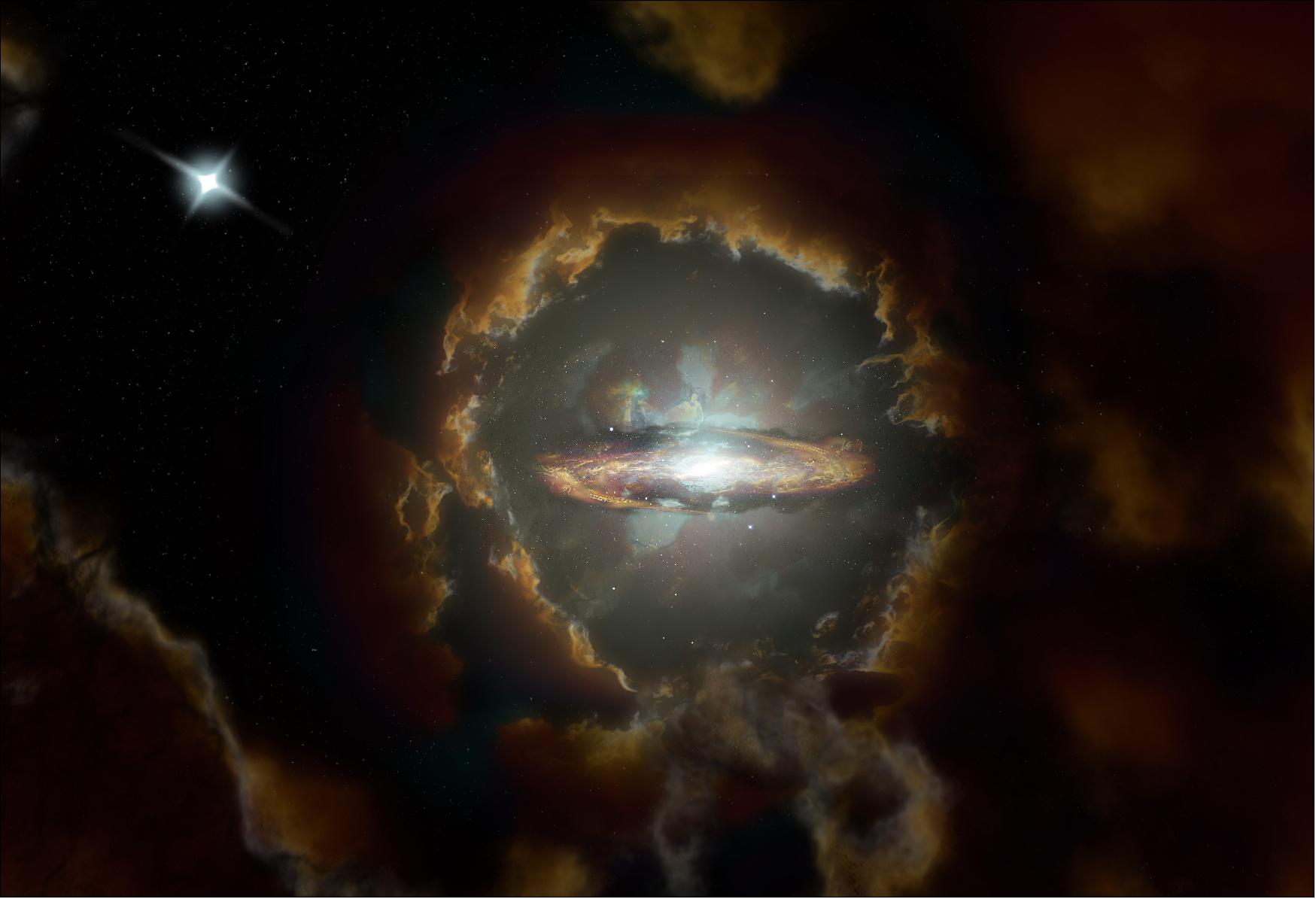
Star Formation
- The team also used the National Science Foundation’s Karl G. Jansky Very Large Array (VLA) and the NASA/ESA Hubble Space Telescope to learn more about star formation in the Wolfe Disk. In radio wavelengths, ALMA looked at the galaxy’s movements and mass of atomic gas and dust while the VLA measured the amount of molecular mass – the fuel for star formation. In UV-light, Hubble observed massive stars. “The star formation rate in the Wolfe Disk is at least ten times higher than in our own galaxy,” explained Prochaska. “It must be one of the most productive disk galaxies in the early universe.”
A ‘Normal’ Galaxy
- The Wolfe Disk was first discovered by ALMA in 2017. Neeleman and his team found the galaxy when they examined the light from a more distant quasar. The light from the quasar was absorbed as it passed through a massive reservoir of hydrogen gas surrounding the galaxy – which is how it revealed itself. Rather than looking for direct light from extremely bright, but more rare galaxies, astronomers used this ‘absorption’ method to find fainter, and more ‘normal’ galaxies in the early universe.
- “The fact that we found the Wolfe Disk using this method, tells us that it belongs to the normal population of galaxies present at early times,” said Neeleman. “When our newest observations with ALMA surprisingly showed that it is rotating, we realized that early rotating disk galaxies are not as rare as we thought and that there should be a lot more of them out there.”
- “This observation epitomizes how our understanding of the universe is enhanced with the advanced sensitivity that ALMA brings to radio astronomy,” said Joe Pesce, astronomy program director at the National Science Foundation, which funds the telescope. “ALMA allows us to make new, unexpected findings with almost every observation.”
- The National Radio Astronomy Observatory is a facility of the National Science Foundation, operated under cooperative agreement by Associated Universities, Inc.
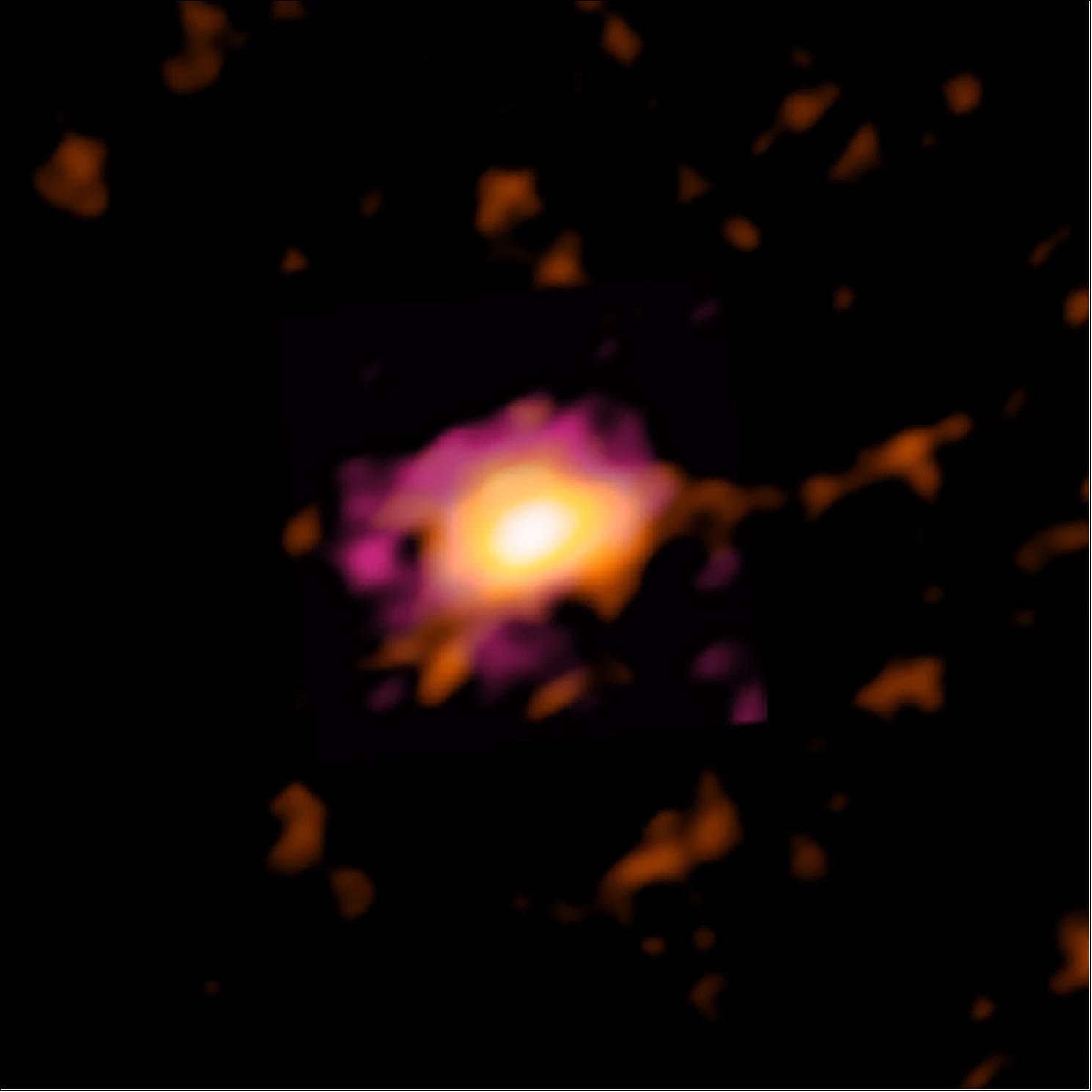
• March 19, 2020: Astronomers using ALMA have found striking orbital geometries in protoplanetary disks around binary stars. While disks orbiting the most compact binary star systems share very nearly the same plane, disks encircling wide binaries have orbital planes that are severely tilted. These systems can teach us about planet formation in complex environments. 97)
- In the last two decades, thousands of planets have been found orbiting stars other than our Sun. Some of these planets orbit two stars, just like Luke Skywalker’s home Tatooine. Planets are born in protoplanetary disks – we now have wonderful observations of these thanks to ALMA – but most of the disks studied so far orbit single stars. ‘Tatooine’ exoplanets form in disks around binary stars, so-called circumbinary disks.
- Studying the birthplaces of ‘Tatooine’ planets provides a unique opportunity to learn about how planets form in different environments. Astronomers already know that the orbits of binary stars can warp and tilt the disk around them, resulting in a circumbinary disk misaligned relative to the orbital plane of its host stars. For example, in a 2019 study led by Grant Kennedy of the University of Warwick, UK, ALMA found a striking circumbinary disk in a polar configuration.
- “With our study, we wanted to learn more about the typical geometries of circumbinary disks,” said astronomer Ian Czekala of the University of California at Berkeley. Czekala and his team used ALMA data to determine the degree of alignment of nineteen protoplanetary disks around binary stars. “The high resolution ALMA data was critical for studying some of the smallest and faintest circumbinary disks yet,” said Czekala.
- “We see a clear overlap between the small disks, orbiting compact binaries, and the circumbinary planets found with the Kepler mission,” Czekala said. Because the primary Kepler mission lasted 4 years, astronomers were only able to discover planets around binary stars that orbit each other in fewer than 40 days. And all of these planets were aligned with their host star orbits. A lingering mystery was whether there might be many misaligned planets that Kepler would have a hard time finding. “With our study, we now know that there likely isn’t a large population of misaligned planets that Kepler missed, since circumbinary disks around tight binary stars are also typically aligned with their stellar hosts,” added Czekala.
- Still, based on this finding, the astronomers conclude that misaligned planets around wide binary stars should be out there and that it would be an exciting population to search for with other exoplanet-finding methods like direct imaging and microlensing. (NASA’s Kepler mission used the transit method, which is one of the ways to find a planet.)
![Figure 65: The astronomers compared the ALMA data of the circumbinary disks with the dozen ‘Tatooine’ planets that have been found with the Kepler space telescope. To their surprise, the team found that the degree to which binary stars and their circumbinary disks are misaligned is strongly dependent on the orbital period of the host stars. The shorter the orbital period of the binary star, the more likely it is to host a disk in line with its orbit. However, binaries with periods longer than a month typically host misaligned disks [image credit: ALMA (ESO/NAOJ/NRAO), I. Czekala and G. Kennedy; NRAO/AUI/NSF, S. Dagnello]](https://www.eoportal.org/ftp/satellite-missions/a/Alma_300622/Alma_Auto2C.jpeg)
- Czekala now wants to find out why there is such a strong correlation between disk (mis)alignment and the binary star orbital period. “We want to use existing and coming facilities like ALMA and the next generation Very Large Array to study disk structures at exquisite levels of precision,” he said, “and try to understand how warped or tilted disks affect the planet formation environment and how this might influence the population of planets that form within these disks.”
- “This research is a great example of how new discoveries build on previous observations,” said Joe Pesce, National Science Foundation Program Officer for NRAO and ALMA. “Discerning trends in the circumbinary disk population was only made possible by building on the foundation of archival observational programs undertaken by the ALMA community in previous cycles.”
- The astronomers published their results in The Astrophysical Journal. 98)
![Figure 66: Two examples of aligned and misaligned protoplanetary disks around binary stars (circumbinary disks), observed with ALMA. Binary star orbits are added for clarity. Left: in star system HD 98800 B, the disk is misaligned with inner binary stars. The stars are orbiting each other (in this view, towards and away from us) in 315 days. Right: in star system AK Sco, the disk is in line with the orbit of its binary stars. The stars are orbiting each other in 13.6 days [image credit: ALMA (ESO/NAOJ/NRAO), I. Czekala and G. Kennedy; NRAO/AUI/NSF, S. Dagnello]](https://www.eoportal.org/ftp/satellite-missions/a/Alma_300622/Alma_Auto2B.jpeg)
• March 5, 2020: An international team of astronomers using the Atacama Large Millimeter/submillimeter Array (ALMA) captured the very moment when an old star first starts to alter its environment. The star has ejected high-speed bipolar gas jets which are now colliding with the surrounding material; the age of the observed jet is estimated to be less than 60 years. These are key features to understand how the complex shapes of planetary nebulae are formed. 99)
- Sun-like stars evolve to puffed-up Red Giants in the final stage of their lives. Then, the star expels gas to form a remnant called a planetary nebula. There is a wide variety in the shapes of planetary nebulae; some are spherical, but others are bipolar or show complicated structures. Astronomers are interested in the origins of this variety, but the thick dust and gas expelled by an old star obscure the system and make it difficult to investigate the inner-workings of the process.
- To tackle this problem, a team of astronomers led by Daniel Tafoya in Chalmers University of Technology, Sweden, pointed ALMA at W43A, an old star system in the constellation Aquila, the Eagle.
- Thanks to ALMA’s high resolution, the team obtained a very detailed view of the space around W43A. “The most notable structures are its small bipolar jets,” says Tafoya, the lead author of the research paper published by the Astrophysical Journal Letters. The team found that the velocity of the jets is as high as 175 km per second, which is much higher than previous estimations. Based on this speed and the size of the jets, the team calculated the age of the jets to be less than a human life-span. 100)
- “Considering the youth of the jets compared to the overall lifetime of a star, it is safe to say we are witnessing the ‘exact moment’ that the jets have just started to shove through the surrounding gas,” explains Tafoya. “When the jets carve through the surrounding material in some 60 years, a single person can watch the progress in their life.”
- In fact, the ALMA image clearly maps the distribution of dusty clouds entrained by the jets, which is telltale evidence that it is impacting on the surroundings.
- The team assumes that this entrainment is the key to form a bipolar-shaped planetary nebula. In their scenario, the aged star originally ejects gas spherically and the core of the star loses its envelope. If the star has a companion, gas from the companion pours onto the core of the dying star, and a portion of this new gas forms the jets. Therefore, whether or not the old star has a companion is an important factor to determine the structure of the resulting planetary nebula.
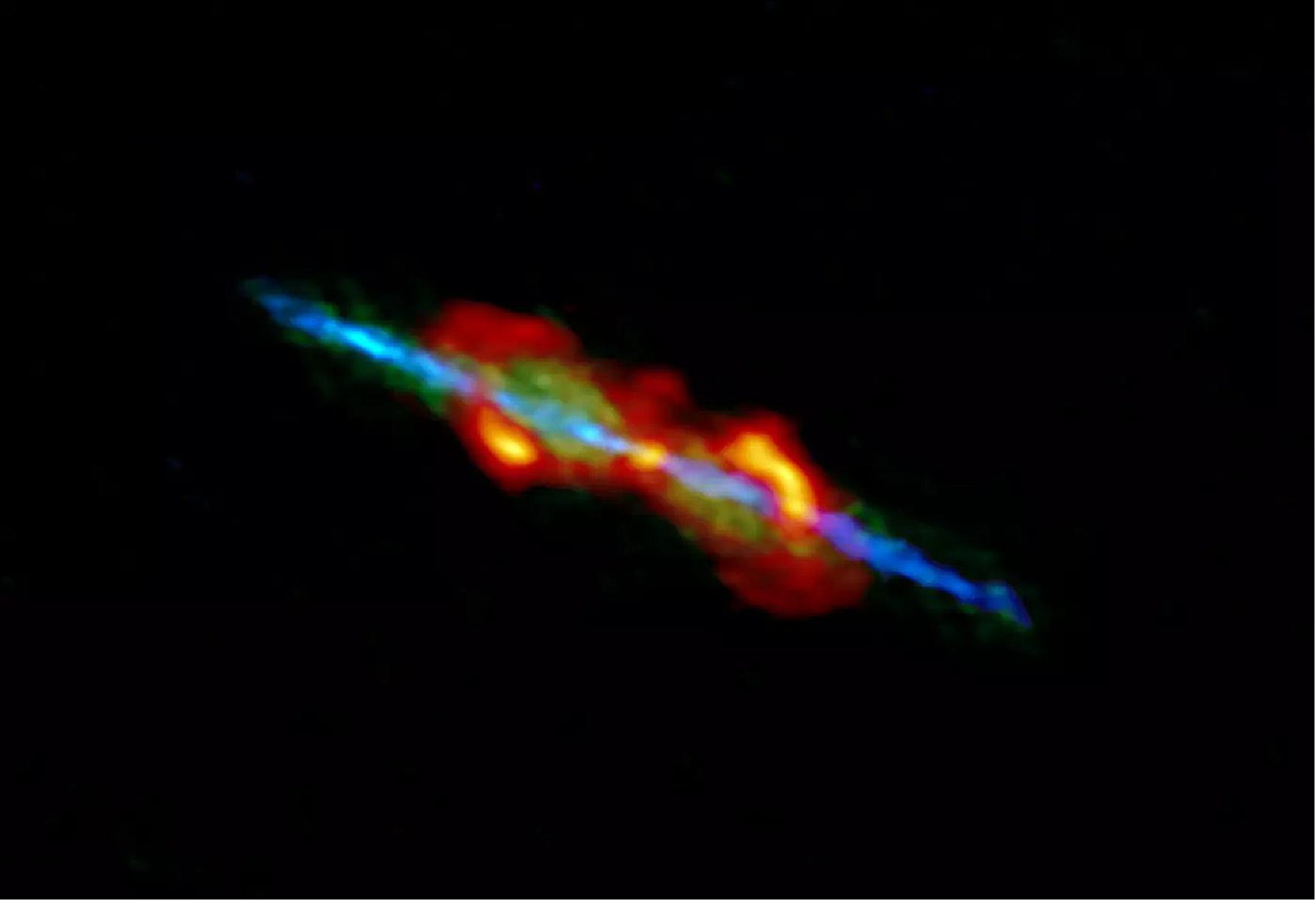
- “W43A is one of the peculiar so called ‘water fountain’ objects,” says Hiroshi Imai at Kagoshima University, Japan, a member of the team. “Some old stars show characteristic radio emissions from water molecules. We suppose that spots of these water emissions indicate the interface region between the jets and the surrounding material. We named them ‘water fountains,’ and it could be a sign that the central source is a binarity system launching a new jet.”
- “There are only 15 ‘water fountain’ objects identified to date, despite the fact that more than 100 billion stars are included in our Milky Way Galaxy,” explains José Francisco Gómez at Instituto de Astrofísica de Andalucía, Spain. “This is probably because the lifetime of the jets is quite short, so we are very lucky to see such rare objects.”
• February 20, 2020: An international team of astronomers used two of the most powerful radio telescopes in the world to create more than three hundred images of planet-forming disks around very young stars in the Orion Clouds. These images reveal new details about the birthplaces of planets and the earliest stages of star formation. 101)
- Most of the stars in the Universe are accompanied by planets. These planets are born in rings of dust and gas, called protoplanetary disks. Even very young stars are surrounded by these disks. Astronomers want to know exactly when these disks start to form, and what they look like. But young stars are very faint, and there are dense clouds of dust and gas surrounding them in stellar nurseries. Only highly sensitive radio telescope arrays can spot the tiny disks around these infant stars amidst the densely packed material in these clouds.
- For this new research, astronomers pointed both the Atacama Large Millimeter/submillimeter Array (ALMA) and the National Science Foundation’s Karl G. Jansky Very Large Array (VLA) to a region in space where many stars are born: the Orion Molecular Clouds. This survey, called VLA/ALMA Nascent Disk and Multiplicity (VANDAM), is the largest survey of young stars and their disks to date.
- Very young stars, also called protostars, form in clouds of gas and dust in space. The first step in the formation of a star is when these dense clouds collapse due to gravity. As the cloud collapses, it begins to spin – forming a flattened disk around the protostar. Material from the disk continues to feed the star and make it grow. Eventually, the left-over material in the disk is expected to form planets.
- Many aspects about these first stages of star formation, and how the disk forms, are still unclear. But this new survey provides some missing clues as the VLA and ALMA peered through the dense clouds and observed hundreds of protostars and their disks in various stages of their formation.
Young Planet-forming Disks
- “This survey revealed the average mass and size of these very young protoplanetary disks,” said John Tobin of the National Radio Astronomy Observatory (NRAO) in Charlottesville, Virginia, and leader of the survey team. “We can now compare them to older disks that have been studied intensively with ALMA as well.”
- What Tobin and his team found, is that very young disks can be similar in size, but are on average much more massive than older disks. “When a star grows, it eats away more and more material from the disk. This means that younger disks have a lot more raw material from which planets could form. Possibly bigger planets already start to form around very young stars.”
Four Special Protostars
- Among hundreds of survey images, four protostars looked different than the rest and caught the scientists’ attention. “These newborn stars looked very irregular and blobby,” said team member Nicole Karnath of the University of Toledo, Ohio (now at SOFIA Science Center). “We think that they are in one of the earliest stages of star formation and some may not even have formed into protostars yet.”
- It is special that the scientists found four of these objects. “We rarely find more than one such irregular object in one observation,” added Karnath, who used these four infant stars to propose a schematic pathway for the earliest stages of star formation. “We are not entirely sure how old they are, but they are probably younger than ten thousand years.”
- To be defined as a typical (class 0) protostar, stars should not only have a flattened rotating disk surrounding them, but also an outflow – spewing away material in opposite directions – that clears the dense cloud surrounding the stars and makes them optically visible. This outflow is important, because it prevents stars from spinning out of control while they grow. But when exactly these outflows start to happen, is an open question in astronomy.
- One of the infant stars in this study, called HOPS 404, has an outflow of only two kilometers (1.2 miles) per second (a typical protostar-outflow of 10-100 km/s or 6-62 miles/s). “It is a big puffy sun that is still gathering a lot of mass, but just started its outflow to lose angular momentum to be able to keep growing,” explained Karnath. “This is one of the smallest outflows that we have seen and it supports our theory of what the first step in forming a protostar looks like.”
Combining ALMA and VLA
- The exquisite resolution and sensitivity provided by both ALMA and the VLA were crucial to understand both the outer and inner regions of protostars and their disks in this survey. While ALMA can examine the dense dusty material around protostars in great detail, the images from the VLA made at longer wavelengths were essential to understand the inner structures of the youngest protostars at scales smaller than our solar system.
- “The combined use of ALMA and the VLA has given us the best of both worlds,” said Tobin. “Thanks to these telescopes, we start to understand how planet formation begins.”
- The National Radio Astronomy Observatory is a facility of the National Science Foundation, operated under cooperative agreement by Associated Universities, Inc.
More Information
- This research was presented in two papers:
a) ”The VLA/ALMA Nascent Disk and Multiplicity (VANDAM) Survey of Orion Protostars. A Statistical Characterization of Class 0 and I Protostellar Disks,” by J. Tobin et al., The Astrophysical Journal, Volume 890, No 2, Published: 20 February 2020, URL: https://doi.org/10.3847/1538-4357/ab6f64
b) “Detection of Irregular, Sub-mm Opaque Structures in the Orion Molecular Clouds: Protostars within 10000 years of formation?,” by N. Karnath et al., The Astrophysical Journal, Volume 890, No 2, Published: 20 February 2020, https://doi.org/10.3847/1538-4357/ab659e
- The original press release was published by the National Radio Astronomy Observatory (NRAO), an ALMA partner on behalf of North America.
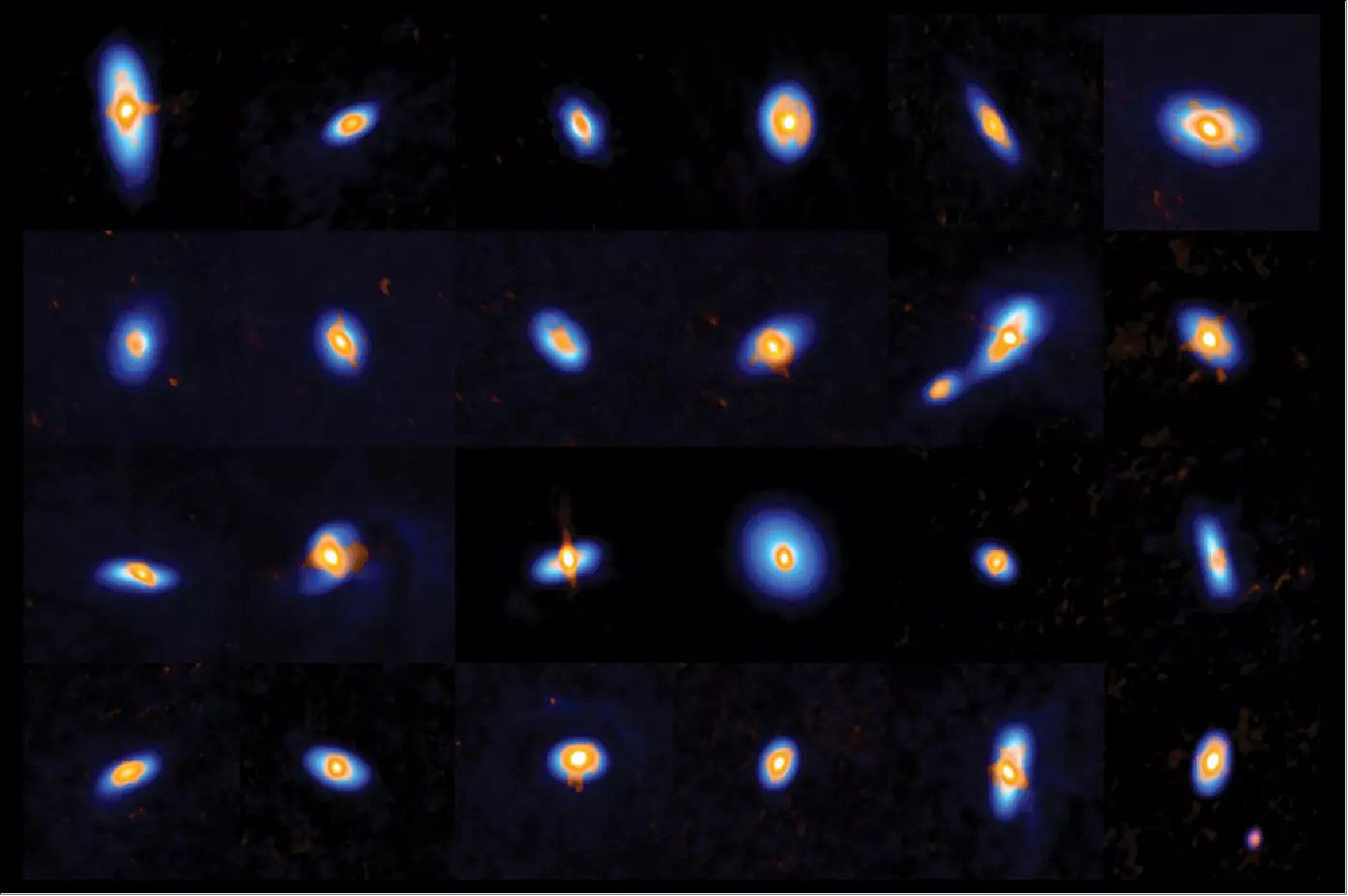
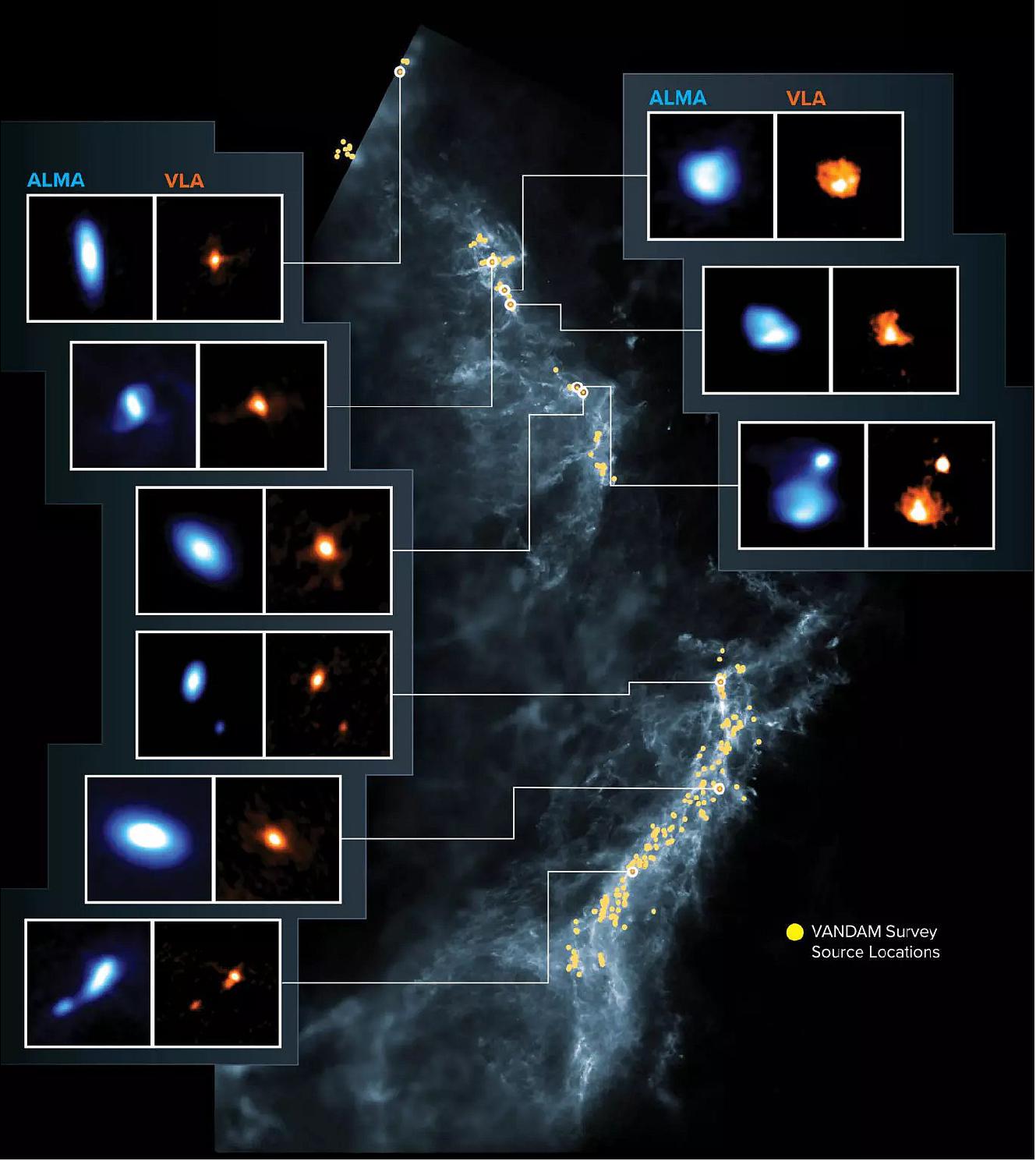
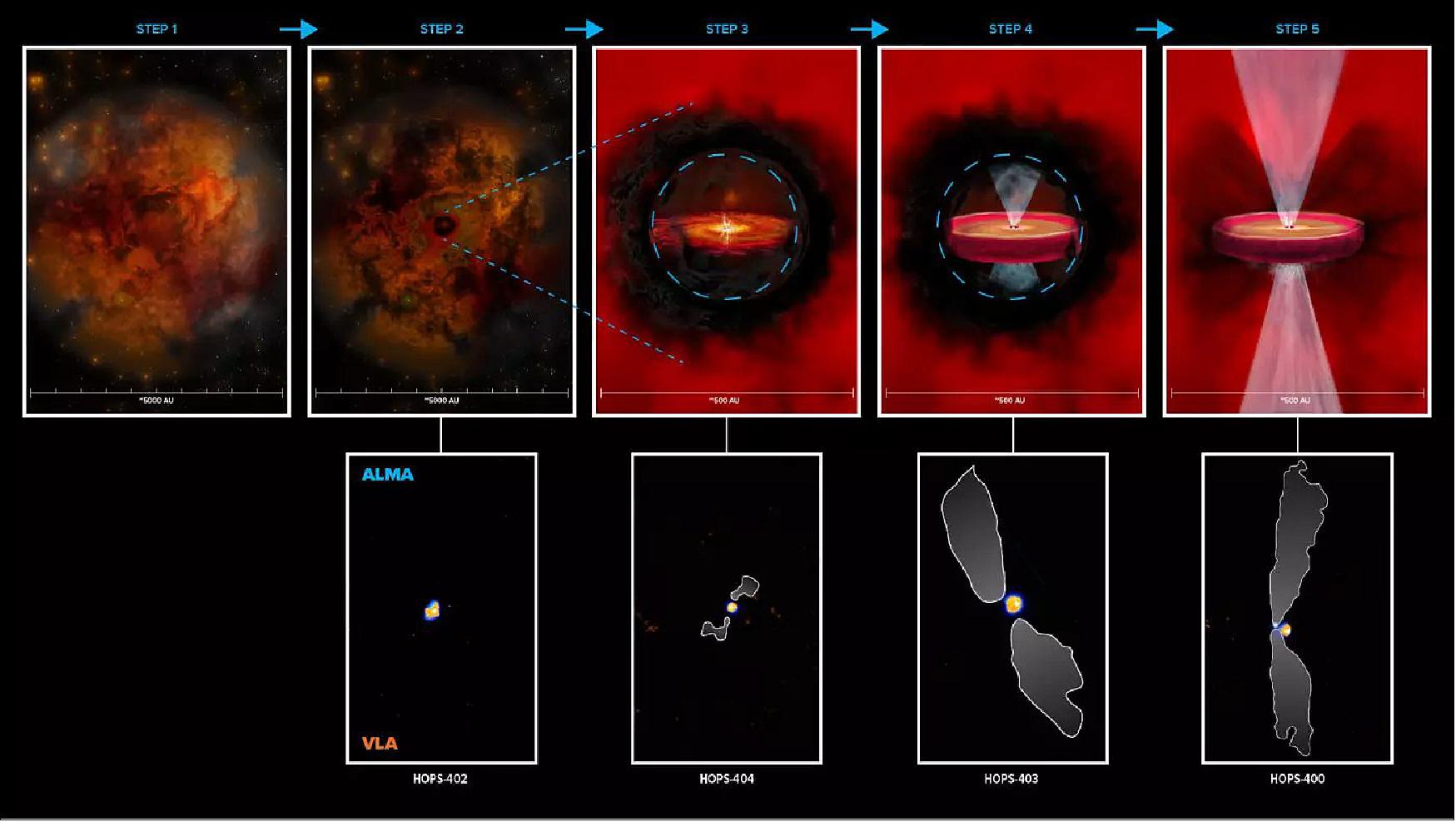
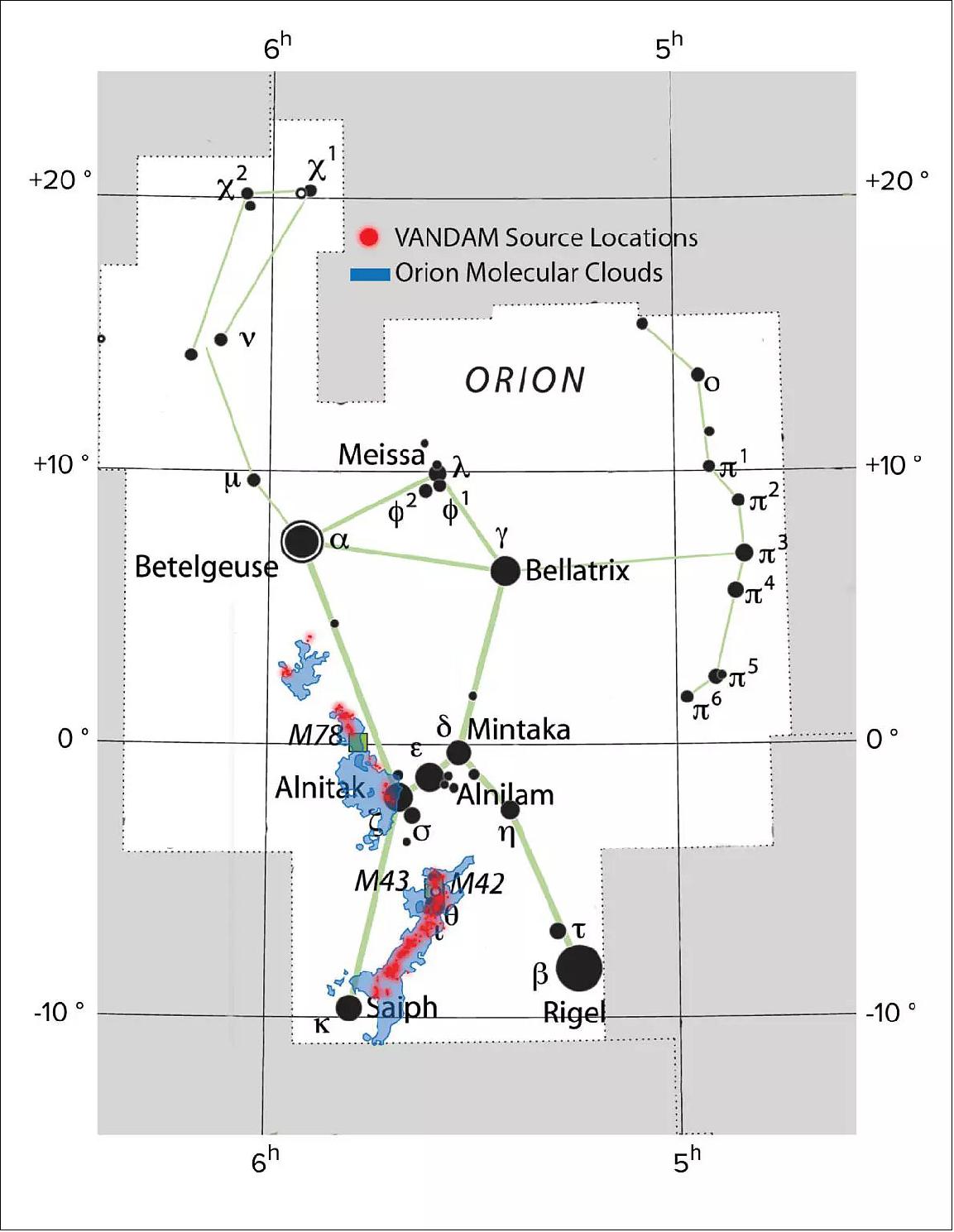
• February 5, 2020: Like humans, stars change with age and ultimately die. For the Sun and stars like it, this change will take it through a phase where, having burned all the hydrogen in its core, it swells up into a large and bright red-giant star. Eventually, the dying Sun will lose its outer layers, leaving behind its core: a hot and dense star called a white dwarf. 102)
- “The star system HD101584 is special in the sense that this ‘death process’ was terminated prematurely and dramatically as a nearby low-mass companion star was engulfed by the giant,” said Hans Olofsson of the Chalmers University of Technology, Sweden, who led a recent study, published in Astronomy & Astrophysics, of this intriguing object. 103)
- Thanks to new observations with ALMA, complemented by data from the ESO-operated Atacama Pathfinder EXperiment (APEX), Olofsson and his team now know that what happened in the double-star system HD101584 was akin to a stellar fight. As the main star puffed up into a red giant, it grew large enough to swallow its lower-mass partner. In response, the smaller star spiralled in towards the giant’s core but didn’t collide with it. Rather, this maneuver triggered the larger star into an outburst, leaving its gas layers dramatically scattered and its core exposed.
- The team says the complex structure of the gas in the HD101584 nebula is due to the smaller star’s spiralling towards the red giant, as well as to the jets of gas that formed in this process. As a deadly blow to the already defeated gas layers, these jets blasted through the previously ejected material, forming the rings of gas and the bright bluish and reddish blobs seen in the nebula.
- A silver lining of a stellar fight is that it helps astronomers to better understand the final evolution of stars like the Sun. “Currently, we can describe the death processes common to many Sun-like stars, but we cannot explain why or exactly how they happen. HD101584 gives us important clues to solve this puzzle since it is currently in a short transitional phase between better studied evolutionary stages. With detailed images of the environment of HD101584 we can make the connection between the giant star it was before, and the stellar remnant it will soon become,” says co-author Sofia Ramstedt from Uppsala University, Sweden.
- Co-author Elizabeth Humphreys from ESO in Chile highlighted that ALMA and APEX, located in the country’s Atacama region, were crucial to enabling the team to probe “both the physics and chemistry in action” in the gas cloud. She added: “This stunning image of the circumstellar environment of HD101584 would not have been possible without the exquisite sensitivity and angular resolution provided by ALMA.”
- While current telescopes allow astronomers to study the gas around the binary, the two stars at the center of the complex nebula are too close together and too far away to be resolved. ESO’s Extremely Large Telescope, under construction in Chile’s Atacama Desert, “will provide information on the ‘heart’ of the object,” says Olofsson, allowing astronomers a closer look at the fighting pair.
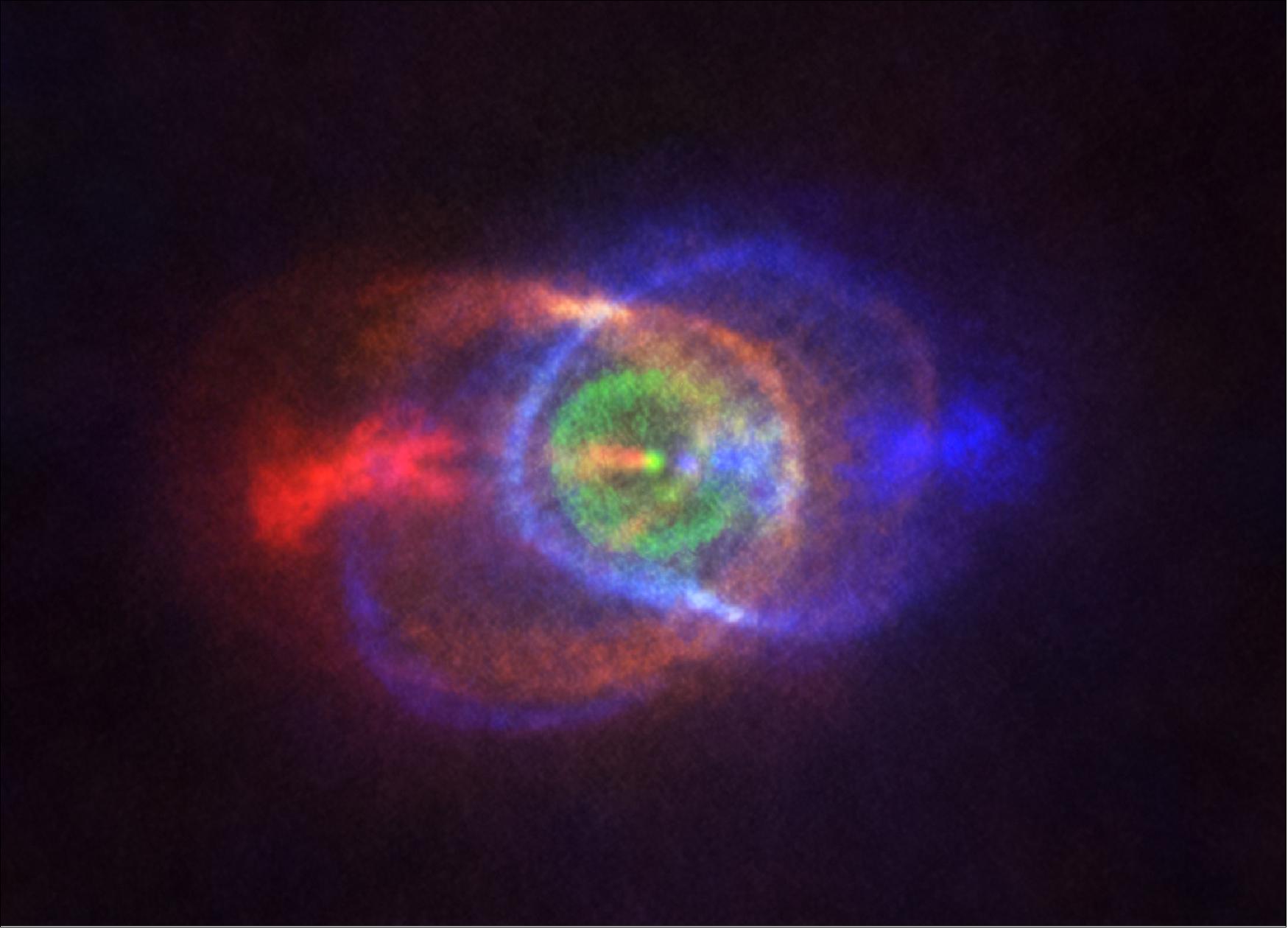
• January 21, 2020: Phosphorus, present in our DNA and cell membranes, is an essential element for life as we know it. But how it arrived on the early Earth is something of a mystery. Astronomers have now traced the journey of phosphorus from star-forming regions to comets using the combined powers of ALMA and the European Space Agency’s probe Rosetta. Their research shows, for the first time, where molecules containing phosphorus form, how this element is carried in comets, and how a particular molecule may have played a crucial role in starting life on our planet. 104)
- “Life appeared on Earth about 4 billion years ago, but we still do not know the processes that made it possible,” says Víctor Rivilla, the lead author of a new study published today in the journal Monthly Notices of the Royal Astronomical Society. The new results from the Atacama Large Millimeter/Submillimeter Array(ALMA), in which the European Southern Observatory (ESO) is a partner, and from the ROSINA instrument on board Rosetta, show that phosphorus monoxide is a key piece in the origin-of-life puzzle. 105)
- With the power of ALMA, which allowed a detailed look into the star-forming region AFGL 5142, astronomers could pinpoint where phosphorus-bearing molecules, like phosphorus monoxide, form. New stars and planetary systems arise in cloud-like regions of gas and dust in between stars, making these interstellar clouds the ideal places to start the search for life’s building blocks.
- The ALMA observations showed that phosphorus-bearing molecules are created as massive stars are formed. Flows of gas from young massive stars open up cavities in interstellar clouds. Molecules containing phosphorus form on the cavity walls, through the combined action of shocks and radiation from the infant star. The astronomers have also shown that phosphorus monoxide is the most abundant phosphorus-bearing molecule in the cavity walls.
- After searching for this molecule in star-forming regions with ALMA, the European team moved on to a Solar System object: the now-famous comet 67P/Churyumov–Gerasimenko. The idea was to follow the trail of these phosphorus-bearing compounds. If the cavity walls collapse to form a star, particularly a less-massive one like the Sun, phosphorus monoxide can freeze out and get trapped in the icy dust grains that remain around the new star. Even before the star is fully formed, those dust grains come together to form pebbles, rocks and ultimately comets, which become transporters of phosphorus monoxide.
- ROSINA, which stands for Rosetta Orbiter Spectrometer for Ion and Neutral Analysis, collected data from 67P for two years as Rosetta orbited the comet. Astronomers had found hints of phosphorus in the ROSINA data before, but they did not know what molecule had carried it there. Kathrin Altwegg, the Principal Investigator for Rosina and an author in the new study, got a clue about what this molecule could be after being approached at a conference by an astronomer studying star-forming regions with ALMA: “She said that phosphorus monoxide would be a very likely candidate, so I went back to our data and there it was!”
- This first sighting of phosphorus monoxide on a comet helps astronomers draw a connection between star-forming regions, where the molecule is created, all the way to Earth.
- “The combination of the ALMA and ROSINA data has revealed a sort of chemical thread during the whole process of star formation, in which phosphorus monoxide plays the dominant role,” says Rivilla, who is a researcher at the Arcetri Astrophysical Observatory of INAF, Italy’s National Institute for Astrophysics.
- “Phosphorus is essential for life as we know it,” adds Altwegg. “As comets most probably delivered large amounts of organic compounds to the Earth, the phosphorus monoxide found in comet 67P may strengthen the link between comets and life on Earth.”
- This intriguing journey could be documented because of the collaborative efforts between astronomers. “The detection of phosphorus monoxide was clearly thanks to an interdisciplinary exchange between telescopes on Earth and instruments in space,” says Altwegg.
- Leonardo Testi, ESO astronomer and ALMA European Operations Manager, concludes: “Understanding our cosmic origins, including how common the chemical conditions favorable for the emergence of life are, is a major topic of modern astrophysics. While ESO and ALMA focus on the observations of molecules in distant young planetary systems, the direct exploration of the chemical inventory within our Solar System is made possible by ESA missions, like Rosetta. The synergy between world leading ground-based and space facilities, through the collaboration between ESO and ESA, is a powerful asset for European researchers and enables transformational discoveries like the one reported in this paper.”
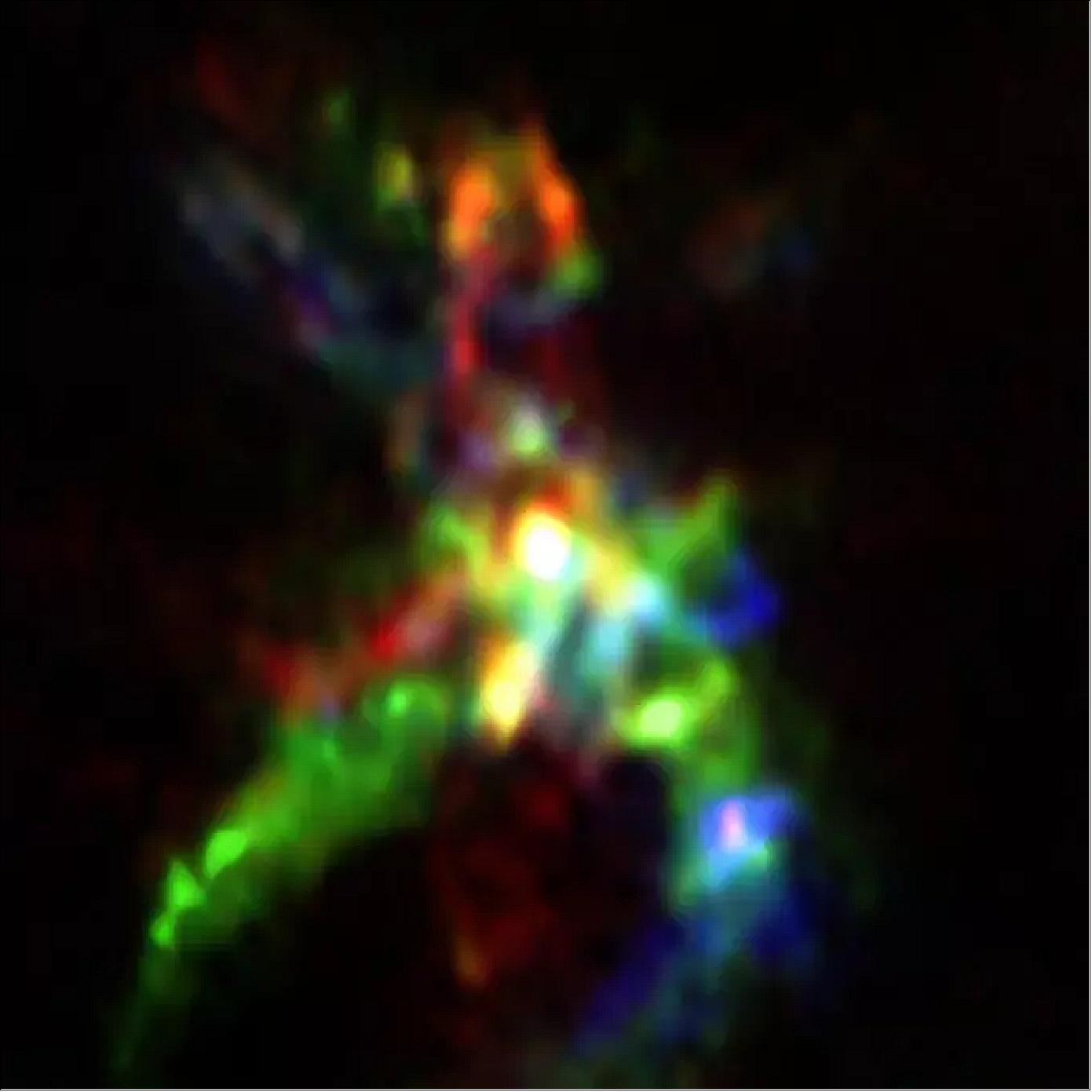
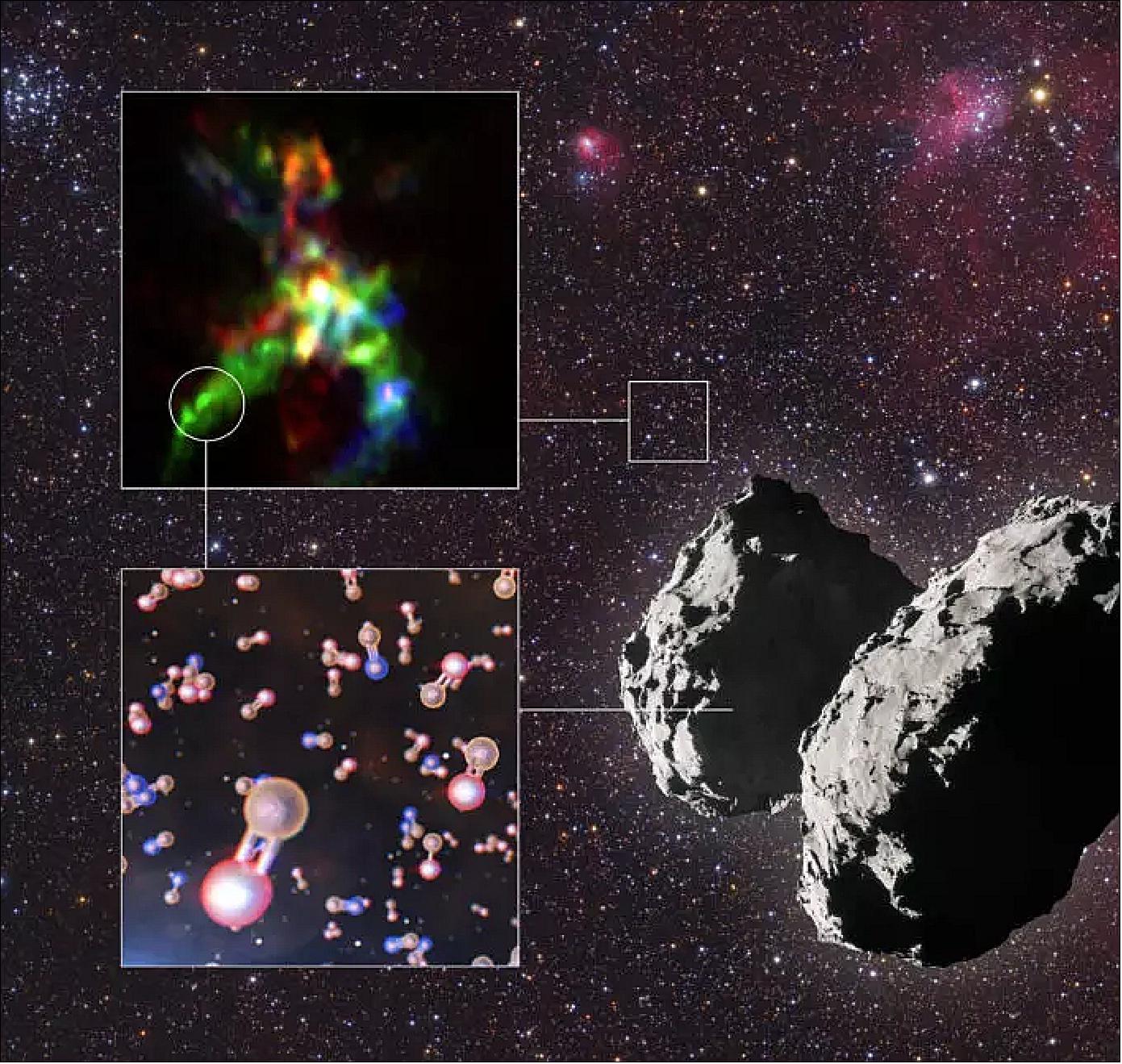
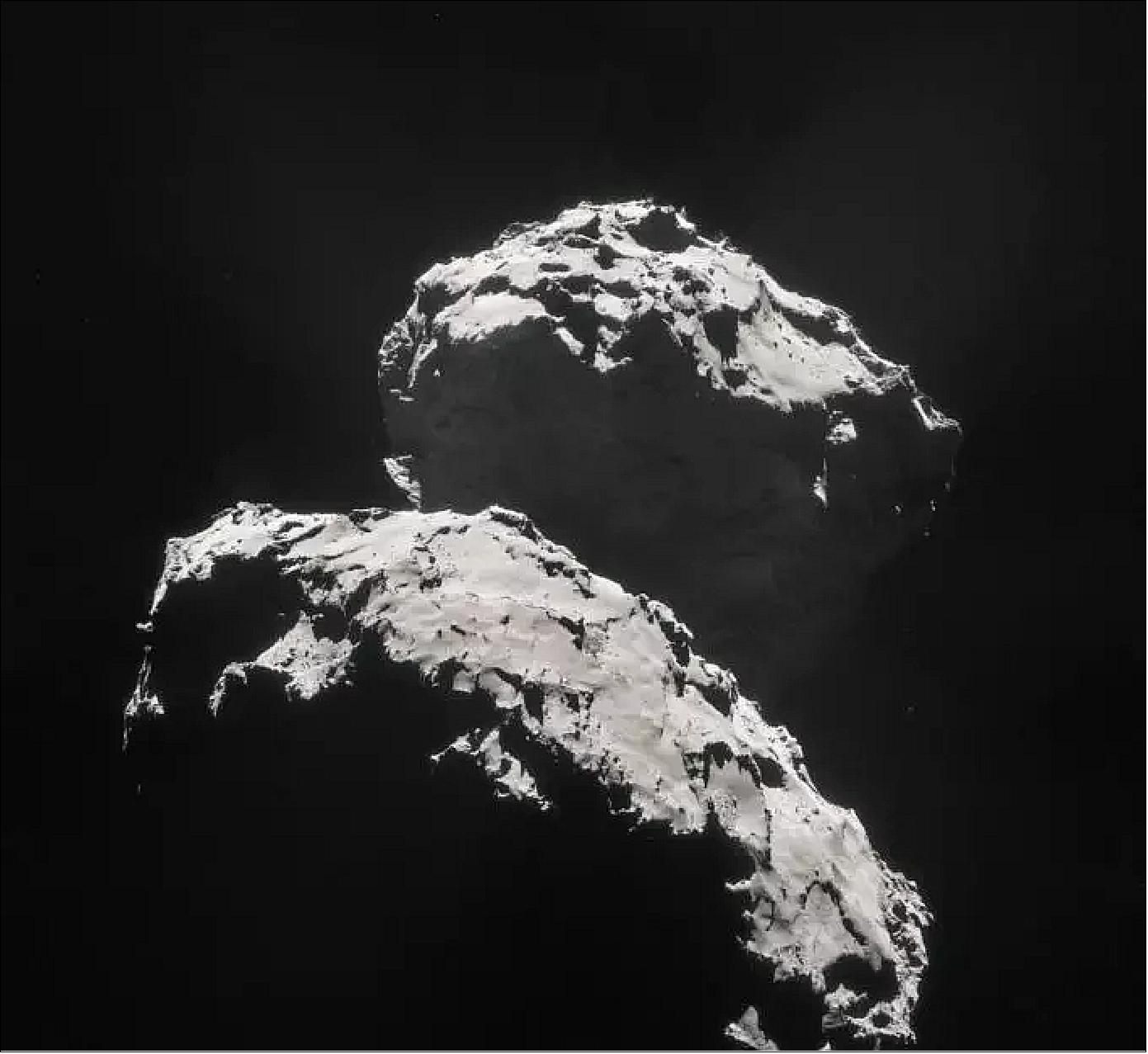
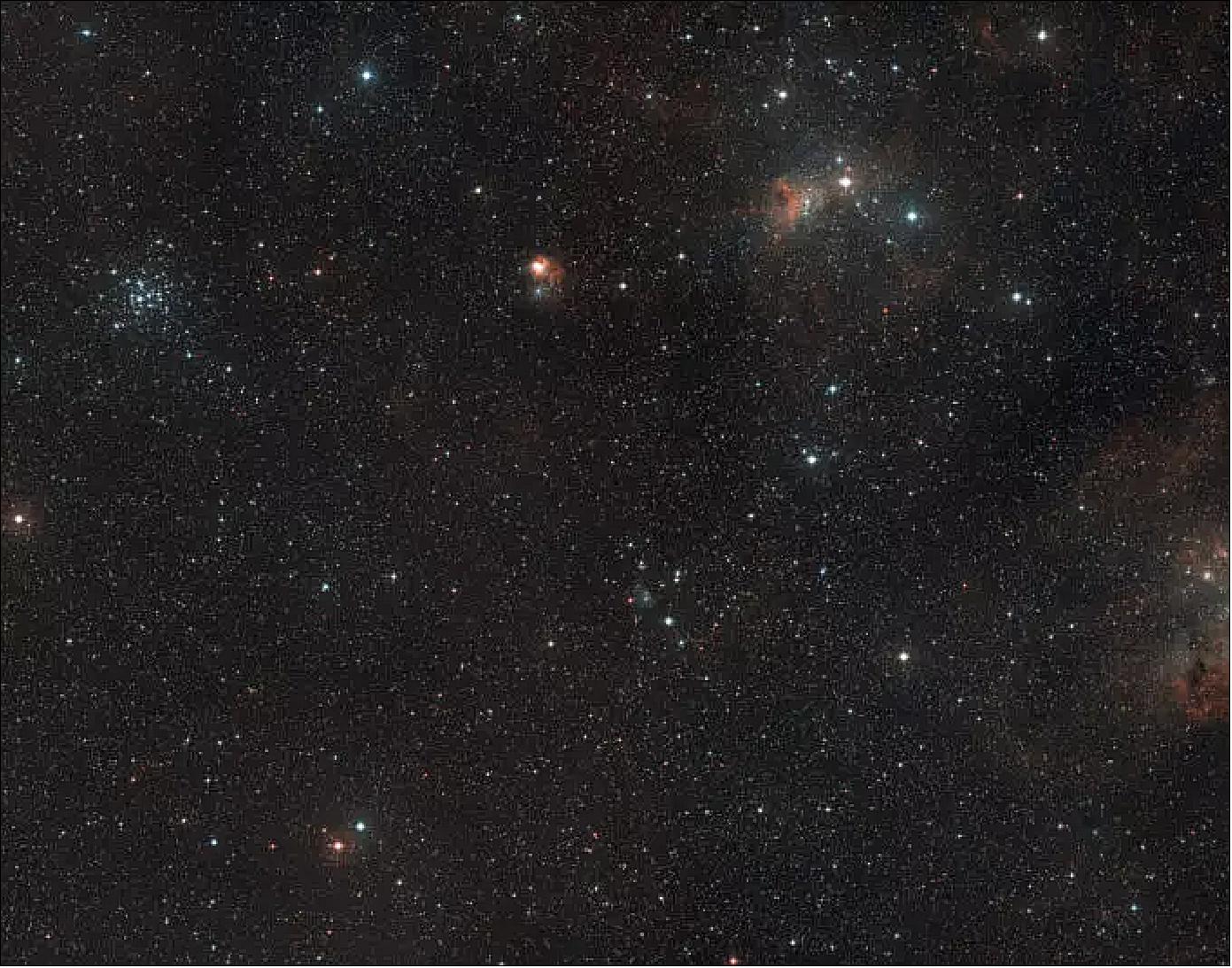
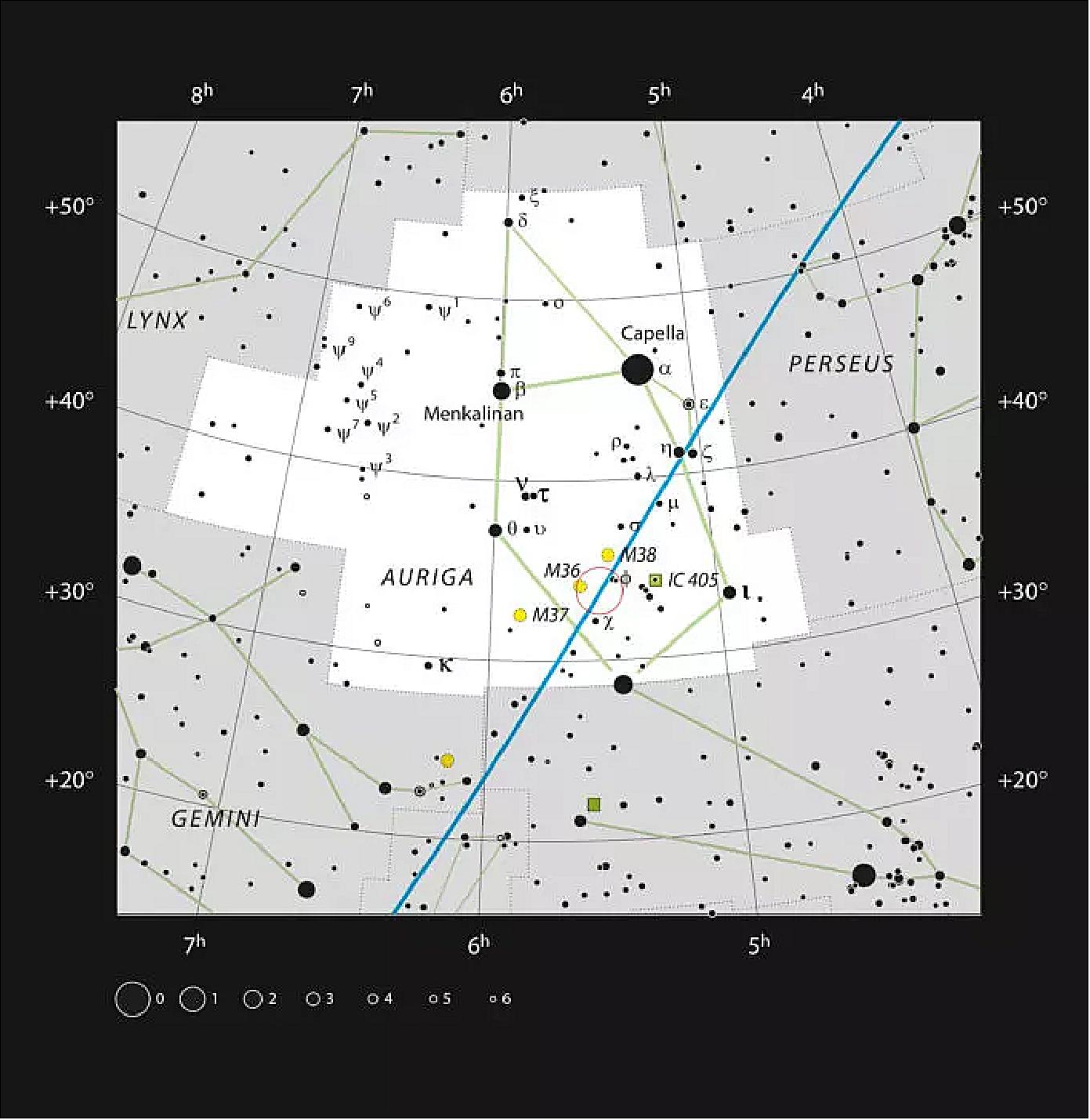
• December 11, 2019: Astronomers using ALMA (Atacama Large Millimeter/submillimeter Array), have spotted the light of a massive galaxy seen only 970 million years after the Big Bang. This galaxy, called MAMBO-9, is the most distant dusty star-forming galaxy that has ever been observed without the help of a gravitational lens. 106)
- Dusty star-forming galaxies are the most intense stellar nurseries in the universe. They form stars at a rate up to a few thousand times the mass of the Sun per year (the star-forming rate of our Milky Way is just three solar masses per year) and they contain massive amounts of gas and dust. Such monster galaxies are not expected to have formed early in the history of the universe, but astronomers have already discovered several of them as seen when the cosmos was less than a billion years old. One of them is galaxy SPT0311-58, which ALMA observed in 2018.
- Because of their extreme behavior, astronomers think that these dusty galaxies play an important role in the evolution of the universe. But finding them is easier said than done. “These galaxies tend to hide in plain sight,” said Caitlin Casey of the University of Texas at Austin and lead author of a study published in The Astrophysical Journal. “We know they are out there, but they are not easy to find because their starlight is hidden in clouds of dust.” 107)
- MAMBO-9’s light was already detected ten years ago by co-author Manuel Aravena, using the Max-Planck Millimeter BOlometer (MAMBO) instrument on the IRAM 30-meter telescope in Spain and the Plateau de Bure Interferometer in France. But these observations were not sensitive enough to reveal the distance of the galaxy. “We were in doubt if it was real, because we couldn’t find it with other telescopes. But if it was real, it had to be very far away,” says Aravena, who was at that time a PhD student in Germany and is currently working for the Universidad Diego Portales in Chile.
- Thanks to ALMA’s sensitivity, Casey and her team have now been able to determine the distance of MAMBO-9. “We found the galaxy in a new ALMA survey specifically designed to identify dusty star-forming galaxies in the early universe,” said Casey. “And what is special about this observation, is that this is the most distant dusty galaxy we have ever seen in an unobstructed way.”
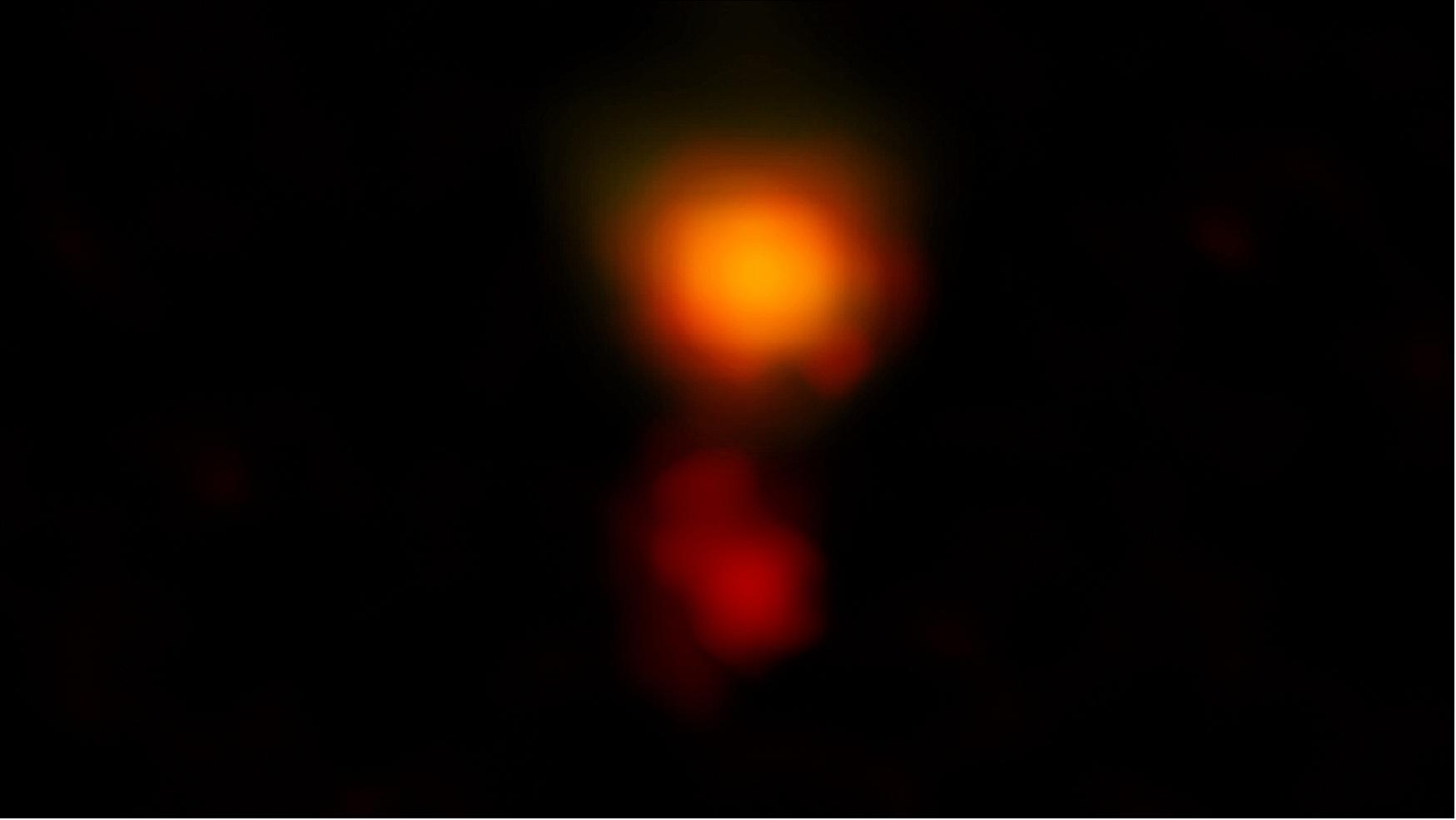
- The light of distant galaxies is often obstructed by other galaxies closer to us. These galaxies in front work as a gravitational lens: they bend the light from the more distant galaxy. This lensing effect makes it easier for telescopes to spot distant objects (this is how ALMA could see galaxy SPT0311-58). But it also distorts the image of the object, making it harder to make out the details.
- In this study, the astronomers saw MAMBO-9 directly, without a lens, and this allowed them to measure its mass. “The total mass of gas and dust in the galaxy is enormous: ten times more than all the stars in the Milky Way. This means that it has yet to build most of its stars,” Casey explained. The galaxy consists of two parts, and it is in the process of merging.
- Casey hopes to find more distant dusty galaxies in the ALMA survey, which will give insight into how common they are, how these massive galaxies formed so early in the universe, and why they are so dusty. “Dust is normally a by-product of dying stars,” she said. “We expect one hundred times more stars than dust. But MAMBO-9 has not produced that many stars yet and we want to find out how dust can form so fast after the Big Bang.”
- “Observations with new and more capable technology can produce unexpected findings like MAMBO-9,” said Joe Pesce, National Science Foundation Program Officer for NRAO and ALMA. “While it is challenging to explain such a massive galaxy so early in the history of the universe, discoveries like this allow astronomers to develop an improved understanding of, and ask ever more questions about, the universe.”
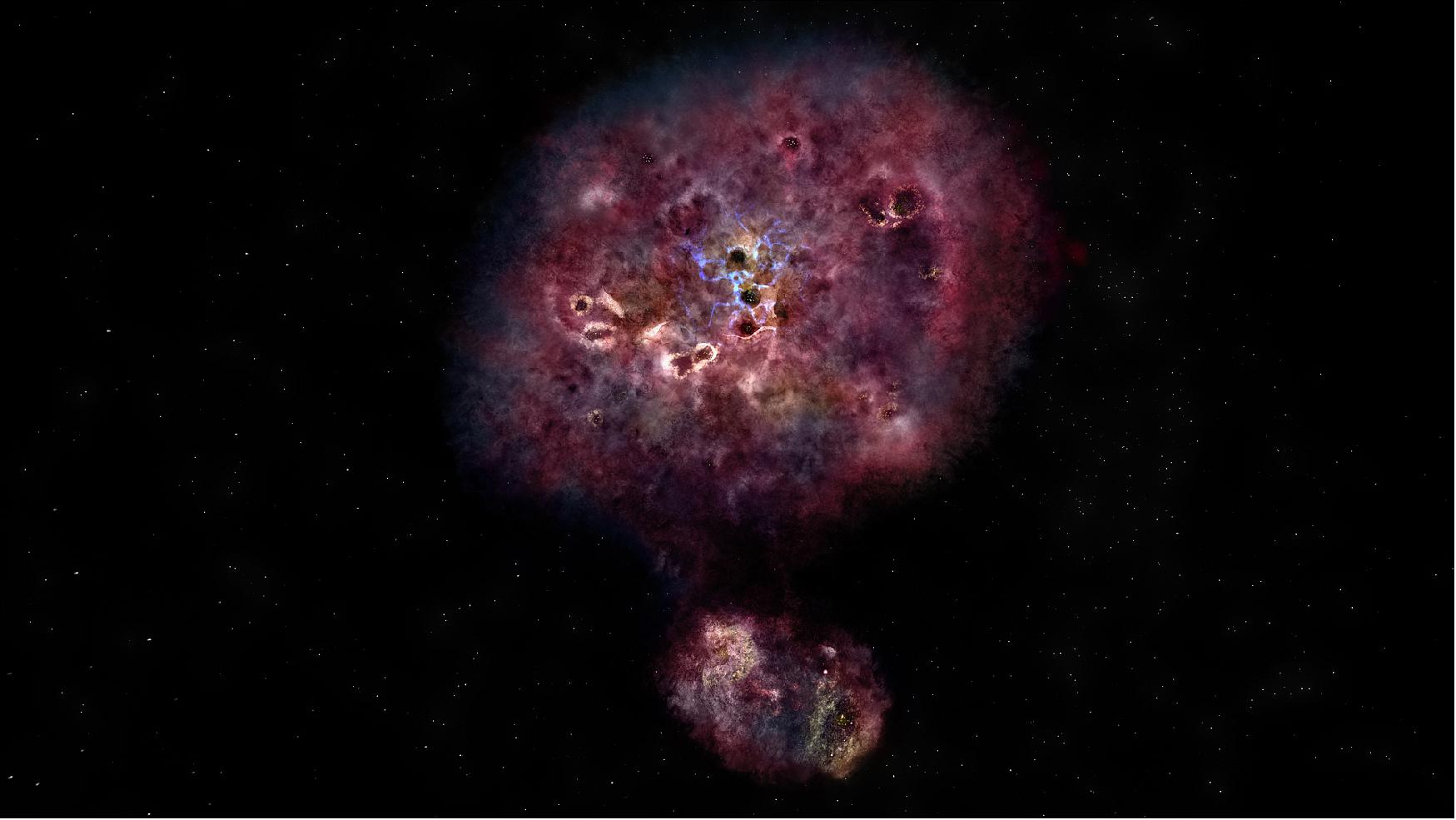
- The light from MAMBO-9 travelled about 13 billion years to reach ALMA’s antennas (the universe is approximately 13.8 billion years old today). That means that we can see what the galaxy looked like in the past (Watch this video to learn how ALMA works as a time-machine). Today, the galaxy would probably be even bigger, containing one hundred times more stars than the Milky Way, residing in a massive galaxy cluster.
- The National Radio Astronomy Observatory is a facility of the National Science Foundation (NSF), operated under cooperative agreement by Associated Universities, Inc.
• November 14, 2019: Two peacock-shaped gas clouds were revealed in the Large Magellanic Cloud (LMC) by observations with ALMA. A team of astronomers found several massive baby stars in the complex filamentary clouds, which agrees well with computer simulations of giant collisions of gas clouds. The researchers interpret this to mean that the filaments and young stars are telltale evidence of violent interactions between the LMC and the SMC (Small Magellanic Cloud) 200 million years ago. 108) 109)
- Astronomers know that stars are formed in collapsing clouds in space. However, the formation processes of giant stars, 10 times or more massive than the Sun, are not well understood because it is difficult to pack such a large amount of material into a small region. Some researchers suggest that interactions between galaxies provide a perfect environment for massive star formation. Due to the colossal gravity, clouds in the galaxies are stirred, stretched, and often collide with each other. A huge amount of gas is compressed in an unusually small area, which could form the seeds of massive stars.
- A research team used ALMA to study the structure of dense gas in N159, a bustling star formation region in the LMC. Thanks to ALMA’s high resolution, the team obtained a very detailed map of the clouds in two sub-regions, N159E-Papillon Nebula and N159W South.
- Interestingly, the cloud structures in the two regions look very similar: fan-shaped filaments of gas extending to the north with the pivots in the southernmost points. The ALMA observations also found several massive baby stars in the filaments in the two regions.
- “It is unnatural that in two regions separated by 150 light-years, clouds with such similar shapes were formed and that the ages of the baby stars are similar in two regions separated 150 light years,” says Kazuki Tokuda, a researcher at Osaka Prefecture University and the National Astronomical Observatory of Japan. “There must be a common cause of these features. Interaction between the LMC and SMC is a good candidate.”
- In 2017, Yasuo Fukui, a professor at Nagoya University and his team revealed the motion of hydrogen gas in the LMC and found that a gaseous component right next to N159 has a different velocity than the rest of the clouds. They suggested a hypothesis that the starburst is caused by a massive flow of gas from the SMC to the LMC, and that this flow originated from a close encounter between the two galaxies 200 million years ago.
- The pair of the peacock-shaped clouds in the two regions revealed by ALMA fits nicely with this hypothesis. Computer simulations show that many filamentary structures are formed in a short time scale after a collision of two clouds, which also backs this idea.
- “For the first time, we uncovered the link between massive star formation and galaxy interactions in very sharp detail,” says Fukui, the lead author of one of the research papers. “This is an important step in understanding the formation process of massive star clusters in which galaxy interactions have a big impact.”
![Figure 80: ALMA images of two molecular clouds N159E-Papillon Nebula (left) and N159W South (right). Red and green show the distribution of molecular gas in different velocities seen in the emission from 13CO. The blue region in N159E-Papillon Nebula shows the ionized hydrogen gas observed with the Hubble Space Telescope. The blue part in N159W South shows the emission from dust particles obtained with ALMA [image credit: ALMA (ESO/NAOJ/NRAO)/Fukui et al./Tokuda et al./NASA-ESA Hubble Space Telescope]](https://www.eoportal.org/ftp/satellite-missions/a/Alma_300622/Alma_Auto1D.jpeg)
• October 15, 2019: At the center of a galaxy called NGC 1068, a supermassive black hole hides within a thick doughnut-shaped cloud of dust and gas. When astronomers used ALMA ( Atacama Large Millimeter/submillimeter Array) to study this cloud in more detail, they made an unexpected discovery that could explain why supermassive black holes grew so rapidly in the early Universe. 110)
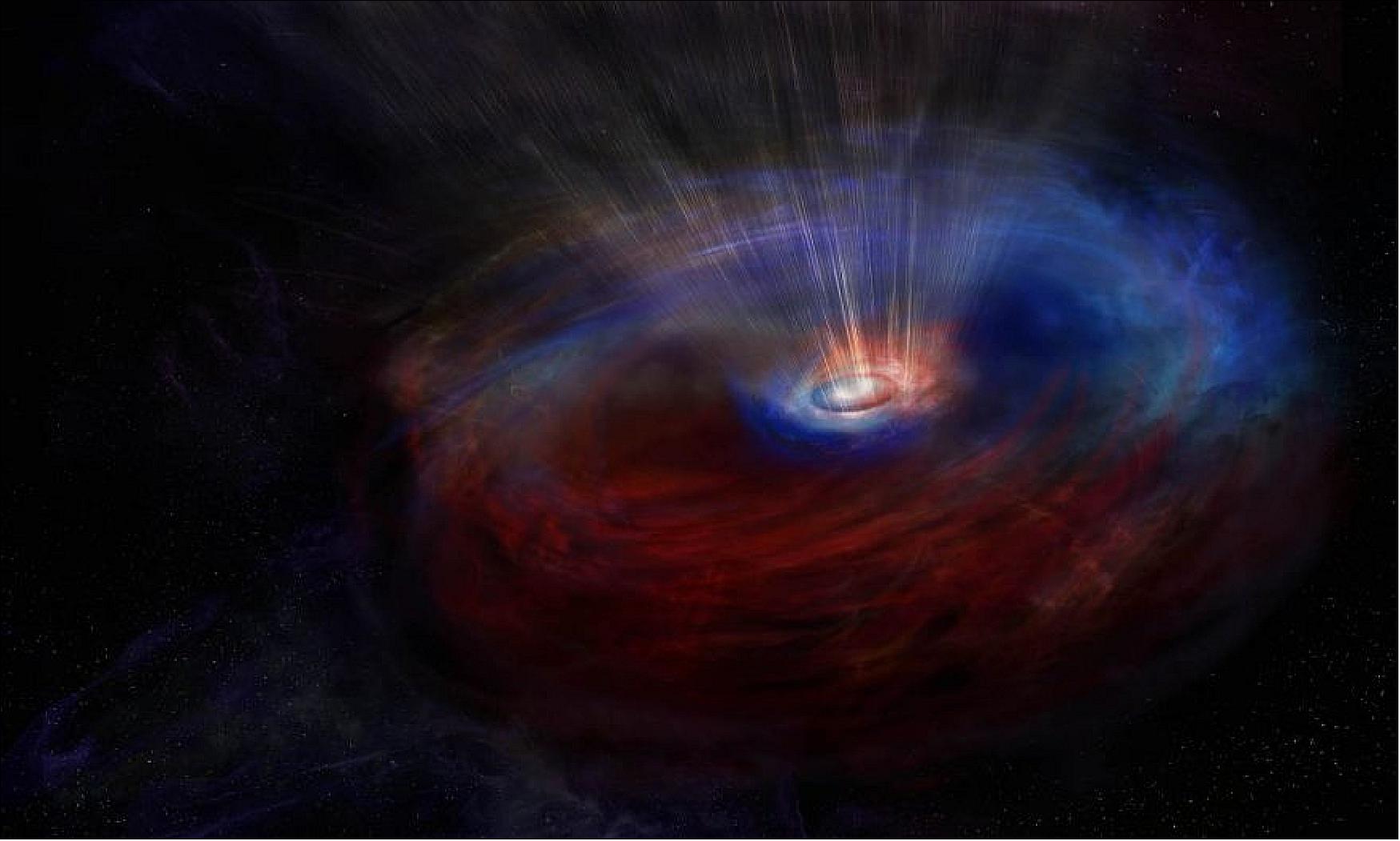
- “Thanks to the spectacular resolution of ALMA, we measured the movement of gas in the inner orbits around the black hole,” explains Violette Impellizzeri of the National Radio Astronomy Observatory (NRAO), working at ALMA in Chile and lead author on a paper published in the Astrophysical Journal. “Surprisingly, we found two disks of gas rotating in opposite directions.” 111)
- Supermassive black holes already existed when the Universe was young, just a billion years after the Big Bang. But how these extreme objects, whose masses are up to billions of times the mass of the Sun, had time to grow so fast, is an outstanding question among astronomers. This new ALMA discovery could provide a clue. “Counter-rotating gas streams are unstable, which means that clouds fall into the black hole faster than they do in a disk with a single rotation direction,” said Impellizzeri. “This could be a way in which a black hole can grow rapidly.”
- NGC 1068 (also known as Messier 77) is a spiral galaxy approximately 47 million light-years from Earth in the direction of the constellation Cetus. At its center is an active galactic nucleus, a supermassive black hole that is actively feeding itself from a thin, rotating disk of gas and dust, also known as an accretion disk.
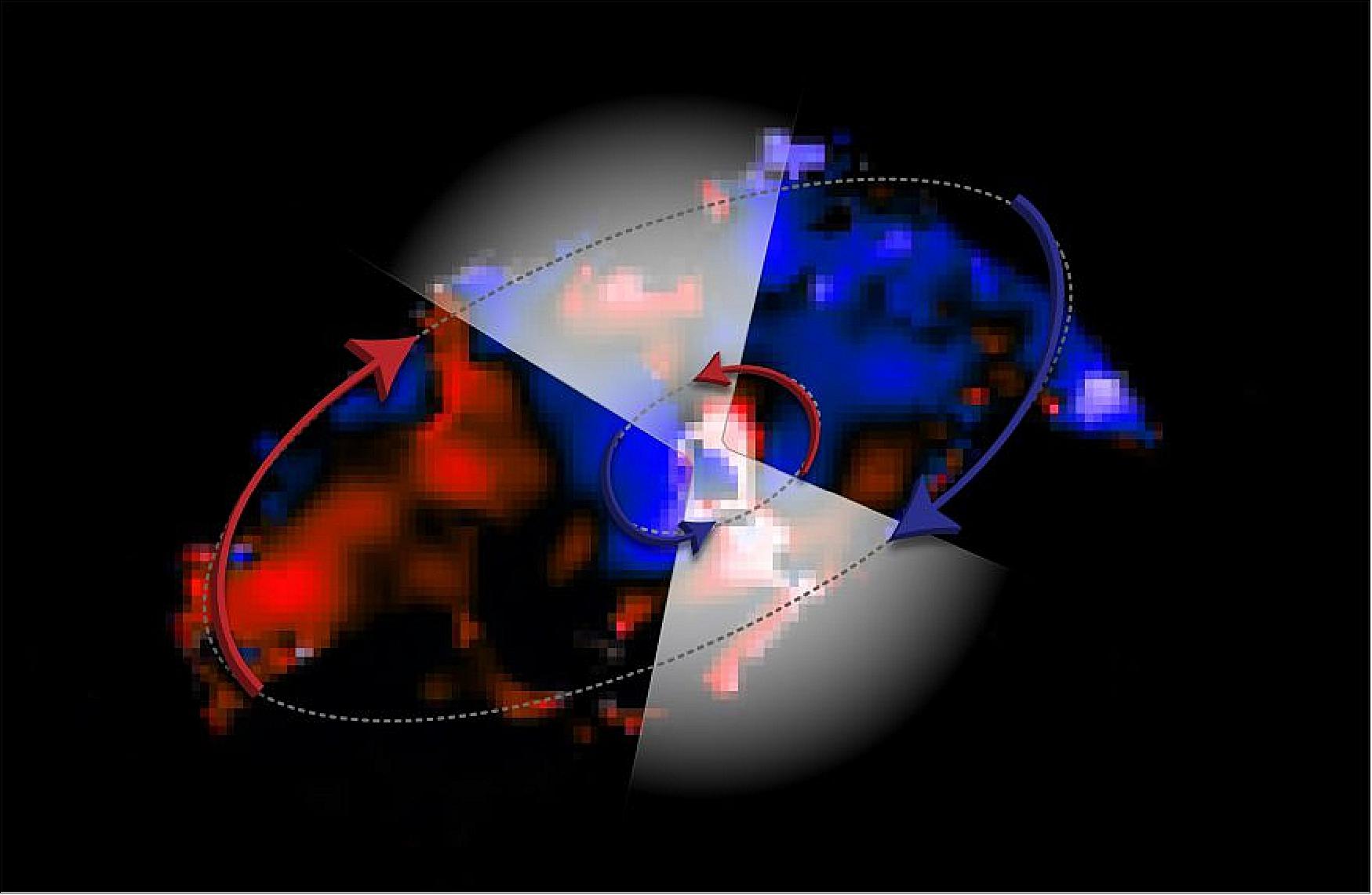
- Previous ALMA observations revealed that the black hole is gulping down material and spewing out gas at incredibly high speeds. This gas that gets expelled from the accretion disk likely contributes to hiding the region around the black hole from optical telescopes.
- Impellizzeri and her team used ALMA’s superior zoom lens ability to observe the molecular gas around the black hole. Unexpectedly, they found two counter-rotating disks of gas. The inner disk spans 2-4 light-years and follows the rotation of the galaxy, whereas the outer disk (also known as the torus) spans 4-22 light-years and is rotating the opposite way.
- “We did not expect to see this, because gas falling into a black hole would normally spin around it in only one direction,” said Impellizzeri. “Something must have disturbed the flow because it is impossible for a part of the disk to start rotating backward all on its own.”
- Counter-rotation is not an unusual phenomenon in space. “We see it in galaxies, usually thousands of light-years away from their galactic centers,” explained co-author Jack Gallimore from Bucknell University in Lewisburg, Pennsylvania. “The counter-rotation always results from the collision or interaction between two galaxies. What makes this result remarkable is that we see it on a much smaller scale, tens of light-years instead of thousands from the central black hole.”
- The astronomers think that the backward flow in NGC 1068 might be caused by gas clouds that fell out of the host galaxy, or by a small passing galaxy on a counter-rotating orbit captured in the disk.
- At the moment, the outer disk appears to be in a stable orbit around the inner disk. “That will change when the outer disk begins to fall onto the inner disk, which may happen after a few orbits or a few hundred thousand years. The rotating streams of gas will collide and become unstable, and the disks will likely collapse in a luminous event as the molecular gas falls into the black hole. Unfortunately, we will not be there to witness the fireworks,” said Gallimore.
• October 4, 2019: The two baby stars were found in the [BHB2007] 11 system – the youngest member of a small stellar cluster in the Barnard 59 dark nebula, which is part of the clouds of interstellar dust called the Pipe nebula. Previous observations of this binary system showed the outer structure. Now, thanks to the high resolution of the ALMA (Atacama Large Millimeter/submillimeter Array) and an international team of astronomers led by scientists from the Max Planck Institute for Extraterrestrial Physics (MPE) in Garching, Germany, we can see the inner structure of this object. 112)
- “We see two compact sources that we interpret as circumstellar disks around the two young stars,” explains Felipe Alves from MPE who led the study. A circumstellar disk is the ring of dust and gas that surrounds a young star. The star accrete matter from the ring to grow bigger. “The size of each of these disks is similar to the asteroid belt in our Solar System and the separation between them is 28 times the distance between the Sun and the Earth,” notes Alves.
- The two circumstellar disks are surrounded by a bigger disk with a total mass of about 80 Jupiter masses, which displays a complex network of dust structures distributed in spiral shapes – the pretzel loops. “This is a really important result,” stresses Paola Caselli, managing director at MPE, head of the Centre of Astrochemical Studies and co-author of the study. “We have finally imaged the complex structure of young binary stars with their feeding filaments connecting them to the disk in which they were born. This provides important constraints for current models of star formation.”
- The baby stars accrete mass from the bigger disk in two stages. The first stage is when mass is transferred to the individual circumstellar disks in beautiful twirling loops, which is what the new ALMA image showed. The data analysis also revealed that the less-massive but brighter circumstellar disk — the one in the lower part of the image — accretes more material. In the second stage, the stars accrete mass from their circumstellar disks. “We expect this two-level accretion process to drive the dynamics of the binary system during its mass accretion phase,” adds Alves. “While the good agreement of these observations with theory is already very promising, we will need to study more young binary systems in detail to better understand how multiple stars form.”
- This research was presented in a paper published on 3 October 2019 in the journal Science. 113)
- The team is composed of F. O. Alves (Center for Astrochemical Studies, Max Planck Institute for Extraterrestrial Physics, Garching, Germany), P. Caselli (Center for Astrochemical Studies, Max Planck Institute for Extraterrestrial Physics, Germany), J. M. Girart (Institut de Ciències de l’Espai, Consejo Superior de Investigaciones Científicas, Spain and Institut d’Estudis Espacials de Catalunya, Spain), D. Segura-Cox (Center for Astrochemical Studies, Max Planck Institute for Extraterrestrial Physics, Garching, Germany), G. A. P. Franco (Departamento de Física, Instituto de Ciências Exatas, Universidade Federal de Minas Gerais, Brazil), A. Schmiedeke (Center for Astrochemical Studies, Max Planck Institute for Extraterrestrial Physics, Garching, Germany) and B. Zhao (Center for Astrochemical Studies, Max Planck Institute for Extraterrestrial Physics, Garching, Germany).
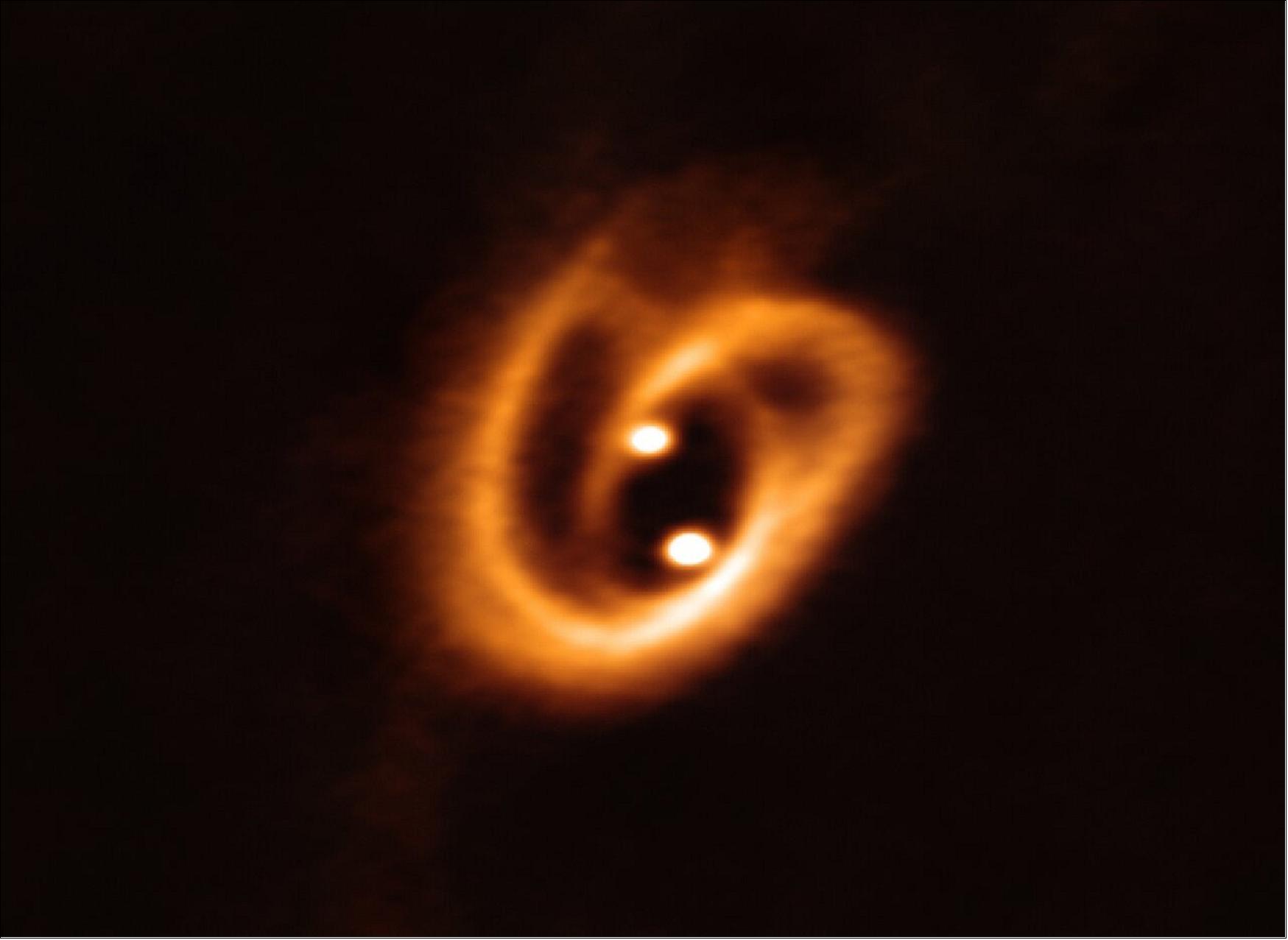
• September 30, 2019: Using the detailed eyes of the ALMA (Atacama Large Millimeter/submillimeter Array) and ESO’s VLT (Very Large Telescope), astronomers have mapped the intense tails of a cosmic jellyfish: a number of knotty streams of gas spewing outwards from a spiral galaxy named ESO 137-001. 114)
![Figure 84: This celestial cnidarian is shown here in beautiful detail. The various elements making up this image were captured by different telescopes. The galaxy and its surroundings were imaged by the NASA/ESA Hubble Space Telescope; its tails, which trace streams of hydrogen and show up in hues of bright purple, by the MUSE instrument mounted on the VLT; and bright hotspots of carbon dioxide emission from within the system, which show up as flares of orange-red, were spotted by ALMA [image credit: ALMA (ESO/NAOJ/NRAO), P. Jachym (Czech Academy of Sciences) et al.]](https://www.eoportal.org/ftp/satellite-missions/a/Alma_300622/Alma_Auto19.jpeg)
- These tails are caused by a dramatic phenomenon known as ram-pressure stripping. The space between galaxies in a cluster is not empty, but full of material that acts like a viscous fluid. As a galaxy travels through this resistant environment, gas is stripped out of the galaxy to form a wake that creates beautiful, intricate systems such as that seen here around ESO 137-001 (which resides in the Norma galaxy cluster). The direction and position of the tail shed light on the way in which the galaxy is moving — with galaxies usually falling towards the center of the cluster itself.
- This image offers the first high-resolution map of the cold molecular gas lurking within a ram-pressure stripped system. ESO 137-001 is one of the nearest jellyfish galaxies to Earth, and is particularly interesting because its long, extended tails of gas contain features known as ‘fireballs’: bursts of star formation. The precise mechanisms governing how stars form within jellyfish tails are mysterious, and this map thus provides a new window onto the conditions needed for new stars to form in such intense, changeable environments.
- The ALMA array comprises 66 antennas, and is located on the Chajinator plateau in the Chilean Atacama Desert at an altitude of 5000 meters. ALMA observes the night sky from this remote location to unlock the secrets of how the Universe — and its weird and wonderful residents, ESO 137-001 included — formed and evolved, revealing more about our cosmic origins.
• September 16, 2019: Star clusters are formed by the condensation of molecular clouds, masses of cold, dense gas that are found in every galaxy. The physical properties of these clouds in our own galaxy and nearby galaxies have been known for a long time. But are they identical in distant galaxies that are more than 8 billion light-years away? For the first time, an international team led by the University of Geneva (UNIGE) has been able to detect molecular clouds in a Milky Way progenitor, thanks to the unprecedented spatial resolution achieved in such a distant galaxy. 115)
- These observations, published in Nature Astronomy, show that the distant clouds have a higher mass, density and internal turbulence than the clouds hosted in nearby galaxies and that they produce far more stars. The astronomers attribute these differences to the ambient interstellar conditions in distant galaxies, which are too extreme for the molecular clouds typical of nearby galaxies to survive. 116)
- Molecular clouds consist of dense, cold molecular hydrogen gas that swirls around at supersonic velocities, generating density fluctuations that condense and form stars. In nearby galaxies, such as the Milky Way, a molecular cloud produces between 10+3 and 10+6 stars. In far-off galaxies, however, located more than 8 billion light-years away, astronomers have observed gigantic star clusters containing up to 100 times more stars. Why is there such a difference?
Exceptional Observation Made Possible Using a Cosmic Magnifying Glass
- To answer this question, the astronomers were able to make use of a natural telescope - the gravitational lens phenomenon - in combination with ALMA (Atacama Large Millimeter / Submillimeter Array), an interferometer made up of 50 millimetric radio antennas that reconstruct the entire image of a galaxy instantly.
- "Gravitational lenses are a natural telescope that produces a magnifying-glass effect when a massive object is aligned between the observer and the distant object," explains Miroslava Dessauges, a researcher in the Department of Astronomy in UNIGE's Faculty of Science and first author of the study.
- "With this effect, some parts of distant galaxies are stretched on the sky and can be studied at an unrivalled resolution of 90 light-years!" ALMA, meanwhile, can be employed to measure the level of carbon monoxide, which acts as a tracer of molecular hydrogen gas that constitutes the cold clouds.
- This resolution made it possible to characterize the molecular clouds individually in a distant galaxy, nicknamed the "Cosmic Snake", 8 billion light-years away. "It's the first time we've been able to pinpoint molecular clouds one from each other," says Daniel Schaerer, professor in UNIGE's Department of Astronomy.
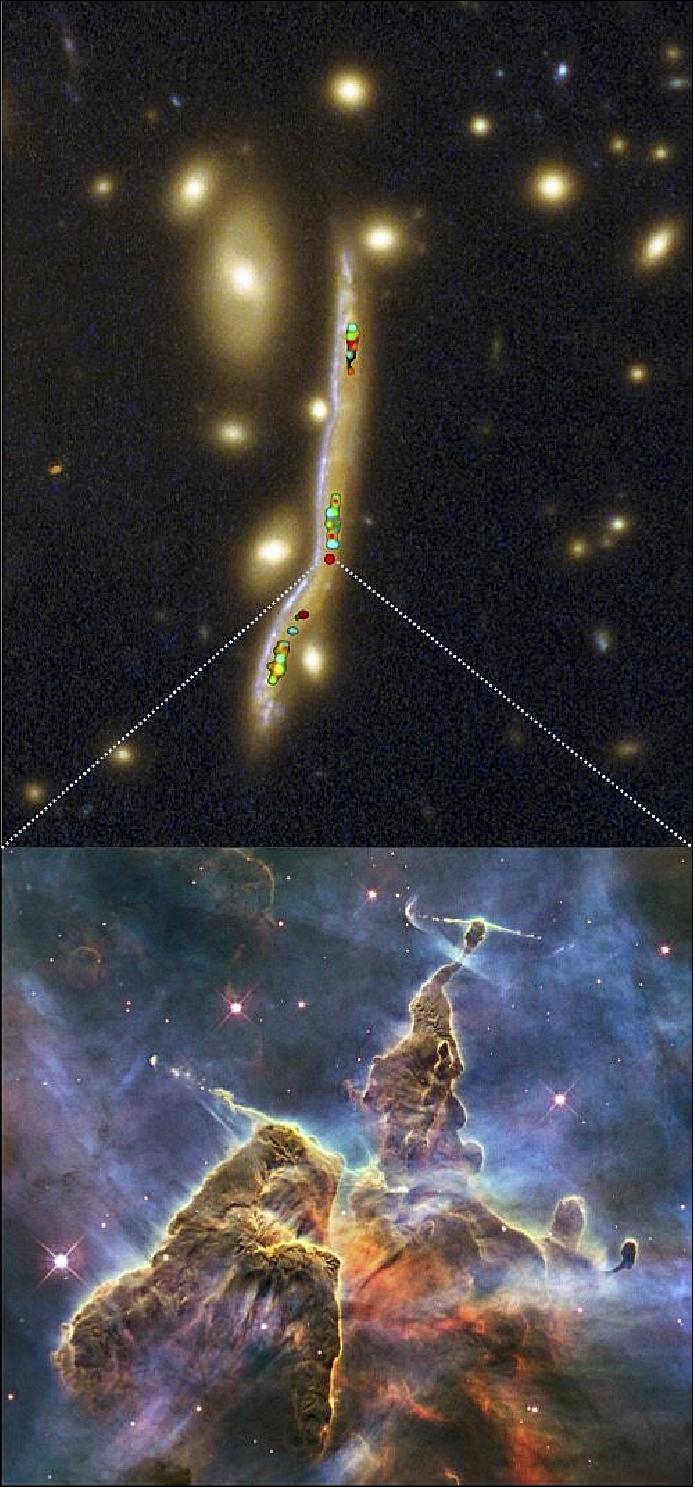
- The astronomers were therefore able to compare the mass, size, density and internal turbulence of molecular clouds in nearby and distant galaxies. "It was thought that the clouds had the same properties in all galaxies at all times, continues the Geneva-based researcher, but our observations have demonstrated the opposite!"
Molecular Clouds Resistant to Extreme Environments
- These new observations revealed that the molecular clouds in distant galaxies had a mass, density and turbulence 10 to 100 times higher than those in nearby galaxies. "Such values had only been measured in clouds hosted in nearby interacting galaxies, which have interstellar medium conditions resembling those of distant galaxies," adds Miroslava Dessauges.
- The researchers could link the differences in the physical properties of the clouds with the galactic environments, which are more extreme and hostile in far-off galaxies than in closer galaxies.
- "A molecular cloud typically found in a nearby galaxy would instantly collapse and be destroyed in the interstellar medium of distant galaxies, hence its enhanced density and turbulence guarantee its survival and equilibrium," explains Miroslava Dessauges.
- "The characteristic mass of the molecular clouds in the Cosmic Snake appears to be in perfect agreement with the predictions of our scenario of fragmentation of turbulent galactic disks. As a result, this scenario can be put forward as the mechanism of formation of massive molecular clouds in distant galaxies," adds Lucio Mayer, a professor at the Centre for Physical and Cosmological Theory at the University of Zurich.
- The international team also discovered that the efficiency of star formation in the Cosmic Snake galaxy is particularly high, likely triggered by the highly supersonic internal turbulence of the clouds. "In nearby galaxies, a molecular cloud forms about 5% of its mass in stars. In distant galaxies, this number climbs to 30%," observes Daniel Schaerer.
- The astronomers will now study other distant galaxies in order to confirm their observational results obtained for the Cosmic Snake. Miroslava Dessauges says in conclusion: "We'll also push the resolution even further by taking advantage of the unique performance of the ALMA interferometer. In parallel, we need to understand in more detail the ability of molecular clouds in distant galaxies to form stars so efficiently."
• September 13, 2019: Astronomers using one of the most advanced radio telescopes (ALMA) have discovered a rare molecule in the dust and gas disc around a young star — and it may provide an answer to one of the conundrums facing astronomers. 117)
- The star, named HD 163296, is located 330 light years from Earth and formed over the last six million years.
- It is surrounded by a disc of dust and gas — a so-called protoplanetary disc. It is within these discs that young planets are born. Using a radio telescope in the Atacama Desert in Chile, researchers were able to detect an extremely faint signal showing the existence of a rare form of carbon monoxide — known as an isotopologue (13C17O).
- The detection has allowed an international collaboration of scientists, led by the University of Leeds, to measure the mass of the gas in the disc more accurately than ever before. The results show that disc is much heavier — or more 'massive' — than previously thought.
- Alice Booth, a PhD researcher at Leeds who led the study, said: "Our new observations showed there was between two and six times more mass hiding in the disc than previous observations could measure.
- "This is an important finding in terms of the birth of planetary systems in discs — if they contain more gas, then they have more building material to form more massive planets."
- The study — The first detection of 13C17O in a protoplanetary disk: a robust tracer of disk gas mass — was published (12/09/2019) in the Astrophysical Journal Letters. 118)
- The scientists' conclusions are well timed. Recent observations of protoplanetary discs have perplexed astronomers because they did not seem to contain enough gas and dust to create the planets observed.
- Dr John Ilee, a researcher at Leeds who was also involved in the study, added: "The disc-exoplanet mass discrepancy raises serious questions about how and when planets are formed. However, if other discs are hiding similar amounts of mass as HD 163296, then we may just have underestimated their masses until now."
- "We can measure disc masses by looking at how much light is given off by molecules like carbon monoxide. If the discs are sufficiently dense, then they can block the light given off by more common forms of carbon monoxide -- and that could result in scientists underestimating the mass of the gas present. - This study has used a technique to observe the much rarer 13C17O molecule — and that's allowed us to peer deep inside the disc and find a previously hidden reservoir of gas."
- The researchers made use of one of the most sophisticated radio telescopes in the world — the ALMA (Atacama Large Millimeter/submillimeter Array) — high in the Atacama Desert.
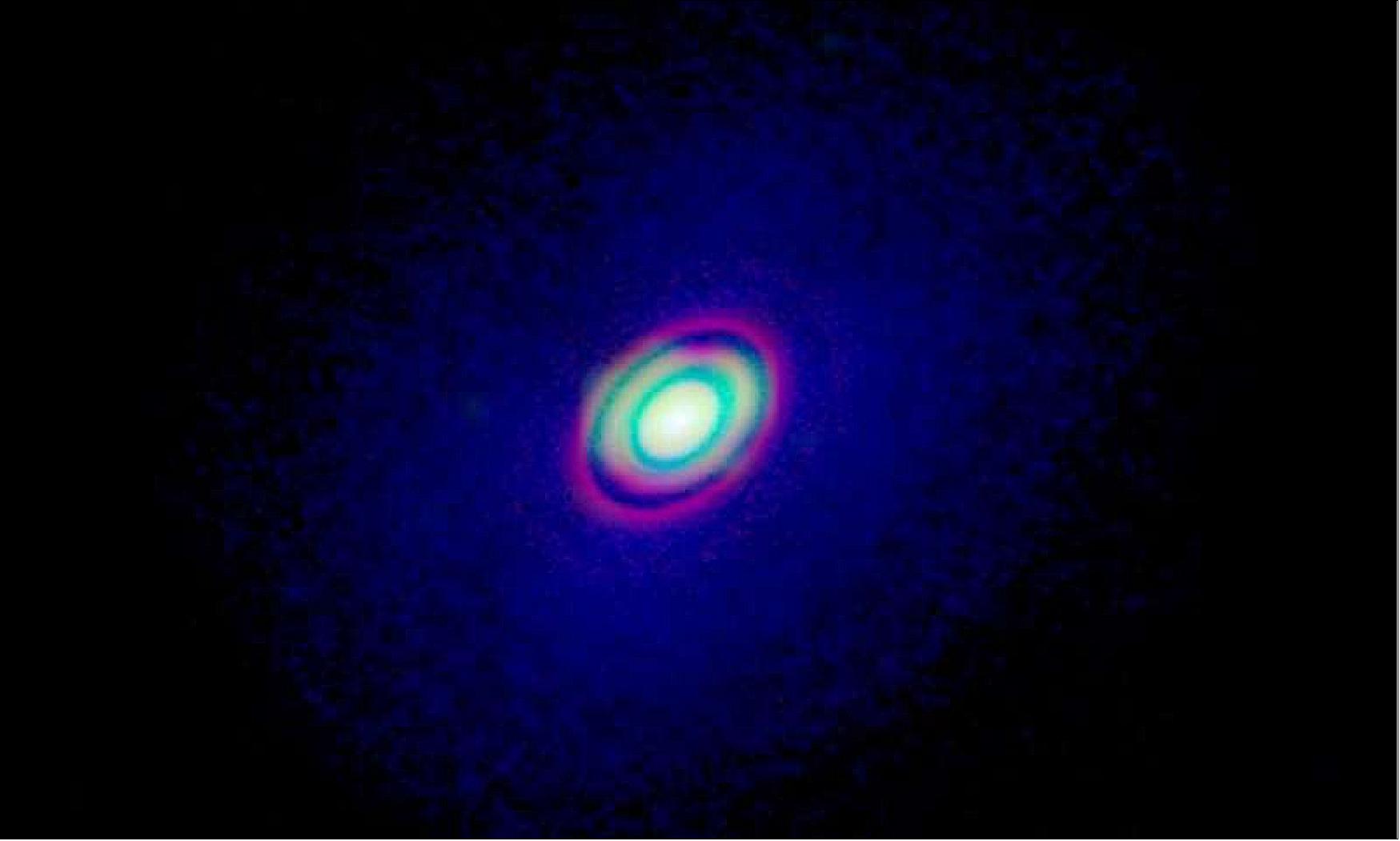
- ALMA is able to observe light that is invisible to the naked eye, allowing astronomers to view what is known as the 'cold universe' — those parts of space not visible using optical telescopes.
- Booth said: "Our work shows the amazing contribution that ALMA is making to our understanding of the Universe. It is helping build a more accurate picture of the physics leading to the formation of new planets. This of course then helps us understand how the Solar System and Earth came to be."
- The researchers are already planning the next steps in their work.
- Booth added: "We suspect that ALMA will allow us to observe this rare form of CO in many other discs. By doing that, we can more accurately measure their mass, and determine whether scientists have systematically been underestimating how much matter they contain."
• August 22, 2019: Swirling clouds, big colorful belts, giant storms. The beautiful and incredibly turbulent atmosphere of Jupiter has been showcased many times. But what is going on below the clouds? What is causing the many storms and eruptions that we see on the ‘surface’ of the planet? However, to study this, visible light is not enough. We need to study Jupiter using radio waves. 119) 120)
- New radio wave images made with the ALMA (Atacama Large Millimeter/submillimeter Array) observatory provide a unique view of Jupiter’s atmosphere down to fifty kilometers below the planet’s visible (ammonia) cloud deck.
- “ALMA enabled us to make a three-dimensional map of the distribution of ammonia gas below the clouds. And for the first time, we were able to study the atmosphere below the ammonia cloud layers after an energetic eruption on Jupiter,” said Imke de Pater of the University of California, Berkeley (EE. UU.).
- The atmosphere of giant Jupiter is made out of mostly hydrogen and helium, together with trace gases of methane, ammonia, hydrosulfide, and water. The top-most cloud layer is made up of ammonia ice. Below that is a layer of solid ammonia hydrosulfide particles, and deeper still, around 80 kilometers below the upper cloud deck, there likely is a layer of liquid water. The upper clouds form the distinctive brown belts and white zones seen from Earth.
- Many of the storms on Jupiter take place inside those belts. They can be compared to thunderstorms on Earth and are often associated with lightning events. Storms reveal themselves in visible light as small bright clouds, referred to as plumes. These plume eruptions can cause a major disruption of the belt, which can be visible for months or years.
- The ALMA images were taken a few days after amateur astronomers observed an eruption in Jupiter’s South Equatorial Belt in January 2017. A small bright white plume was visible first, and then a large-scale disruption in the belt was observed that lasted for weeks after the eruption.
- De Pater and her colleagues used ALMA to study the atmosphere below the plume and the disrupted belt at radio wavelengths and compared these to UV-visible light and infrared images made with other telescopes at approximately the same time.
- “Our ALMA observations are the first to show that high concentrations of ammonia gas are brought up during an energetic eruption,” said de Pater. “The combination of observations simultaneously at many different wavelengths enabled us to examine the eruption in detail. Which led us to confirm the current theory that energetic plumes are triggered by moist convection at the base of water clouds, which are located deep in the atmosphere. The plumes bring up ammonia gas from deep in the atmosphere to high altitudes, well above the main ammonia cloud deck,” she added.
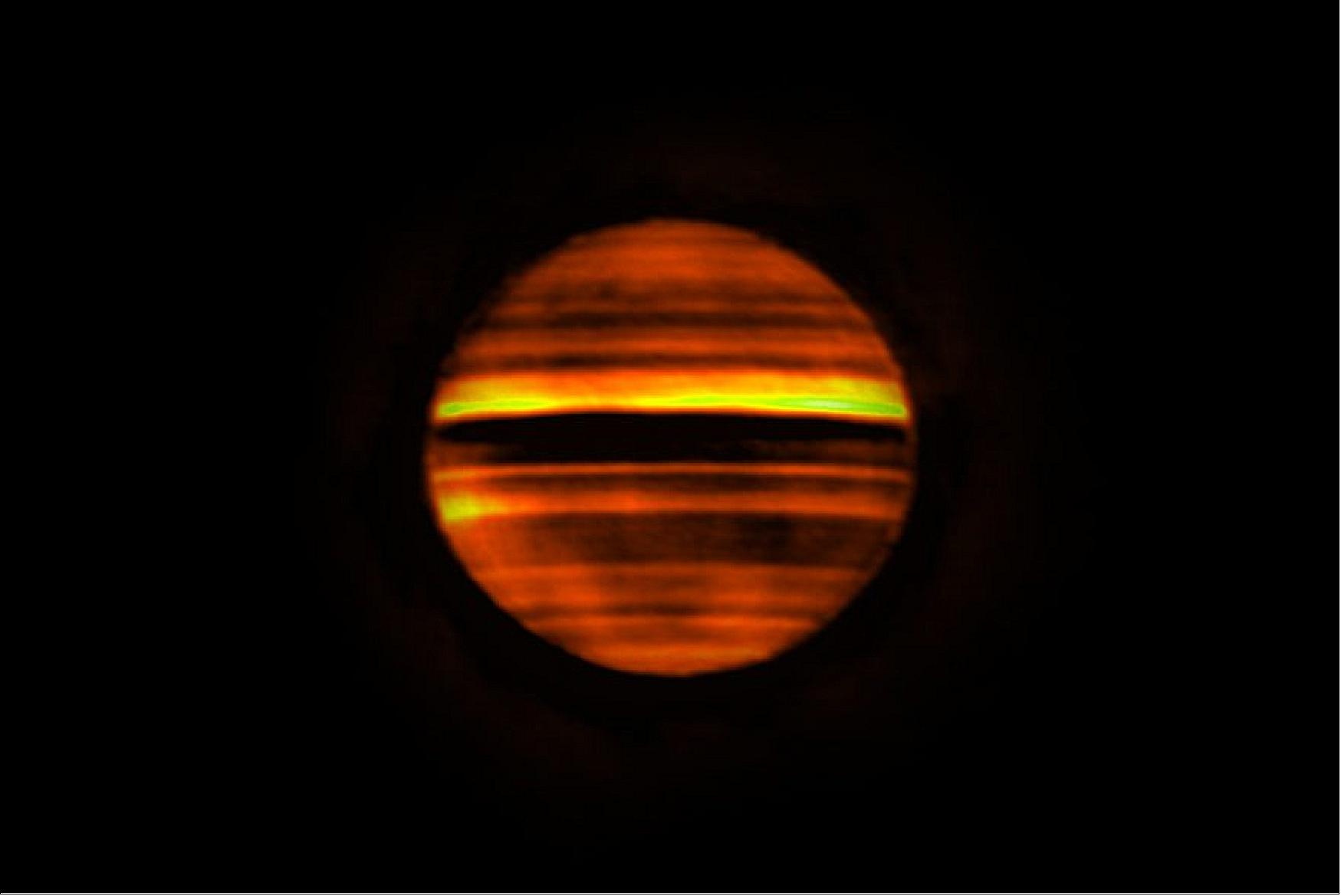
- “These ALMA maps at millimeter wavelengths complement the maps made with the National Science Foundation’s Very Large Array in centimeter wavelengths,” said Bryan Butler of the NRAO (National Radio Astronomy Observatory). “Both maps probe below the cloud layers seen at optical wavelengths and show ammonia-rich gases rising into and forming the upper cloud layers (zones), and ammonia-poor air sinking down (belts).”
- “The present results show superbly what can be achieved in planetary science when an object is studied with various observatories and at various wavelengths”. Explains Eric Villard, an ALMA astronomer part of the research team. “ALMA, with its unprecedented sensitivity and spectral resolution at radio wavelengths, worked together successfully with other major observatories around the world, to provide the data to allow a better understanding of the atmosphere of Jupiter.”
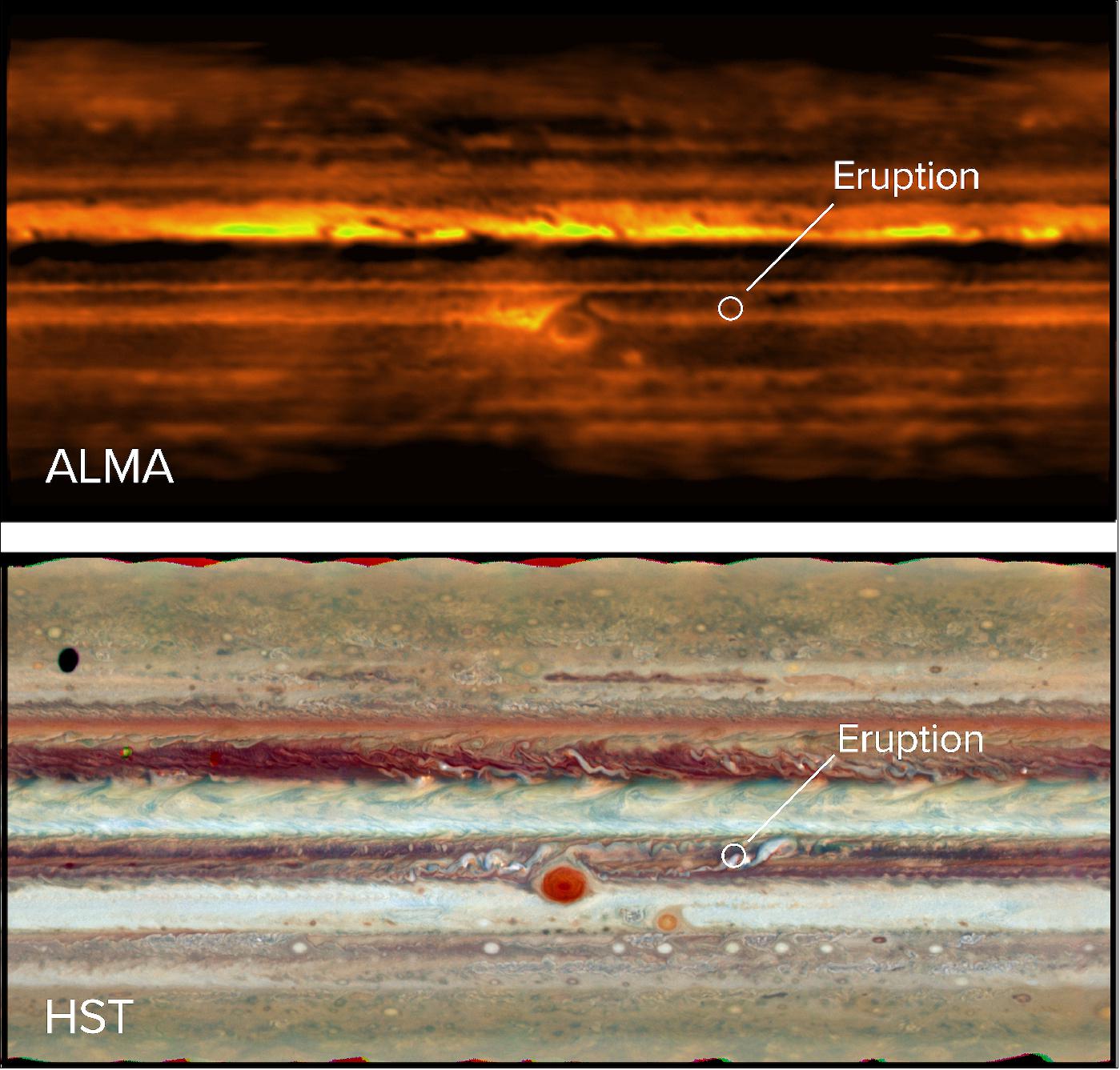
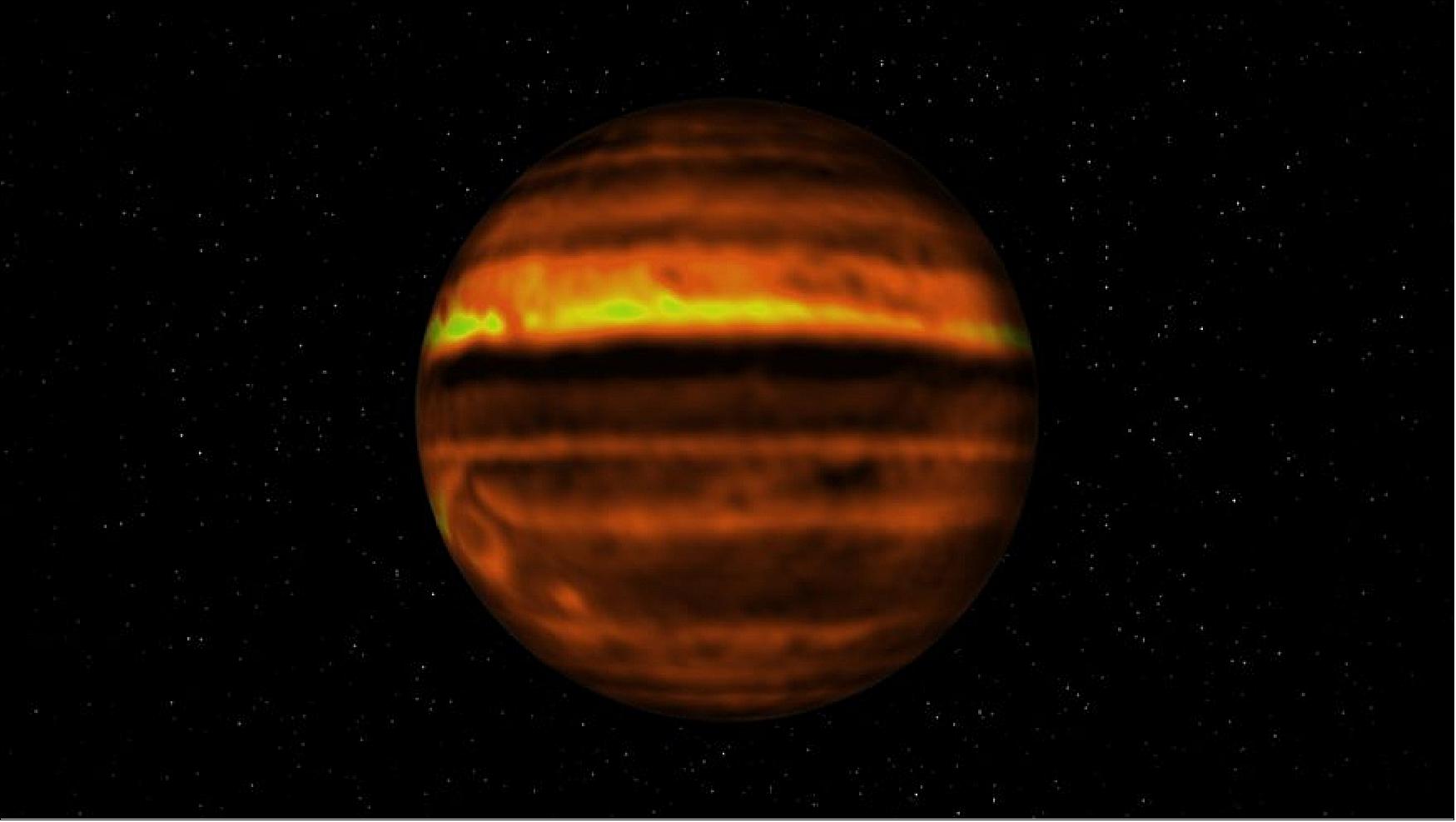
• June 17, 2019: Researchers using the Atacama Large Millimeter/submillimeter Array (ALMA) observed the earliest combined signals of oxygen, carbon, and dust from a galaxy in the Universe, 13 billion years ago. By comparing the different signals, the team determined that the galaxy is, in fact, two merging galaxies, making it the earliest example of merging galaxies yet discovered. 121)
- Takuya Hashimoto at Waseda University, Japan, and his team used ALMA to observe B14-65666, an object located 13 billion light-years away in the constellation Sextans. Because of the finite speed of light, the signals we receive from B14-65666 today had to travel for 13 billion years to reach us. In other words, they show us the image of what the galaxy looked like 13 billion years ago, less than 1 billion years after the Big Bang. 122)
- ALMA achieved the earliest observation of radio emissions from oxygen, carbon, and dust in B14-65666. The detection of multiple signals allows astronomers to retrieve complementary information.
- Data analysis showed that the emissions are divided into two blobs. Previous observations with the Hubble Space Telescope (HST) had revealed two-star clusters in B14-65666. Now, with the three emission signals detected by ALMA, the team was able to show that the two blobs do in-fact form a single system, but with different speeds; which indicates that the blobs are two merging galaxies. The earliest known example of merging galaxies. The research team estimated that the total stellar mass of B14-65666 is less than 10% that of the Milky Way, meaning that it’s in its earliest phases of evolution. Despite its youth, B14-65666 is producing stars 100 times more actively than the Milky Way. Such active star-formation rate is another signature of galactic mergers because the gas compression in colliding galaxies naturally leads to bursty star-formation.
- “With rich data from ALMA and HST, combined with advanced data analysis, we could put the pieces together to show that B14-65666 is a pair of merging galaxies in the earliest era of the Universe,” explains Hashimoto. “Detection of radio waves from three components in such a distant object demonstrates ALMA’s high capability to investigate the distant Universe.”
- Present galaxies like our Milky Way have experienced countless, often violent, mergers. Sometimes a more massive galaxy swallowed a smaller one. In rare cases, galaxies with similar sizes merged to form a new, larger galaxy. Mergers are essential for galaxy evolution, attracting many astronomers eager to trace back them.
- “Our next step is to search for nitrogen, another major chemical element, and even the carbon monoxide molecule,” said Akio Inoue, a professor at Waseda University. “Ultimately, we hope to observationally understand the circulation and accumulation of elements and material in the context of galaxy formation and evolution.”
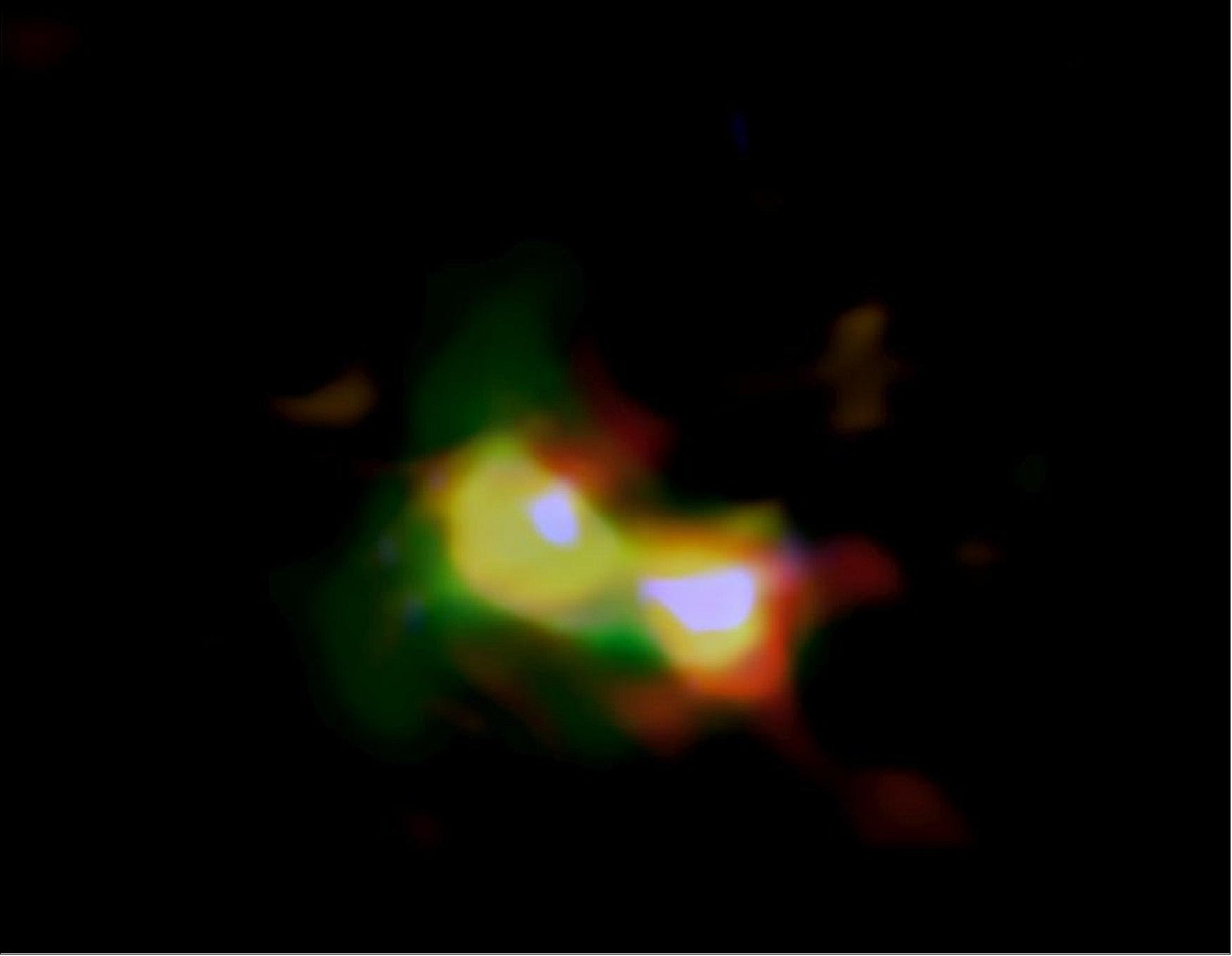
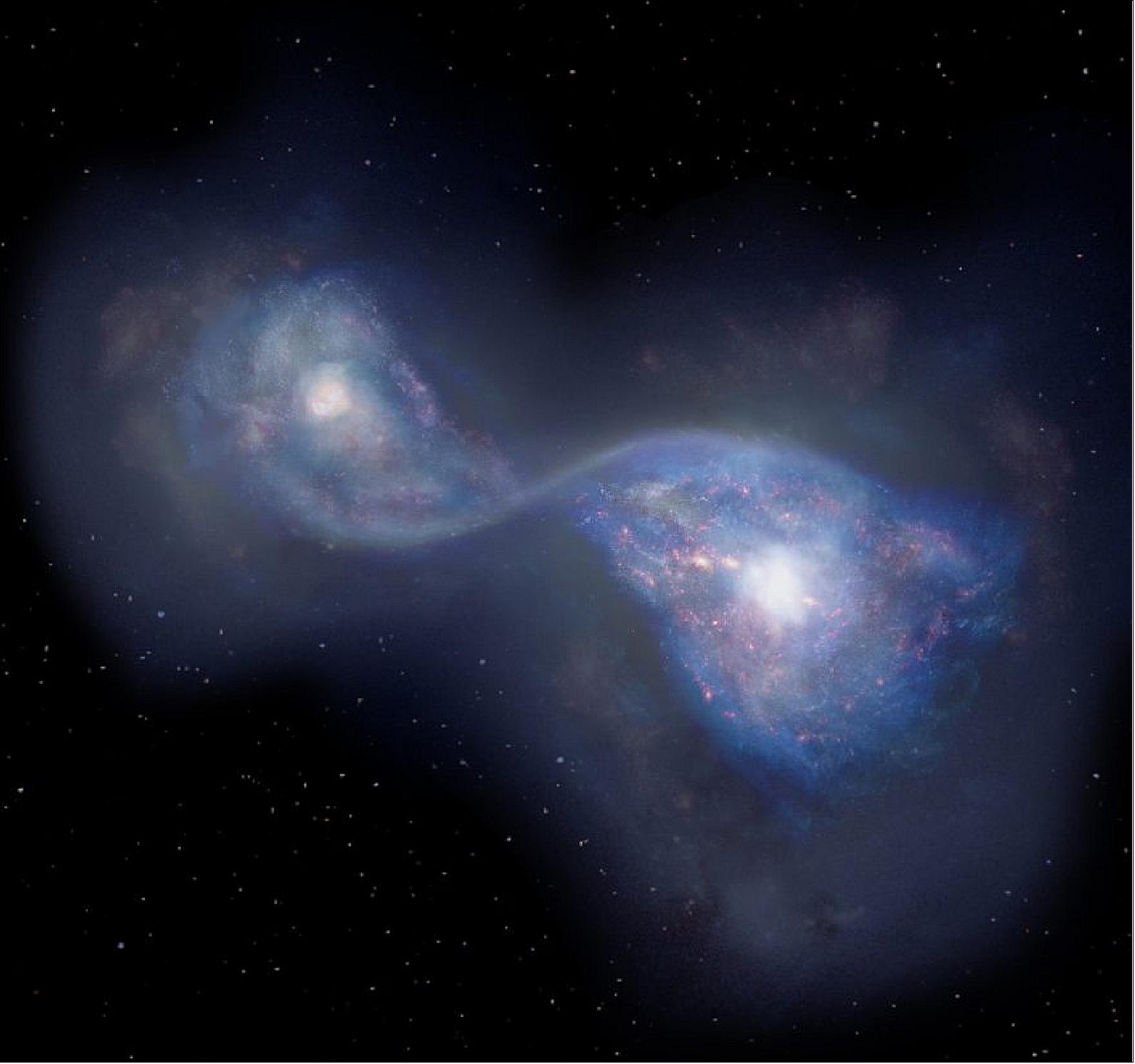
• May 10, 2019: Astronomers map the substance aluminum monoxide (AlO) in a cloud around a distant young star—Origin Source I. The finding clarifies some important details about how our solar system, and ultimately we, came to be. The cloud's limited distribution suggests AlO gas rapidly condenses to solid grains, which hints at what an early stage of our solar evolution looked like. 123) 124) 125)
- Professor Shogo Tachibana of the University of Tokyo Organization for Planetary and Space Science has a passion for space. From small things like meteorites to enormous things like stars and nebulae—huge clouds of gas and dust in space—he is driven to explore our solar system's origins.
- "I have always wondered about the evolution of our solar system, of what must have taken place all those billions of years ago," he said. "This question leads me to investigate the physics and chemistry of asteroids and meteorites."
- Space rocks of all kinds greatly interest astronomers as these rocks can remain largely unchanged since the time our sun and planets formed from a swirling cloud of gas and dust. They contain records of the conditions at that time—generally considered to be 4.56 billion years ago—and their properties such as composition can tell us about these early conditions.
- "On my desk is a small piece of the Allende meteorite, which fell to Earth in 1969. It's mostly dark but there are some scattered white inclusions (foreign bodies enclosed in the rock), and these are important," continued Tachibana. "These speckles are calcium and aluminum-rich inclusions (CAIs), which were the first solid objects formed in our solar system."
- Minerals present in CAIs indicate that our young solar system must have been extremely hot. Physical techniques for dating these minerals reveal a fairly specific age for the solar system. However, Tachibana and colleagues wished to expand on the details of this stage of evolution.

- "There are no time machines to explore our own past, so we wanted to see a young star that could share traits with our own," said Tachibana. "With the ALMA (Atacama Large Millimeter/submillimeter Array), we found the emission lines—a chemical fingerprint—for AlO in outflows from the circumstellar disk (gas and dust surrounding a star) of the massive young star candidate Orion Source I. It's not exactly like our sun, but it's a good start."
- ALMA was the ideal tool as it offers extremely high resolution and sensitivity to reveal the distribution of AlO around the star. No other instrument can presently make such observations.
- The team now plans to explore gas and solid molecules around other stars to gather data useful to further refine solar system models.
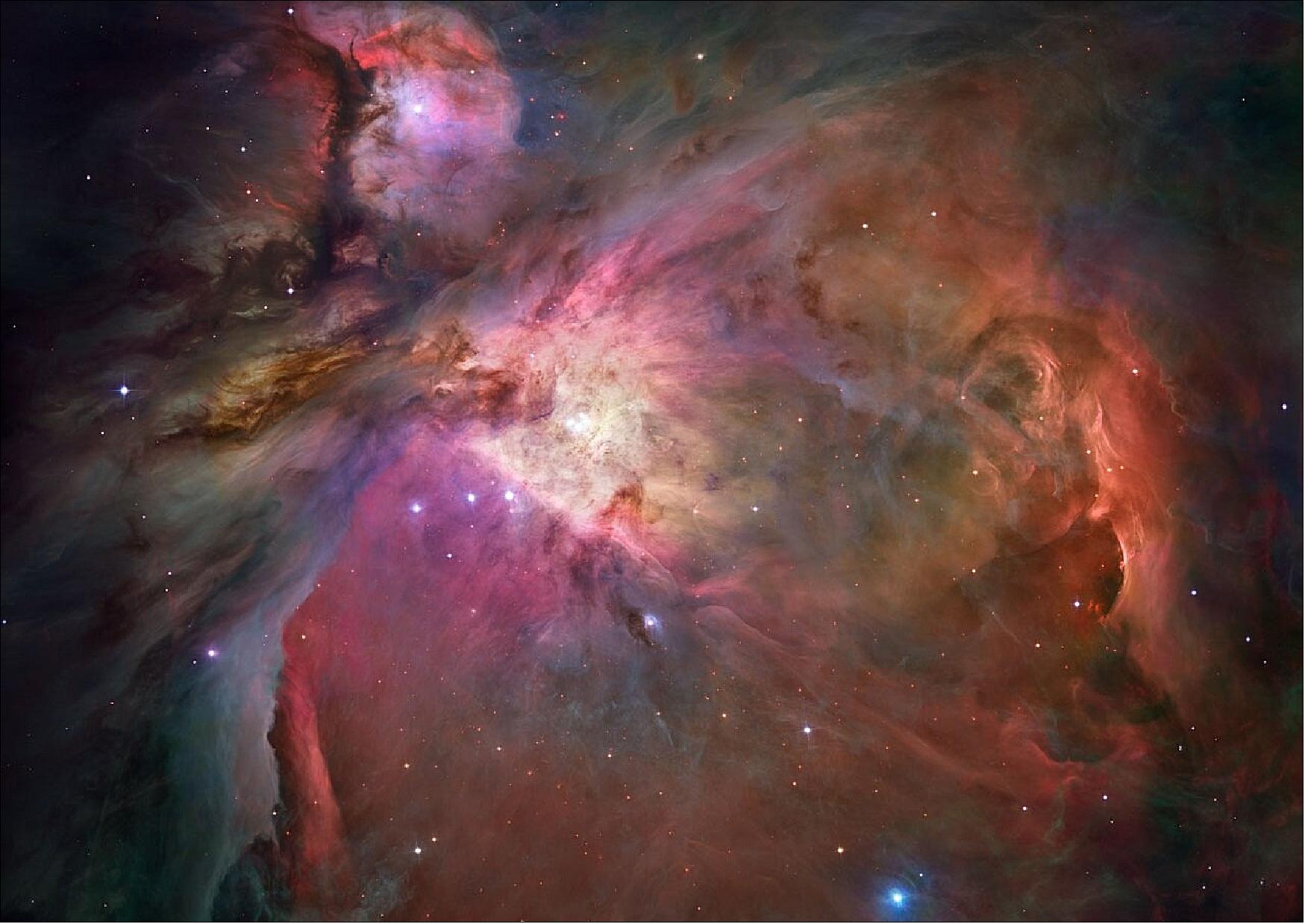
• March 19, 2019: Researchers have detected a radio signal from abundant interstellar dust in MACS0416_Y1, a galaxy 13.2 billion light-years away in the constellation Eridanus. Standard models can’t explain this much dust in a galaxy this young, forcing us to rethink the history of star formation. Researchers now think MACS0416_Y1 experienced staggered star formation with two intense starburst periods 300 million and 600 million years after the Big Bang with a quiet phase in between. 126) 127)
- Stars are the main players in the Universe, but they are supported by the unseen backstage stagehands: stardust and gas. Cosmic clouds of dust and gas are the sites of star formation and masterful storytellers of the cosmic history.
- “Dust and relatively heavy elements such as oxygen are disseminated by the deaths of stars,” said Yoichi Tamura, an associate professor at Nagoya University and the lead author of the research paper, “Therefore, a detection of dust at some point in time indicates that a number of stars have already formed and died well before that point.”
- Using ALMA (Atacama Large Millimeter/submillimeter Array), Tamura and his team observed the distant galaxy MACS0416_Y1. Because of the finite speed of light, the radio waves we observe from this galaxy today had to travel for 13.2 billion years to reach us. In other words, they provide an image of what the galaxy looked like 13.2 billion years ago, which is only 600 million years after the Big Bang.
- The astronomers detected a weak but telltale signal of radio emissions from dust particles in MACS0416_Y1. The HST (Hubble Space Telescope), the Spitzer Space Telescope, and the European Southern Observatory’s VLT (Very Large Telescope) have observed the light from stars in the galaxy; and from its color they estimate the stellar age to be 4 million years.
- “It ain’t easy,” said Tamura half-lost in a moonage daydream. “The dust is too abundant to have been formed in 4 million years. It is surprising, but we need to hang onto ourselves. Older stars might be hiding in the galaxy, or they may have died out and disappeared already.”
- “There have been several ideas proposed to overcome this dust budget crisis,” said Ken Mawatari, a researcher at the University of Tokyo. “However, no one is conclusive. We made a new model which doesn’t need any extreme assumptions diverging far from our knowledge of the life of stars in today’s Universe. The model well explains both the color of the galaxy and the amount of dust.” In this model, the first burst of star formation started at 300 million years and lasted 100 million years. After that, the star formation activity went quiet for a and then restarted at 600 million years. The researchers think ALMA observed this galaxy at the beginning of its second generation of star formation.
- “Dust is a crucial material for planets like Earth,” explains Tamura. “Our result is an important step forward for understanding the early history of the Universe and the origin of dust.”
![Figure 94: ALMA and Hubble Space Telescope (HST) image of the distant galaxy MACS0416_Y1. Distribution of dust and oxygen gas traced by ALMA are shown in red and green, respectively, while the distribution of stars captured by HST is shown in blue [image credit: ALMA (ESO/NAOJ/NRAO), NASA/ESA Hubble Space Telescope, Tamura, et al.]](https://www.eoportal.org/ftp/satellite-missions/a/Alma_300622/Alma_AutoF.jpeg)
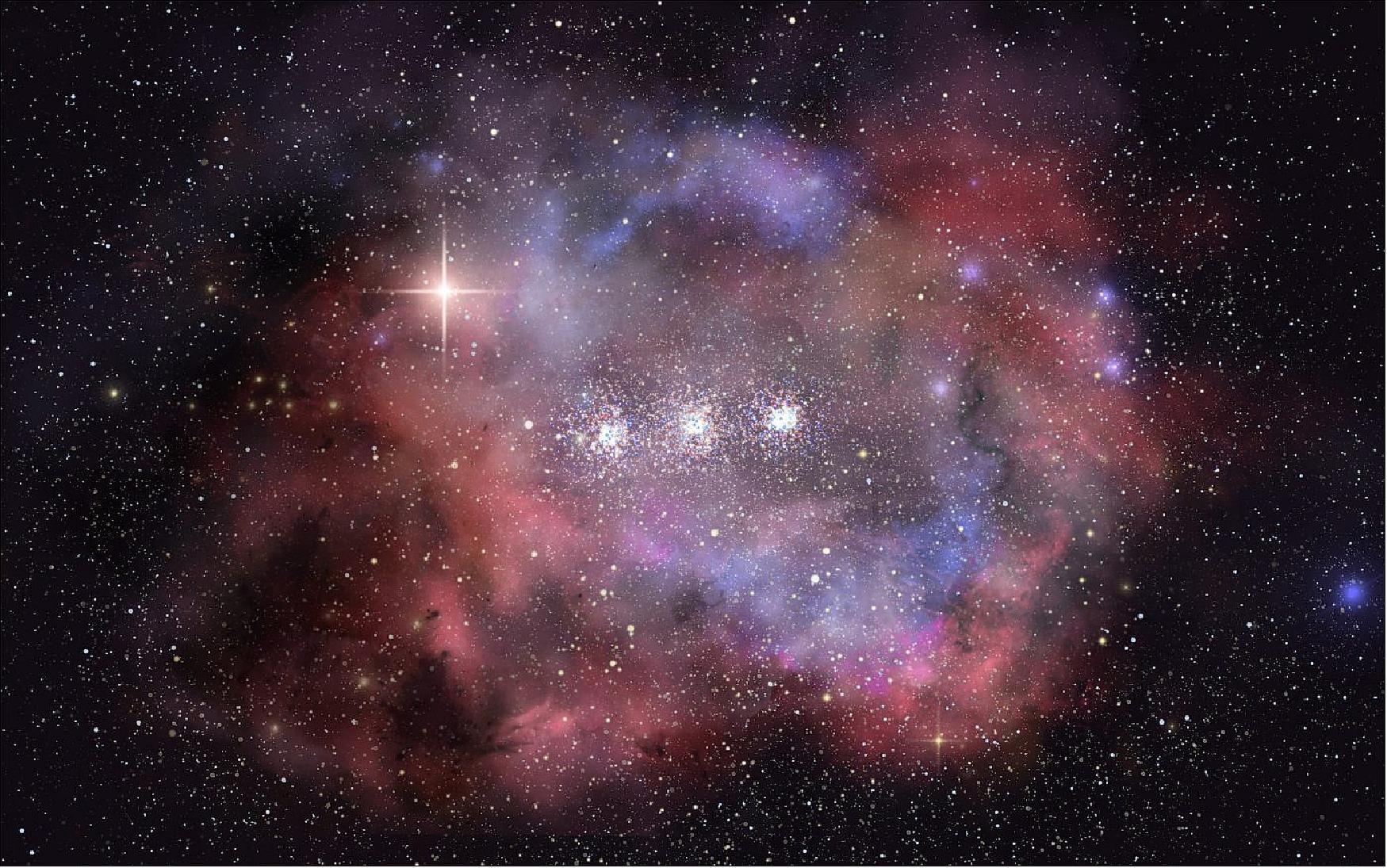
• March 18, 2019: Scientists from the RIKEN Cluster for Pioneering Research in Japan,the Chalmers University of Technology in Sweden,and the University of Virginia in the USA and collaborators used ALMA (Atacama Large Millimeter/submillimeter Array) to observe a molecular cloud that is collapsing to form two massive protostars that will eventually become a binary star system. 128)
- While it is known that most massive stars possess orbiting stellar companions it has been unclear how this comes about – for example, are the stars born together from a common spiraling gas disk at the center of a collapsing cloud, or do they pair up later by chance encounters in a crowded star cluster.
- Understanding the dynamics of forming binaries has been difficult because the protostars in these systems are still enveloped in a thick cloud of gas and dust that prevents most light from escaping. Fortunately, it is possible to see them using radio waves, as long as they can be imaged with sufficiently high spatial resolution.
- In the current research, published in Nature Astronomy, the researchers led by Yichen Zhang of the RIKEN Cluster for Pioneering Research and Jonathan C. Tan at the Chalmers University,and the University of Virginia, used ALMA to observe, at high spatial resolution, a star-forming region known as IRAS07299-1651, which is located 1.68 kpc (kiloparsec), or about 5,500 light years, away.
- The observations showed that already at this early stage, the cloud contains two objects, a massive “primary” central star and another “secondary” forming star, also of high mass. For the first time, the research team was able to use these observations to deduce the dynamics of the system. The observations showed that the two forming stars are separated by a distance of about 180 astronomical units—a unit approximately the distance from the earth to the sun. Hence, they are quite far apart. They are currently orbiting each other with a period of at most 600 years and have a total mass at least 18 times that of our Sun. 129)
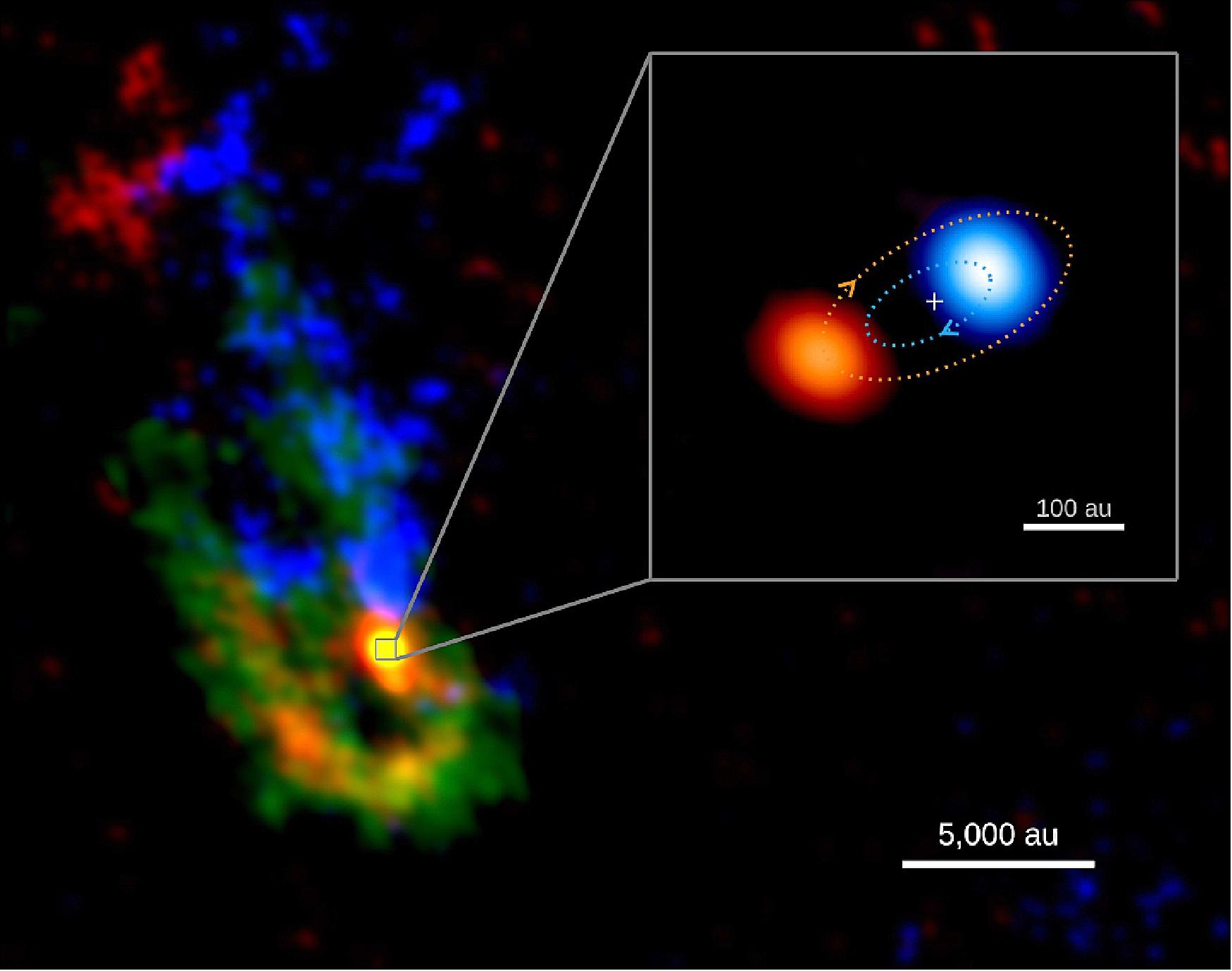
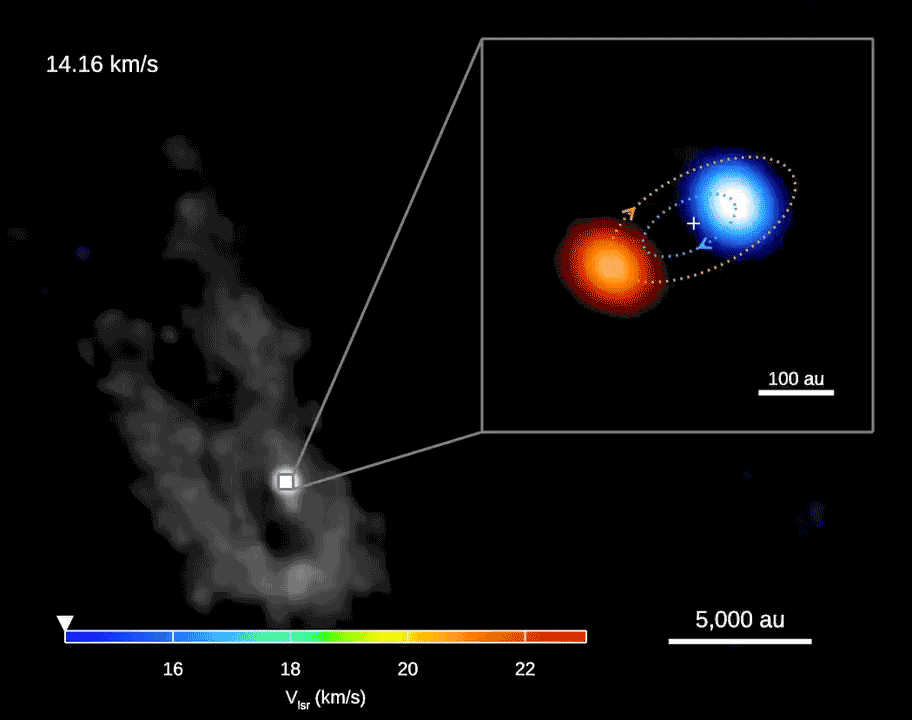
• March 13, 2019: Researchers have spotted the formation sites of planets around a young star resembling our Sun. Two rings of dust around the star, at distances comparable to the asteroid belt and the orbit of Neptune in our Solar System, suggest that we are witnessing the formation of a planetary system similar to our own. 130) 131)
- The Solar System is thought to have formed from a cloud of cosmic gas and dust 4.6 billion years ago. By studying young planetary systems forming around other stars, astronomers hope to learn more about our own origins.
- Tomoyuki Kudo, an astronomer at the National Astronomical Observatory of Japan (NAOJ), and his team observed the young star DM Tau using the Atacama Large Millimeter/submillimeter Array (ALMA). Located 470 light-years away in the constellation Taurus, DM Tau is about half the mass of the Sun and estimated to be three to five million years old.
- "Previous observations inferred two different models for the disk around DM Tau," said Kudo. "Some studies suggested the radius of the ring is about where the Solar System's asteroid belt would be. Other observations put the size out where Neptune would be. Our ALMA observations provided a clear answer: both are right. DM Tau has two rings, one at each location."
- The researchers found a bright patch in the outer ring. This indicates a local concentration of dust, which would be a possible formation site for a planet like Uranus or Neptune.
- "We are also interested in seeing the details in the inner region of the disk, because the Earth formed in such an area around the young Sun," commented Jun Hashimoto, a researcher at the Astrobiology Center, Japan. "The distribution of dust in the inner ring around DM Tau will provide crucial information to understand the origin of planets like Earth."
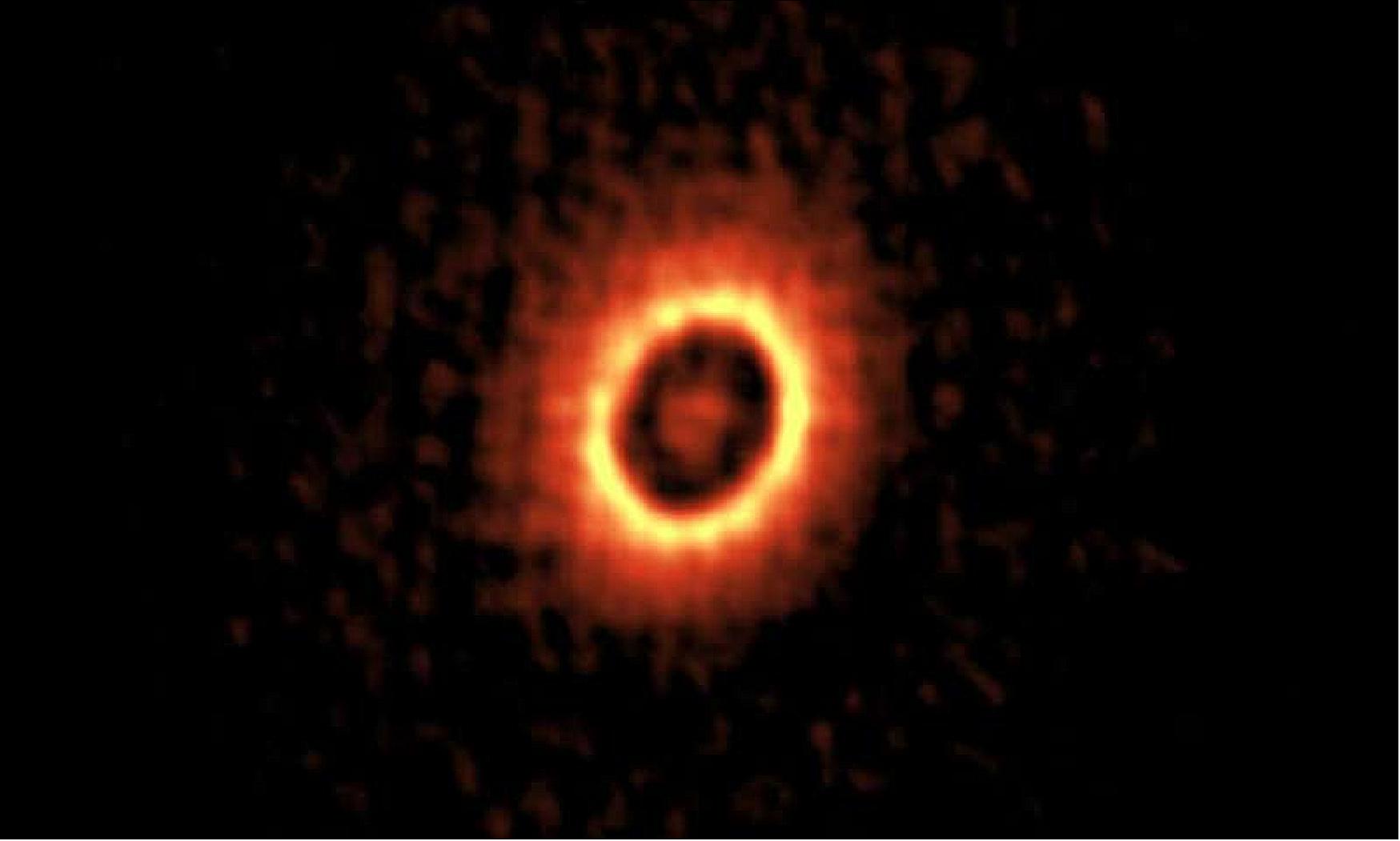
• February 28, 2019: Astronomers have detected a stealthy black hole from its effects on an interstellar gas cloud. This intermediate mass black hole is one of over 100 million quiet black holes expected to be lurking in our galaxy. These results provide a new method to search for other hidden black holes and help us understand the growth and evolution of black holes. 132) 133)
- Black holes are objects with such strong gravity that everything, including light, is sucked in and cannot escape. Because black holes do not emit light, astronomers must infer their existence from the effects their gravity produce in other objects. Black holes range in mass from about 5 times the mass of the Sun to supermassive black holes millions of times the mass of the Sun. Astronomers think that small black holes merge and gradually grow into large ones, but no one had ever found an intermediate mass, hundreds or thousands of times the mass of the Sun.
- A research team led by Shunya Takekawa at the National Astronomical Observatory of Japan noticed HCN–0.009–0.044, a gas cloud moving strangely near the center of the Galaxy 25,000 light-years away from Earth in the constellation Sagittarius. They used ALMA (Atacama Large Millimeter/submillimeter Array) to perform high resolution observations of the cloud and found that it is swirling around an invisible massive object.
- Takekawa explains, “Detailed kinematic analyses revealed that an enormous mass, 30,000 times that of the Sun, was concentrated in a region much smaller than our Solar System. This and the lack of any observed object at that location strongly suggests an intermediate-mass black hole. By analyzing other anomalous clouds, we hope to expose other quiet black holes.”
- Tomoharu Oka, a professor at Keio University and coleader of the team, adds, “It is significant that this intermediate mass black hole was found only 20 light-years from the supermassive black hole at the Galactic center. In the future, it will fall into the supermassive black hole; much like gas is currently falling into it. This supports the merger model of black hole growth.”
![Figure 99: Artist’s impression of a gas cloud swirling around a black hole [image credit: NAOJ (National Astronomical Observatory of Japan)]](https://www.eoportal.org/ftp/satellite-missions/a/Alma_300622/Alma_AutoB.jpeg)
• February 26, 2019: Astronomers have unveiled the enigmatic origins of two different gas streams from a baby star. Using ALMA, they found that the slow outflow and the high speed jet from a protostar have misaligned axes and that the former started to be ejected earlier than the latter. The origins of these two flows have been a mystery, but these observations provide telltale signs that these two streams were launched from different parts of the disk around the protostar. 134)
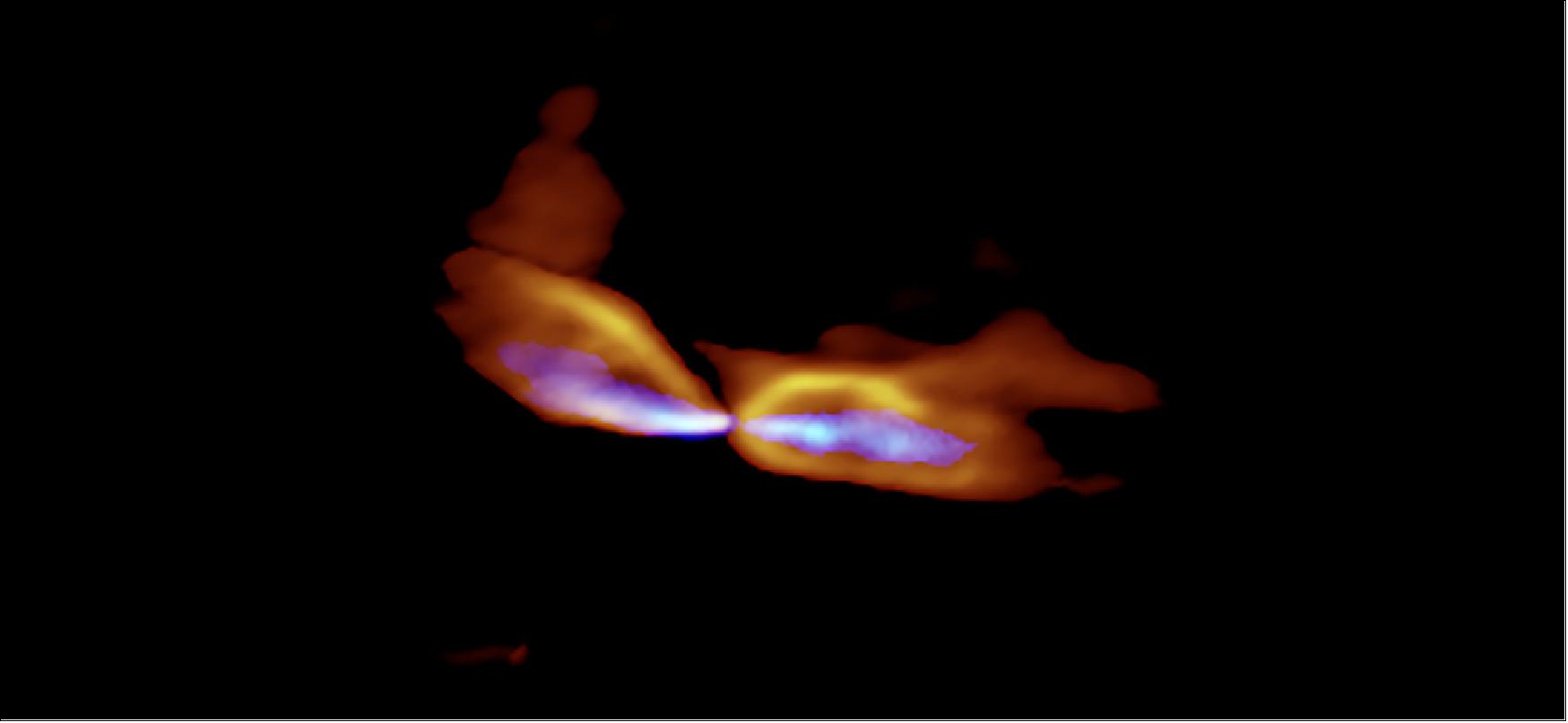
- Stars in the Universe have a wide range of masses, ranging from hundreds of times the mass of the Sun to less than a tenth of that of the Sun. To understand the origin of this variety, astronomers study the formation process of the stars, that is the aggregation of cosmic gas and dust.
- Baby stars collect the gas with their gravitational pull, however, some of the material is ejected by the protostars. This ejected material forms a stellar birth cry which provides clues to understand the process of mass accumulation.
- Yuko Matsushita, a graduate student at Kyushu University and her team used ALMA to observe the detailed structure of the birth cry from the baby star MMS5/OMC-3 and found two different gaseous flows: a slow outflow and a fast jet. There have been a handful of examples with two flows seen in radio waves, but MMS5/OMC-3 is exceptional.
- “Measuring the Doppler shift of the radio waves, we can estimate the speed and lifetime of the gas flows,” said Matsushita, the lead author of the research paper that appeared in the Astrophysical Journal. “We found that the jet and outflow were launched 500 years and 1300 years ago, respectively. These gas streams are quite young.”
- More interestingly, the team found that the axes of the two flows are misaligned by 17 degrees. The axis of the flows can be changed over long time periods due to the precession of the central star. But in this case, considering the extreme youth of the gas streams, researchers concluded that the misalignment is not due to precession but is related to the launching process.
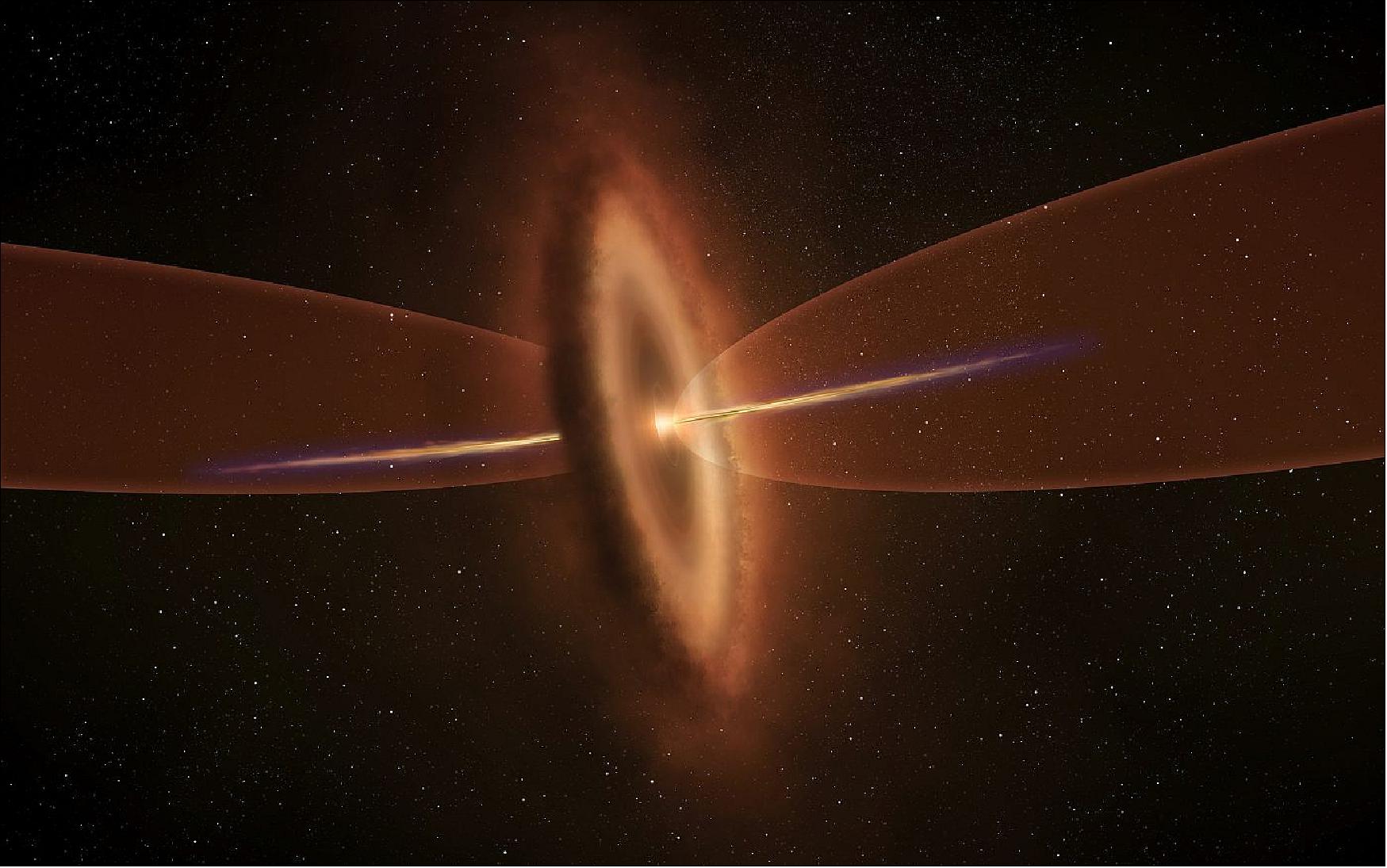
- There are two competing models for the formation mechanism of the protostellar outflows and jets. Some researchers assume that the two streams are formed independently in different parts of the gas disk around the central baby star, while others propose that the collocated jet is formed first, then it entrains the surrounding material to form the slower outflows. Despite extensive research, astronomers had not yet reached a conclusive answer.
- A misalignment in the two flows could occur in the ‘independent model,’ but is difficult in the ‘entrainment model.’ Moreover, the team found that the outflow was ejected considerably earlier than the jet. This clearly backs the ‘independent model.’
- “The observation well matches the result of my simulation,” said Masahiro Machida, a professor at Kyushu University. A decade ago, he performed pioneering simulation studies using a supercomputer operated by the National Astronomical Observatory of Japan. In the simulation, the wide-angle outflow is ejected from the outer area of the gaseous disk around a protostar, while the collimated jet is launched independently from the inner area of the disk. Machida continues, “An observed misalignment between the two gas streams may indicate that the disk around the protostar is warped.”
- “ALMA’s high sensitivity and high angular resolution will enable us to find more and more young, energetic outflow-and-jet-systems like MMS 5/OMC-3,” said Satoko Takahashi, an astronomer at the National Astronomical Observatory of Japan and the Joint ALMA Observatory and co-author of the paper. “They will provide clues to understand the driving mechanisms of outflows and jets. Moreover studying such objects will also tell us how the mass accretion and ejection processes work at the earliest stage of star formation.” 135)
• February 25, 2019: Red giants are old stars that eject gaseous material and solid particles through a stellar wind. Some red giants appeared to lose an exceptionally large amount of mass this way. However, new observations reveal that this is not quite the case. The stellar wind is not more intense than normal, but is affected by a partner that was overlooked until now—a second star that circles the red giant. These are the results of an international study led by Belgian university KU (Katholieke Universiteit) Leuven. 136)
- Humans don't live long enough to realize it, but stars are also born, they age, and they die. It's a process that takes billions of years. As a star gets older, it becomes bigger, colder, and redder - hence the name 'red giants'. Our sun will also become such a red giant in four and a half billion years.
- In the final stage of their life, red giants eject their mass - gas and other matter - in the form of a stellar wind. Earlier observations confirmed that red giants lose a lot of mass this way.
- Twelve mass-loss rate record holders, in particular, have been baffling scientists for decades. These red giants supposedly eject the equivalent of 100 earths per year for 100 to 2,000 years on end. Even astronomically speaking, that's a lot of matter in a short amount of time.
- This was difficult to explain, says Professor Leen Decin from the KU Leuven Institute of Astronomy: "If you look at the mass of such a star in the next phase of its life, the intense stellar wind doesn't last long enough to account for the mass loss that we've seen. It was also statistically improbable that we had discovered twelve of these red giants, knowing that what we were seeing was a phase that lasted only hundreds or thousands of years compared with their billion-year-long life. It's like finding a needle in a haystack twelve times."
- New observations from the ALMA telescope in Chile shed light on what was happening with two of these red giants. "For these stars, the stellar wind forms a spiral. It's an indirect indication that the red giant is not alone, but part of a binary star system. The red giant is the main star with a second star circling it. Both stars affect each other and their environment gravitationally in two ways: on the one hand, the stellar wind is pulled in the direction of the second star and, on the other hand, the red giant itself also wiggles slightly. These movements give the stellar wind a spiral shape."
- The discovery of a partner star made everything fall into place, says Decin: "We believed that these red giants were record holders for mass-loss rate, but that's not the case. It only seemed as though they were losing a lot of mass because there's an area between the two stars where the stellar wind is much more concentrated due to the gravity of the second star. These red giants don't lose the equivalent of 100 earths per year, but rather 10 of them - just like the regular red giants. As such, they also die a bit more slowly than we first assumed. To rephrase in a positive way: these old stars live longer than we thought."
- The astronomers are now investigating whether a system with a binary star could also be the explanation for other special red giants. "We believed that many stars lived alone, but we will probably have to adjust this idea. A star with a partner is likely to be more common than we thought," Decin concludes.
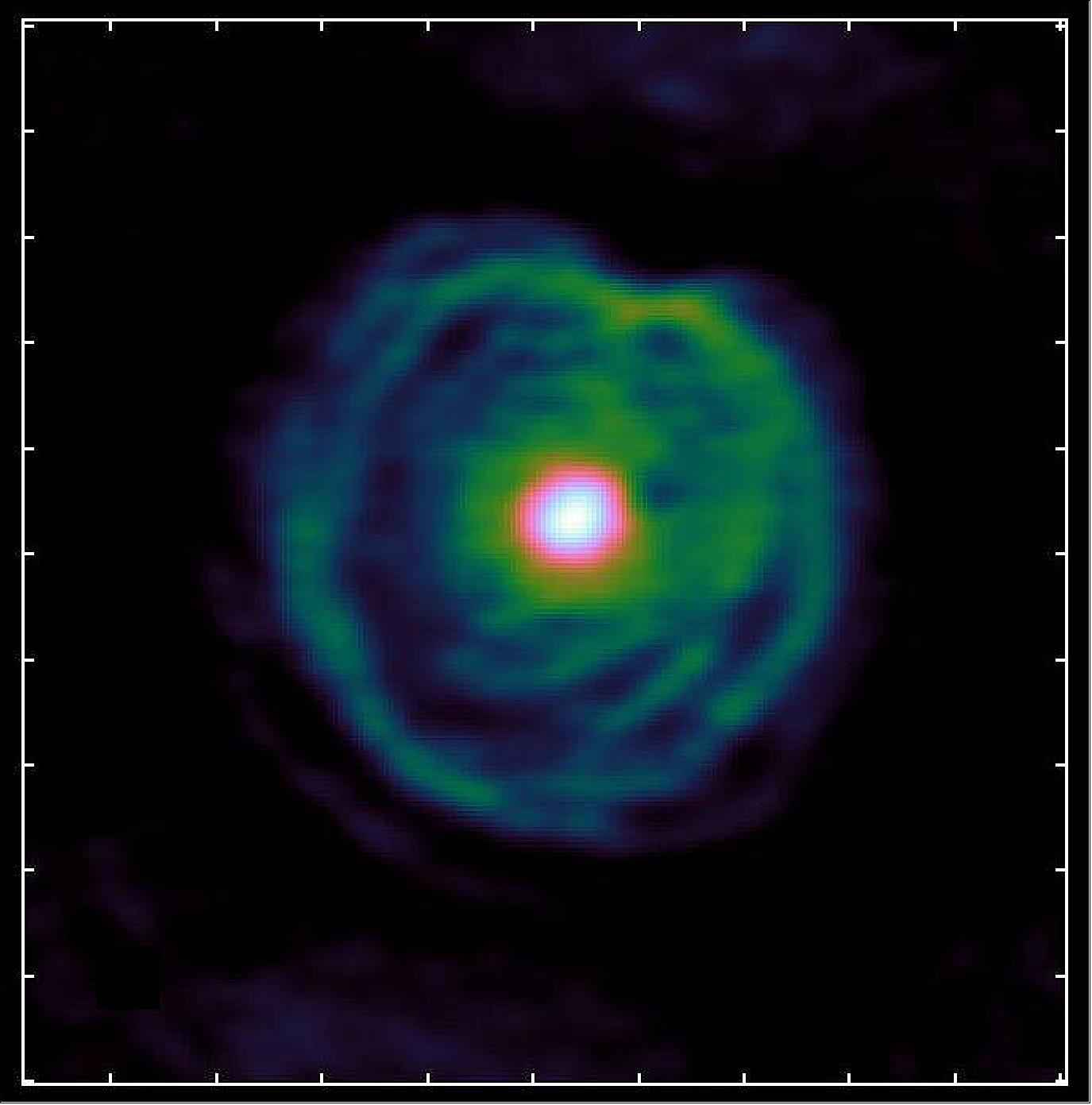
• February 7, 2019: A team of astronomers and chemists using ALMA has detected the chemical fingerprints of sodium chloride (NaCl) and other similar salty compounds emanating from the dusty disk surrounding Orion Source I, a massive, young star in a dusty cloud behind the Orion Nebula. 138)
- “It’s amazing we’re seeing these molecules at all,” said Adam Ginsburg, a Jansky Fellow of the National Radio Astronomy Observatory (NRAO) in Socorro, New Mexico, and lead author of a paper accepted for publication in the Astrophysical Journal. “Since we’ve only ever seen these compounds in the sloughed-off outer layers of dying stars, we don’t fully know what our new discovery means. The nature of the detection, however, shows that the environment around this star is very unusual.”
- To detect molecules in space, astronomers use radio telescopes to search for their chemical signatures – telltale spikes in the spread-out spectra of radio and millimeter-wavelength light. Atoms and molecules emit these signals in several ways, depending on the temperature of their environments.
- The new ALMA observations contain a bristling array of spectral signatures – or transitions, as astronomers refer to them – of the same molecules. To create such strong and varied molecular fingerprints, the temperature differences where the molecules reside must be extreme, ranging anywhere from 100 kelvin to 4,000 kelvin (about -175 Celsius to 3700 Celsius). An in-depth study of these spectral spikes could provide insights about how the star is heating the disk, which would also be a useful measure of the luminosity of the star.
- “When we look at the information ALMA has provided, we see about 60 different transitions – or unique fingerprints – of molecules like sodium chloride and potassium chloride coming from the disk. That is both shocking and exciting,” said Brett McGuire, a chemist at the NRAO in Charlottesville, Virginia, and co-author on the paper.
- The researchers speculate that these salts come from dust grains that collided and spilled their contents into the surrounding disk. Their observations confirm that the salty regions trace the location of the circumstellar disk.
- “Usually when we study protostars in this manner, the signals from the disk and the outflow from the star get muddled, making it difficult to distinguish one from the other,” said Ginsburg. “Since we can now isolate just the disk, we can learn how it is moving and how much mass it contains. It also may tell us new things about the star.”
- The detection of salts around a young star is also of interest to astronomers and astrochemists because some of constituent atoms of salts are metals – sodium and potassium. This suggests there may be other metal-containing molecules in this environment. If so, it may be possible to use similar observations to measure the amount of metals in star-forming regions. “This type of study is not available to us at all presently. Free-floating metallic compounds are generally invisible to radio astronomy,” noted McGuire.
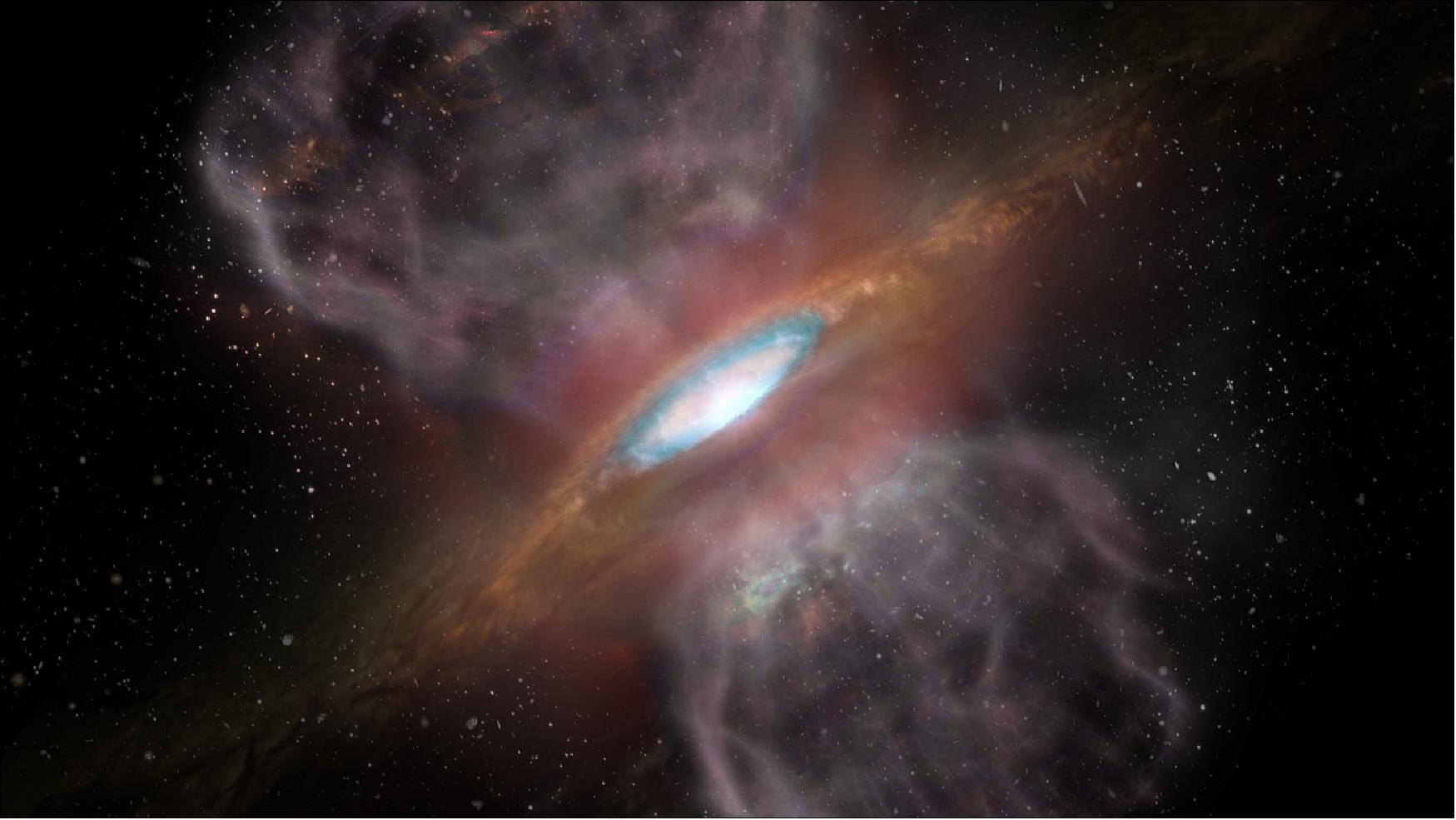
- The salty signatures were found about 30 to 60 astronomical units (AU, or the average distance between the Earth and the Sun) from the host stars. Based on their observations, the astronomers infer that there may be as much as one sextillion (a one with 21 zeros after it) kilograms of salt in this region, which is roughly equivalent to the entire mass of Earth’s oceans.
- “Our next step in this research is to look for salts and metallic molecules in other regions. This will help us understand if these chemical fingerprints are a powerful tool to study a wide range of protoplanetary disks, or if this detection is unique to this source,” said Ginsburg. “In looking to the future, the planned Next Generation VLA would have the right mix of sensitivity and wavelength coverage to study these molecules and perhaps use them as tracers for planet-forming disks.”
- Orion Source I formed in the Orion Molecular Cloud I, a region of explosive starbirth previously observed with ALMA. “This star was ejected from its parent cloud with a speed of about 10 km/s around 550 years ago,” said John Bally, an astronomer at the University of Colorado and co-author on the paper. “It is possible that solid grains of salt were vaporized by shock waves as the star and its disk were abruptly accelerated by a close encounter or collision with another star. It remains to be seen if salt vapor is present in all disks surrounding massive protostars, or if such vapor traces violent events like the one we observed with ALMA.” 139)
• February 4, 2019: Astronomers using ALMA have detected various complex organic molecules around the young star V883 Ori. A sudden outburst from this star is releasing molecules from the icy compounds in the planet forming disk. The chemical composition of the disk is similar to that of comets in the modern Solar System. Sensitive ALMA observations enable astronomers to reconstruct the evolution of organic molecules from the birth of the Solar System to the objects we see today. 140)
- The research team led by Jeong-Eun Lee (Kyung Hee University, Korea) used the Atacama Large Millimeter/submillimeter Array (ALMA) to detect complex organic molecules including methanol (CH3OH), acetone (CH3COCH3), acetaldehyde (CH3CHO), methyl formate (CH3OCHO), and acetonitrile (CH3CN). This is the first time that acetone was unambiguously detected in a planet forming region or protoplanetary disk.
- Various molecules are frozen in ice around micrometer-sized dust particles in protoplanetary disks. V883 Ori's sudden flare-up is heating the disk and sublimating the ice, which releases the molecules into gas. The region in a disk where the temperature reaches the sublimation temperature of the molecules is called the "snow line." The radii of snow lines are about a few astronomical units (au) around normal young stars, however, they are enlarged almost 10 times around bursting stars.
- "It is difficult to image a disk on the scale of a few au with current telescopes," said Lee. "However, around an outburst star, ice melts in a wider area of the disk and it is easier to see the distribution of molecules. We are interested in the distribution of complex organic molecules as the building blocks of life."
- Ice, including frozen organic molecules, could be closely related to the origin of life on planets. In our Solar System, comets are the focus of attention because of their rich icy compounds. For example, the European Space Agency's legendary comet explorer Rosetta found rich organic chemistry around the comet Churyumov-Gerasimenko. Comets are thought to have been formed in the outer colder region of the proto-Solar System, where the molecules were contained in ice. Probing the chemical composition of ice in protoplanetary disks is directly related to probing the origin of organic molecules in comets, and the origin of the building blocks of life.
- Thanks to ALMA's sharp vision and the enlarged snow line due to the flare-up of the star, the astronomers obtained the spatial distribution of methanol and acetaldehyde. The distribution of these molecules has a ring-like structure with a radius of 60 au, which is twice the size of Neptune's orbit. The researchers assume that inside of this ring the molecules are invisible because they are obscured by thick dusty material, and are invisible outside of this radius because they are frozen in ice.
- "Since rocky and icy planets are made from solid material, the chemical composition of solids in disks is of special importance. An outburst is a unique chance to investigate fresh sublimates, and thus the composition of solids." says Yuri Aikawa at the University of Tokyo, a member of the research team.
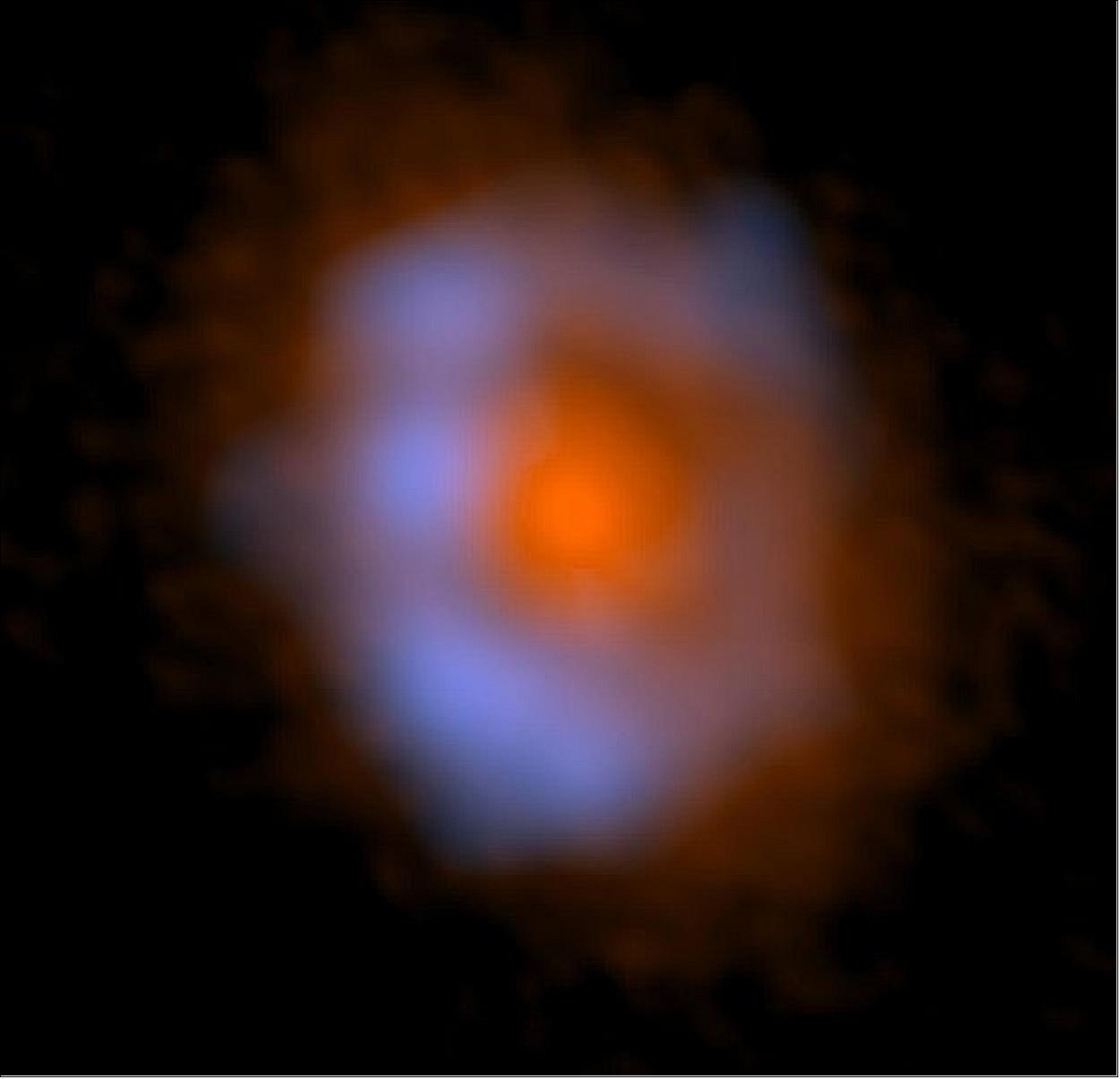
- V883 Ori is a young star located at 1300 light-years away from the Earth. This star is experiencing a so-called FU Orionis type outburst, a sudden increase of luminosity due to a bursting torrent of material flowing from the disk to the star. These outbursts last only on the order of 100 years, therefore the chance to observe a burst is rather rare. However, since young stars with a wide range of ages experience FU Ori bursts, astronomers expect to be able to trace the chemical composition of ice throughout the evolution of young stars. 141)
• January 21, 2019: Including the powerful ALMA into an array of telescopes for the first time, astronomers have found that the emission from the supermassive black hole Sagittarius A* (Sgr A*) at the center of our Galaxy comes from a smaller region than previously thought. This may indicate that a radio jet from Sgr A* is pointed almost directly towards the Earth. 142) 143) 144)
- So far, a foggy cloud of hot gas has prevented astronomers from making sharp images of the supermassive black hole Sgr A* and causing doubt on its true nature. They have now included for the first time the powerful ALMA telescope in northern Chile into a global network of radio telescopes to peer through this fog, but the source keeps surprising them: its emission region is so small that the source may actually have to point directly at the direction of the Earth.
- Observing at a frequency of 86 GHz with the technique of VLBI (Very Long Baseline Interferometry), which combines many telescopes to form a virtual telescope the size of the Earth, the team succeeded in mapping out the exact properties of the light scattering blocking our view of Sgr A*. To remove the scattering and obtain the image, the team used a technique developed by Michael Johnson of the Harvard-Smithsonian Center for Astrophysics (CfA). "Even though scattering blurs and distorts the image of Sgr A*, the incredible resolution of these observations allowed us to pin down the exact properties of the scattering,” says Johnson. “We could then remove most of the effects from scattering and begin to see what things look like near the black hole”.
- The high quality of the unscattered image (Figure 106) has allowed the team to constrain theoretical models for the gas around Sgr A*. The bulk of the radio emission is coming from a region of a small size: a mere 300 millionth of an arc degree. “This may indicate that the radio emission is produced in a disk of infalling gas rather than by a radio jet,” explains Issaoun, who has tested several computer models against the data. “However, that would make Sgr A* an exception compared to other radio emitting black holes. The alternative could be that the radio jet is pointing almost at us”.
- The German astronomer Heino Falcke, Professor of Radio Astronomy at Radboud University and PhD supervisor of Issaoun, calls this statement very unusual, but he also no longer rules it out. Last year, Falcke would have considered this a contrived model, but recently the GRAVITY team came to a similar conclusion using ESO’s Very Large Telescope Interferometer of optical telescopes and an independent technique. “Maybe this is true after all”, concludes Falcke, “and we are looking at this beast from a very special vantage point.”
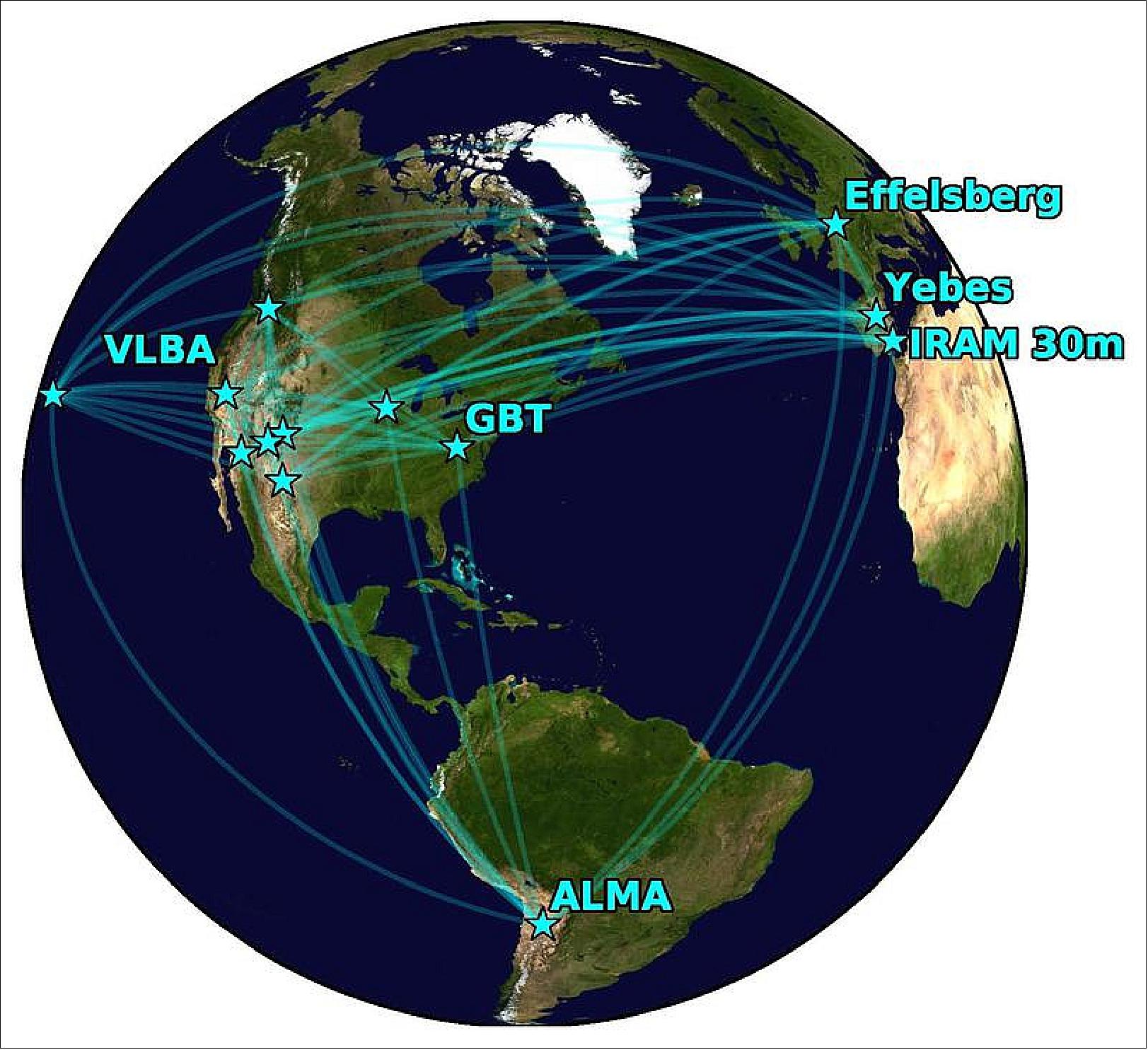
Legend to Figure 105: The data were correlated at the Max Planck Institute for Radio Astronomy (MPIfR), which also operates the Global Millimeter-VLBI Array (GMVA). Data analysis software was developed at the MIT Haystack Observatory and the Smithsonian Astrophysical Observatory. Several members of the team worked in this project as part of the European Research Council funded BlackHoleCam (BHC) team. The research team is also part of the Event Horizon Telescope (EHT) consortium, an international partnership of thirteen institutes from ten countries: Germany, the Netherlands, France & Spain (via IRAM), USA, Mexico, Japan, Taiwan, Canada and China (via EAO). The participation of ALMA (Atacama Large Millimeter/submillimeter Array) through the ALMA Phasing Project has been decisive for the success of this project. The GMVA is partially supported by the European Union’s Horizon 2020 research and innovation program under grant agreement No. 730562.
- Supermassive black holes are common in the centers of galaxies and may generate the most energetic phenomena in the known universe. It is believed that, around these black holes, matter falls in a rotating disk and part of this matter is expelled in opposite directions along two narrow beams, called jets, at speeds close to the speed of light, which typically produces a lot of radio light. “Whether the radio emission seen from SgrA* originates from a symmetrical underlying structure, or is intrinsically asymmetric is a matter of intense discussion”, explains Thomas Krichbaum, member of the team.
- Sgr A* is the nearest supermassive black hole and 'weighs' about 4 million solar masses. Its apparent size on the sky is less than a 100 millionth of an arc degree, which corresponds to the size of a tennis ball on the moon as seen from the Earth. “The black hole is so small that only VLBI can provide the angular resolution needed to resolve its structure”, says Pablo Torne, astronomer in support on the observations from the IRAM 30-meter telescope. “The first observations of Sgr A* at 86 GHz date from 26 years ago, with only a handful of telescopes. Over the years, the quality of the data has improved steadily as more telescopes join,” adds J. Anton Zensus, director of the Max Planck Institute for Radio Astronomy and head of its Radio Astronomy/VLBI division.
- The findings of Issaoun and her international team including scientists from two research departments (Kramer & Zensus) at MPIfR describe the first observations at 86 GHz in which ALMA also participated, by far the most sensitive telescope at this frequency. ALMA became part of the Global Millimeter VLBI Array (GMVA), which is operated by the Max Planck Institute for Radio Astronomy, in April 2017. The participation of ALMA, made possible by the ALMA Phasing Project effort, has been decisive for the success of this project.
- The participation of ALMA in mm-VLBI is important because of its sensitivity and its location in the southern hemisphere. In addition to ALMA, twelve radio telescopes in North America and Europe also participated in the network. The resolution achieved was twice as large as in previous observations at this frequency and produced the first image of Sgr A* that is considerably reduced in interstellar scattering (an effect caused by density irregularities in the ionized material along the line of sight between Sgr A* and the Earth).
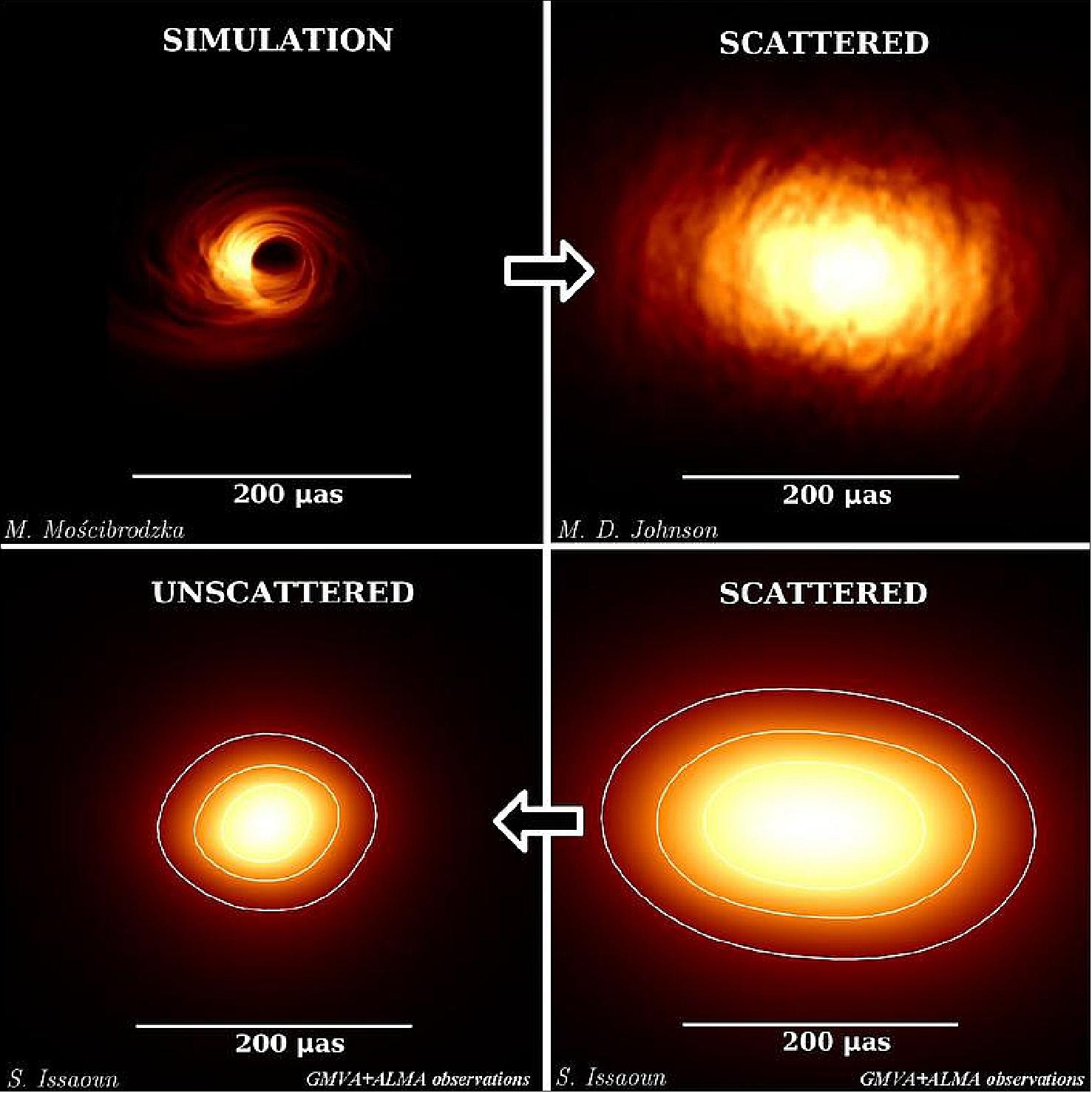
• January 24, 2019: Using the ALMA observatory in Chile, a group of astronomers led by MPIA’s (Max Planck Institute for Astronomy, Heidelberg), Henrik Beuther has made the most detailed observation yet of the way that a giant gas cloud fragments into dense cores, which then act as the birthplaces of stars. The astronomers found that the mechanisms for fragmentation are fairly straightforward, resulting from the combination of the cloud’s pressure and gravity. More complex features, such as magnetic lines or turbulence, play a smaller role than previously thought. 145) 146)
- Stars are born when giant clouds of gas and dust collapse. Whenever one of the collapsing regions becomes hot and dense enough for nuclear fusion to set in, a star is born. For massive stars, i.e. those stars that exhibit more than eight times the mass of the Sun, that is only part of the picture, though. The biggest stars in the Universe are not born singly. They are born from massive clouds of molecular gas, which then form a cascade of fragments, with many of the fragments giving birth to a star.
- Astronomers have long wondered whether this fragmentation-mode of forming stars requires different physical mechanisms than for lower-mass stars. Proposals include turbulent gas motion, which could destabilize a region and lead to quicker collapse, or magnetic fields that could stabilize and thus delay collapse.
- The different mechanisms should leave tell-tale traces in regions where multiple stars are forming. The collapse that leads to the formation of high-mass stars takes place on a hierarchy of different levels. On the largest scales, star formation involves giant molecular clouds, which consist mostly of hydrogen gas and can reach sizes between a few dozen and more than a hundred light-years across. Within those clouds are slightly denser clumps, typically a few light-years across. Each clump contains one or more dense cores, less than a fifth of a light-year in diameter. Within each core, collapse leads to the formation of either a single star or multiple stars. Together, the stars produced in the cores of a single clump will form a star cluster.
Tell-tale scales of fragmentation
- The scales of this fragmentation at multiple levels depend on the mechanisms involved. The simplest model can be written down using no more than high school physics: An ideal gas has a pressure that depends on its temperature and density. In a simplified gas cloud, assumed to have constant density, that pressure must be strong enough everywhere to balance the force of gravity (given by Newton’s law of gravity) – even in the center of the cloud, where the inward gravitation-induced push of all the surrounding matter is strongest. Write this condition down, and you will find that any such constant-density cloud can only have a maximum size. If a cloud is larger than this maximum, which is called the Jeans length, the cloud will fragment and collapse.
- Is the fragmentation of young massive clusters really dominated by these comparatively straightforward processes? It doesn’t need to be, and some astronomers have constructed much more complex scenarios, which include the influence of turbulent gas motion and magnetic field lines. These additional mechanisms change the conditions for cloud stability, and typically increase the scales of the different types of fragment.
- Different predictions for cloud sizes offer a way of testing the simple physics scenario against its more complex competitors. That is what Henrik Beuther and his colleagues set out to do when they observed the star formation region G351.77-0.54 in the Southern constellation Scorpius (The Scorpion). Previous observations had indicated that in this region, fragmentation could be caught in the act. But none of these observations had been powerful enough to show the smallest scale of interest for answering the question of fragmentation scales: the protostellar cores, let alone their sub-structure.
ALMA takes the most detailed look yet
- Beuther and his colleagues were able to do more. They used the ALMA Observatory in the Atacama Desert in Chile. ALMA combines the simultaneous observations of up to 66 radio telescopes to achieve a resolution of down to 20 milli-arcseconds, which allows astronomers to discern details more than ten times smaller than with any previous radio telescope, and at unrivalled sensitivity – a combination that has already led to a number of breakthrough observations also in other fields.
- Beuther and his colleagues used ALMA to study the high-mass star-forming region G351.77-0.54 down to sub-core scales smaller than 50 astronomical units (in other words, less than 50 times the average distance between the Earth and the Sun). As Beuther says: “This is a prime example of how technology drives astronomical progress. We could not have obtained our results without the unprecedented spatial resolution and sensitivity of ALMA.”
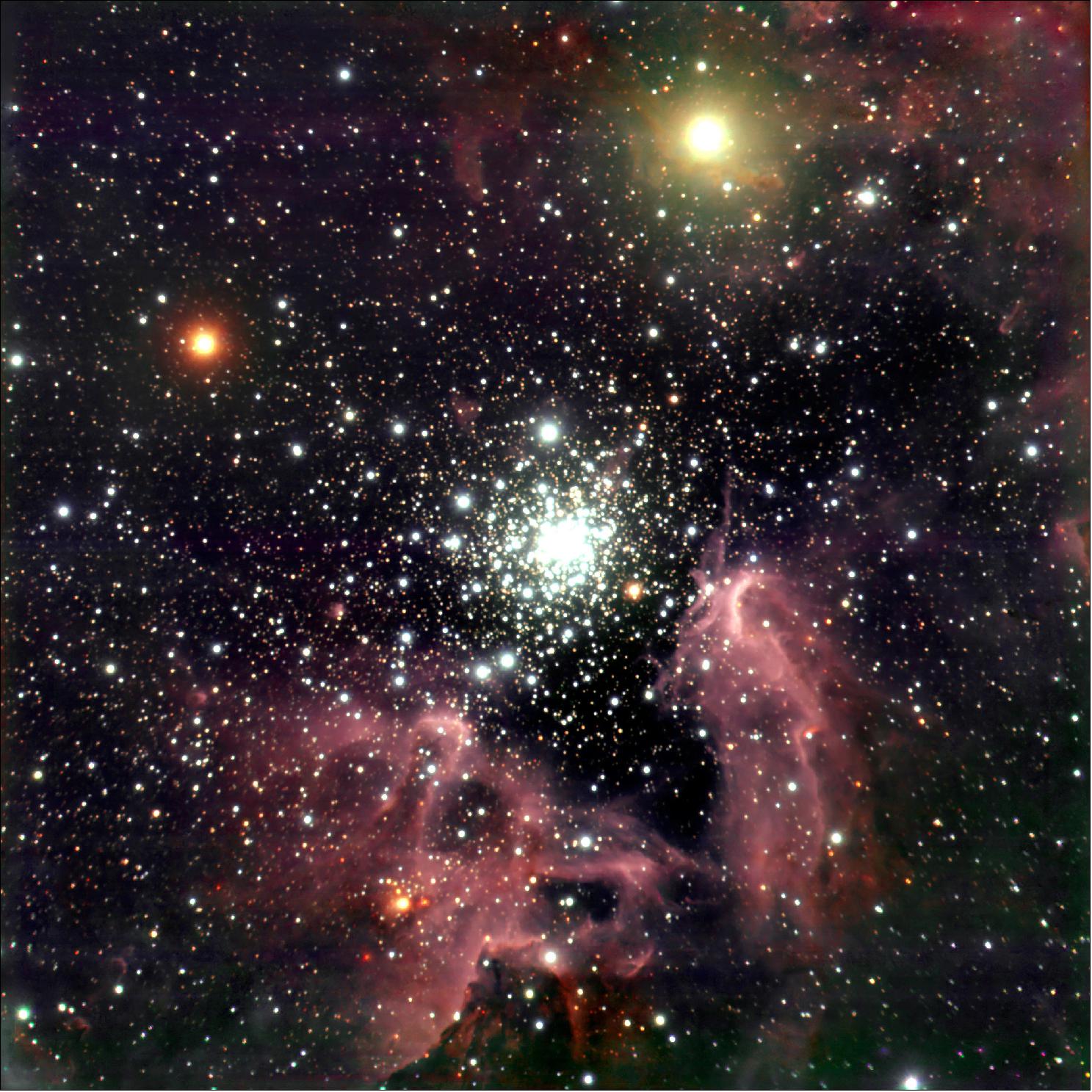
- Their results, together with earlier studies of the same cloud at larger scales, indicate that thermal gas physics is winning the day, even when it comes to very massive stars: Both the sizes of clumps within the cloud and, as the new observations show, of cores within the clumps and even of some core substructures are as predicted by Jeans length calculations, with no need for additional ingredients. Beuther comments: “In our case, the same physics provides a uniform description. Fragmentation from the largest to the smallest scales seems to be governed by the same physical processes.”
Small accretion disks: a new challenge
- Simplicity is always a boon for scientific descriptions. However, the same observations also provided a discovery that will keep astronomers on their collective toes. In addition to studying fragmentation, Beuther et al. had been looking to unravel the structure of nascent stars (“protostars”) within the cloud. Astronomers expect such a protostar to be surrounded by a swirling disk of gas, called the accretion disk. From the inner disk of the rim, gas falls onto the growing star, increasing its mass. In addition, magnetic fields produced by the motion of ionized gas and the gas itself interact to produce tightly focused streams called jets, which shoot out some of the matter into space perpendicular to that disk. Submillimeter light from those regions carries tell-tale signs (“Doppler-broadening of spectral lines”) of the motion of dust, which in turn traces the motion of gas. But where Beuther and his collaborators had hoped for a clear signature from an accretion disk, instead, he found mainly the signature of jets, cutting a comparatively smooth path through the surrounding gas. Evidently, the accretion disks are even smaller than astronomers had expected – a challenge for future observations at even greater spatial resolution.
• January 15, 2019: New research led by an astronomer at the University of Warwick has found the first confirmed example of a double star system that has flipped its surrounding disc to a position that leaps over the orbital plane of those stars. The international team of astronomers used ALMA (Atacama Large Millimeter/sub-millimeter Array) to obtain high-resolution images of the Asteroid belt-sized disc. 147)
- The overall system presents the unusual sight of a thick hoop of gas and dust circling at right angles to the binary star orbit. Until now this setup only existed in theorists’ minds, but the ALMA observation proves that polar discs of this type exist, and may even be relatively common.
- The new research is published 14 January by Royal Society University Research Fellow Dr Grant M. Kennedy of the University of Warwick's Department of Physics and Center for Exoplanets and Habitability in Nature Astronomy in a paper entitled "A circumbinary protoplanetary disc in a polar configuration". 148)
- Dr Grant M. Kennedy of the University of Warwick said: "Discs rich in gas and dust are seen around nearly all young stars, and we know that at least a third of the ones orbiting single stars form planets. Some of these planets end up being misaligned with the spin of the star, so we've been wondering whether a similar thing might be possible for circumbinary planets. A quirk of the dynamics means that a so-called polar misalignment should be possible, but until now we had no evidence of misaligned discs in which these planets might form."
- Dr Kennedy and his fellow researchers used ALMA to pin down the orientation of the ring of gas and dust in the binary star system HD 98800 . The orbit of the binary was previously known, from observations that quantified how the stars move in relation to each other. By combining these two pieces of information they were able to establish that the dust ring was consistent with a perfectly polar orbit. This means that while the stellar orbits orbit each other in one plane, like two horses going around on a carousel, the disc surrounds these stars at right angles to their orbits, like a giant ferris wheel with the carousel at the center
- Kennedy added: "Perhaps the most exciting thing about this discovery is that the disc shows some of the same signatures that we attribute to dust growth in discs around single stars. We take this to mean planet formation can at least get started in these polar circumbinary discs. If the rest of the planet formation process can happen, there might be a whole population of misaligned circumbinary planets that we have yet to discover, and things like weird seasonal variations to consider."
- If there were a planet or planetoid present at the inner edge of the dust ring, the ring itself would appear from the surface as a broad band rising almost perpendicularly from the horizon. The polar configuration means that the stars would appear to move in and out of the disc plane, giving objects two shadows at times. Seasons on planets in such systems would also be different. On Earth they vary throughout the year as we orbit the Sun. A polar circumbinary planet would have seasons that also vary as different latitudes receive more or less illumination throughout the binary orbit.
- Future studies at different wavelengths will provide complementary information and further observational constraints for this source, which holds the key to a better understanding of black holes, the most exotic objects in the known universe.
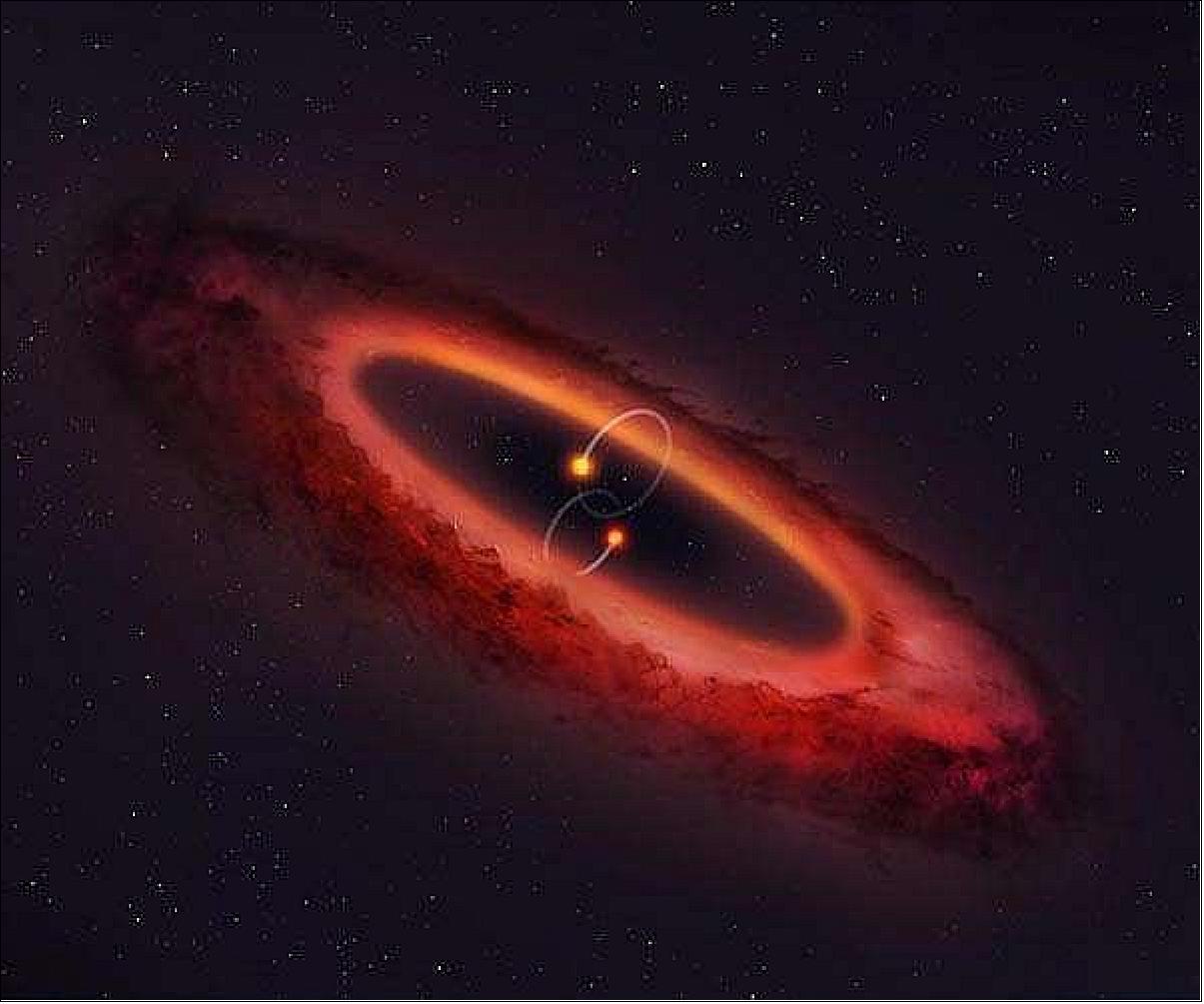
- Co-author Dr Daniel Price of Monash University’s Center for Astrophysics (MoCA) and School of Physics and Astronomy added:“We used to think other solar systems would form just like ours, with the planets all orbiting in the same direction around a single sun. But with the new images we see a swirling disc of gas and dust orbiting around two stars. It was quite surprising to also find that that disc orbits at right angles to the orbit of the two stars. Incredibly, two more stars were seen orbiting that disc. So if planets were born here there would be four suns in the sky! ALMA is just a fantastic telescope, it is teaching us so much about how planets in other solar systems are born.”
• January 10, 2019: Galaxies come in a wide variety of shapes and sizes. Some of the most significant differences among galaxies, however, relate to where and how they form new stars. Compelling research to explain these differences has been elusive, but that is about to change. 149)
- A vast, new research project with the ALMA (Atacama Large Millimeter/submillimeter Array), known as PHANGS-ALMA (Physics at High Angular Resolution in Nearby GalaxieS), delves into this question with far greater power and precision than ever before by measuring the demographics and characteristics of a staggering 100,000 individual stellar nurseries spread throughout 74 galaxies.
- PHANGS-ALMA, an unprecedented and ongoing research campaign, has already amassed a total of 750 hours of observations and given astronomers a much clearer understanding of how the cycle of star formation changes, depending on the size, age, and internal dynamics of each individual galaxy. This campaign is 10 to 100 times more powerful (depending on your parameters) than any prior survey of its kind.
- "Some galaxies are furiously bursting with new stars while others have long ago used up most of their fuel for star formation. The origin of this diversity may very likely lie in the properties of the stellar nurseries themselves," said Erik Rosolowsky, an astronomer at the University of Alberta in Canada and a co-principal investigator of the PHANGS-ALMA research team.
- He presented initial findings of this research at the 233rd meeting of the American Astronomical Society being held this week in Seattle, Washington. Several papers based on this campaign have also been published in the Astrophysical Journal and the Astrophysical Journal Letters. 150) 151) 152)
- "Previous observations with earlier generations of radio telescopes provide some crucial insights about the nature of cold, dense stellar nurseries," Rosolowsky said. - "These observations, however, lacked the sensitivity, fine-scale resolution, and power to study the entire breadth of stellar nurseries across the full population of local galaxies. This severely limited our ability to connect the behavior or properties of individual stellar nurseries to the properties of the galaxies that they live in."
- For decades, astronomers have speculated that there are fundamental differences in the way disk galaxies of various sizes convert hydrogen into new stars. Some astronomers theorize that larger, and generally older galaxies, are not as efficient at stellar production as their smaller cousins.
- The most logical explanation would be that these big galaxies have less efficient stellar nurseries. But testing this idea with observations has been difficult.
![Figure 109: The ALMA telescope is conducting an unprecedented survey of nearby disk galaxies to study their stellar nurseries. With it, astronomers are beginning to unravel the complex and as-yet poorly understood relationship between star-forming clouds and their host galaxies [image credit: ALMA (ESO/NAOJ/NRAO); NRAO/AUI/NSF, B. Saxton]](https://www.eoportal.org/ftp/satellite-missions/a/Alma_300622/Alma_Auto1.jpeg)
• January 1, 2019: Using observations from the ALMA radio observatory in Chile, researchers have observed, for the first time, a warped disk around an infant protostar that formed just several tens of thousands of years ago. This implies that the misalignment of planetary orbits in many planetary systems —including our own— may be caused by distortions in the planet-forming disk early in their existence. 153)
- The planets in our Solar System orbit the Sun in planes that are at most about seven degrees offset from the equator of the Sun itself. It has been known for some time that many extrasolar systems have planets that are not lined up in a single plane or with the equator of the star. One explanation for this is that some of the planets might have been affected by collisions with other objects in the system or by stars passing by the system, ejecting them from their initial orbital plane.
- However, the possibility remained that the formation of planets out of the normal plane was actually caused by a warping of the star-forming cloud out of which the planets were born. Recently, images of protoplanetary disks—rotating disks where planets form around a star—have in fact showed such warping. But it was still unclear how early this happened.
- In the latest findings, published in Nature, the group from the RIKEN Cluster for Pioneering Research (CPR) and Chiba University in Japan have discovered that L1527; an infant protostar still embedded within a cloud, has a disk that has two parts —an inner one rotating in one plane, and an outer one in a different plane. The disk is very young and still growing. L1527, which is about 450 light-years away in the Taurus Molecular Cloud, is a good object for study as it has a disk that is nearly edge-on to our view. 154)
- According to Nami Sakai, who led the research group, “This observation shows that it is conceivable that the misalignment of planetary orbits can be caused by a warp structure formed in the earliest stages of planetary formation. We will have to investigate more systems to find out if this is a common phenomenon or not.”
- The remaining question is what caused the warping of the disk. Sakai suggests two reasonable explanations. “One possibility,” she says, “is that irregularities in the flow of gas and dust in the protostellar cloud are still preserved and manifest themselves as the warped disk. A second possibility is that the magnetic field of the protostar is in a different plane from the rotational plane of the disk, and that the inner disk is being pulled into a different plane from the rest of the disk by the magnetic field.” She says they plan further work to determine which is responsible for the warping of the disk.
- The ALMA observatory in Chile is managed by an international consortium including the National Astronomical Observatory of Japan (NAOJ).
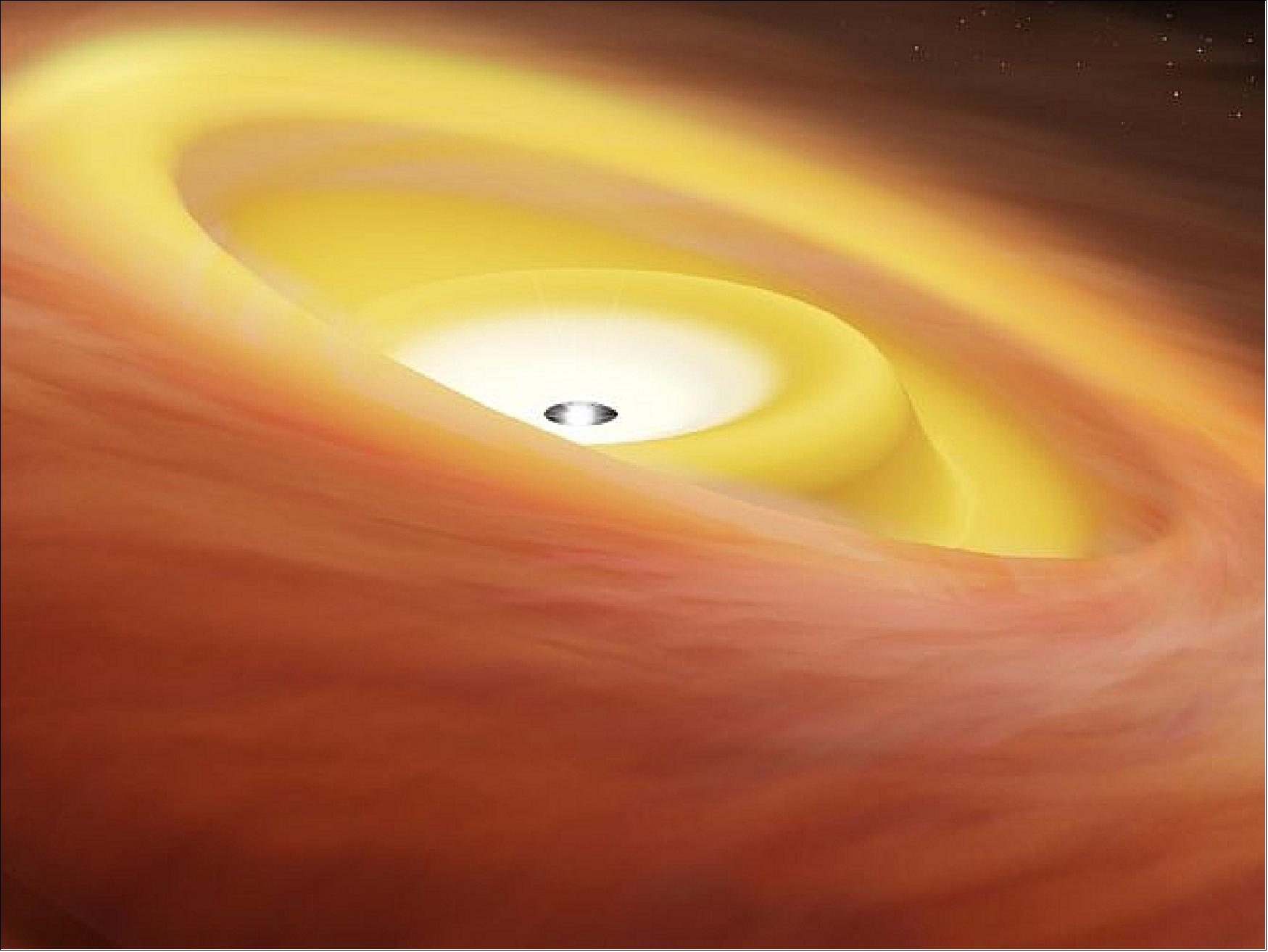
References
1) ”Atacama Large Millimeter/submillimeter Array,” ALMA, URL: http://www.almaobservatory.org/en/about-alma/global-collaboration
2) http://www.almaobservatory.org/en/home
3) ”ALMA - Exploring the Universe at Millimeter Wavelength,” ALMA brochure, 2007, URL: http://www.almaobservatory.org/images/pdfs/alma_brochure_explore_2007.pdf
4) ”ALMA through the years,” ALMA, URL: http://www.almaobservatory.org/en/about-alma/origins-of-the-alma-project/timeline
5) http://www.almaobservatory.org/
6) “ALMA Opens Its Eyes,” Space Daily, Oct. 4, 2011, URL: http://www.spacedaily.com/reports/ALMA_Opens_Its_Eyes_999.html
7) “ALMA Inauguration Heralds New Era of Discovery,” ESO, Release eso1312, March 13, 2013, URL: http://www.eso.org/public/news/eso1312/
8) “Final ALMA Antenna Arrives on Chajnantor Plateau,”Space Daily, June 19, 2014, URL: http://www.spacedaily.com/reports/Final_ALMA_Antenna_Arrives_on_Chajnantor_Plateau_999.html
9) ”Final ALMA Antenna Arrives on the Chajnantor Plateau,” ALMA, June 16, 2014, URL: http://www.almaobservatory.org/en/press-room/announcements-events/709-final-alma-antenna-arrives-on-the-chajnantor-plateau
10) ”ALMA Gains New Capability in its First VLBI Observation,” ALMA, March 5, 2015, URL: http://www.almaobservatory.org/en/press-room/announcements-events/813-alma-gains-new-capability-in-its-first-successful-long-baseline-observation-
11) “ALMA Greatly Improves Capacity to Search for Water in Universe,” ESO, July 17, 2015, URL: http://www.eso.org/public/announcements/ann15059/
12) ”In search of our cosmic origins -The Construction of the Atacama Large Millimeter / submillimeter Ar ray,” ALMA photobook, 2013, URL: http://www.almaobservatory.org/docs/alma-photobook.pdf
13) ”First Observations from SEPIA -New APEX instrument for finding water in the Universe,” ESO 1543 Organization Release, Nov. 4, 2015: URL: https://www.eso.org/public/news/eso1543/
14) ”ALMA Sets Development Objectives for the Next Decade,” ALMA, 12 July 2018, URL: http://www.almaobservatory.org/en/announcement/alma-sets-development-objectives-for-the-next-decade/
15) http://www.almaobservatory.org/en/about-alma/how-does-alma-work/technology/antennas
16) ”Final ACA Antenna Delivered: The 'Morita Array',” ALMA Press Release, May 7, 2013, URL: http://www.almaobservatory.org/en/press-room/press-releases/566-final-aca-antenna-delivered-the-morita-array
17) ”The final ALMA antenna arrives at Chajnantor,” ALMA partnership, June 16, 2014, URL: http://www.eso.org/public/images/ann14048a/
18) https://almascience.nrao.edu/about-alma/alma-site
19) Front End,” ALMA, URL: http://www.almaobservatory.org/en/about-alma/how-does-alma-work/technology/front-end
20) Gie Han Tan, ”The ALMA Front Ends; an Overview,” 19th International Symposium on Space Terahertz Technology, Groningen, 28-30 April 2008, URL: http://www.nrao.edu/meetings/isstt/papers/2008/2008237243.pdf
21) ”Back End and Correlator,” ALMA, URL: http://www.almaobservatory.org/en/about-alma/how-does-alma-work/technology/back-end-and-correlator
22) Alain Baudry, Fabio Biancat Marchet, Hervé Kurlandcyk, Silvio Rossi, ”The ALMA Back-End,” 2008, URL: https://www.eso.org/sci/publications/messenger/archive/no.125-sep06/messenger-no125-37-40.pdf
23) ALMA Newsletter No. 5, April 2010, URL: http://www.almaobservatory.org/science_articles/05_how_will_alma_make_images.pdf
24) ”ALMA Band 2 Contracts Signed,” ESO, 15 May 2020, URL: https://www.eso.org/sci/facilities/alma/news/announcements/alma-ann1808.html
25) ”ALMA Links with Other Observatories to Create Earth-size Telescope,” ALMA, Nov. 10, 2015, URL: http://www.almaobservatory.org/en/press-room/announcements-events/900-alma-links-with-other-observatories-to-create-earth-size-telescope
26) Luke Maud1Eric Villard, Satoko Takahashi, Yoshiharu Asaki, Tim Bastian, Paulo Cortes, Geoff Crew, Ed Fomalont, Antonio Hales, Shun Ishii, Lynn Matthews, Hugo Messias, Hiroshi Nagai, Tsuyoshi Sawada, Gerald Schieven, Masumi Shimojo, Baltasar Vila-Vilaro, Andy Biggs, Dirk Petry,Neil Phillips, Rosita Paladino, ”Enhancing ALMA’s Future Observing Capabilities,” The Messenger 183, June 2021, URL: http://www.eso.org/sci/publications/messenger/archive/no.183-jun21/messenger-no183.pdf
27) https://www.eso.org/public/news/archive/year/2018/
28) http://www.almaobservatory.org/en/press-room/press-releases
29) ”Close Encounter More Than 10,000 Years Ago Stirred Up Spirals in an Accretion Disk,” ALMA Press Release, 18 June 2022, URL: https://www.almaobservatory.org/en/press-releases/close-encounter-more-than-10000-years-ago-stirred-up-spirals-in-an-accretion-disk/
30) Xing Lu, Guang-Xing Li, Qizhou Zhang, and Yuxin Lin, ”A massive Keplerian protostellar disk with flyby-induced spirals in the Central Molecular Zone,” Nature Astronomy, Published: 30 May 2022, https://doi.org/10.1038/s41550-022-01681-4
31) ”The Tarantula's cosmic web: astronomers map violent star formation in nebula outside our galaxy,” eso2209 — Photo Release, 15 June 2022, URL: https://www.eso.org/public/news/eso2209/?lang
32) Tony Wong, Luuk Oudshoorn, Eliyahu Sofovich, Alex Green, Charmi Shah, Rémy Indebetouw, Margaret Meixner, Alvaro Hacar, Omnarayani Nayak, Kazuki Tokuda, Alberto D. Bolatto, Mélanie Chevance, Guido De Marchi, Yasuo Fukui, Alec S. Hirschauer, K. E. Jameson, Venu Kalari, Vianney Lebouteiller, Leslie W. Looney, Suzanne C. Madden, Toshikazu Onishi, Julia Roman-Duva, Mónica Rubio, and A. G. G. M. Tielens, ”The 30 Doradus Molecular Cloud at 0.4 pc Resolution with the Atacama Large Millimeter/submillimeter Array: Physical Properties and the Boundedness of CO-emitting Structures,” The Astrophysical Journal, Volume 932, Number 1, Published: 15 June 2022, https://doi.org/10.3847/1538-4357/ac723a, URL: https://iopscience.iop.org/article/10.3847/1538-4357/ac723a/pdf
33) ”A curled viper,” ESO Picture of the week, 6 June 2022, URL: https://www.eso.org/public/images/potw2223a/
34) ”Astronomers reveal first image of the black hole at the heart of our galaxy,” eso2208-eht-mw — Science Release, 12 May 2022, URL: https://www.eso.org/public/news/eso2208-eht-mw/
35) Geoffrey C. Bower (Project Scientist) for the Event Horizon Telescope Collaboration, ”Focus on First Sgr A* Results from the Event Horizon Telescope,” The Astrophysical Journal Letters, May 2022, https://iopscience.iop.org/journal/2041-8205/page/Focus_on_First_Sgr_A_Results
36) ”Comparison of the sizes of two black holes: M87* and Sagittarius A*,” eso2208-eht-mwe, 12 May 2022, URL: https://www.eso.org/public/images/eso2208-eht-mwe/
37) ”NASA Supports Event Horizon Telescope in Studying Milky Way’s Black Hole,” NASA/JPL News, 12 May 2022, URL: https://www.jpl.nasa.gov/news/nasa-supports-event-horizon-telescope-in-studying-milky-ways-black-hole?utm_source=iContact&utm_medium=email&utm_campaign=nasajpl&utm_content=universe20220512
38) ”Planet-forming disks evolve in surprisingly similar ways,” MPG, 6 May 2022, URL: https://www.mpg.de/18491330/planet-forming-disks-evolve-in-surprisingly-similar-ways
39) S. E. van Terwisga, A. Hacar, E. F. van Dishoeck, R. Oonk, S. Portegies Zwart, ”Survey of Orion Disks with ALMA (SODA) I: Cloud-level demographics of 873 protoplanetary disks,” https://arxiv.org/abs/2202.11057
40) ”Hey DUDE: Mysterious Death of Carbon Star Plays Out Like Six-Ring Circus,” ALMA Press Release, 28 March 2022, URL: https://www.almaobservatory.org/en/press-releases/hey-dude-mysterious-death-of-carbon-star-plays-out-like-six-ring-circus/
41) The original press release was published by the National Radio Astronomy Observatory (NRAO), an ALMA partner on behalf of North America.
42) R. Sahai, P-S. Huang, S. Scibelli, M. R. Morris, K. Hinkle, C-F. Lee, ”The Rapidly Evolving AGB Star, V Hya: ALMA finds a Multi-Ring Circus with High-Velocity Outflows, The Astrophysical Journal, ” Draft version February 21, 2022, https://doi.org/10.48550/arXiv.2202.09335, URL: https://arxiv.org/pdf/2202.09335.pdf
43) ”Astronomers discover largest molecule yet in a planet-forming disc,” eso2205 — Science Release, 8 March 2022, URL: https://www.eso.org/public/news/eso2205/
44) Nashanty G. C. Brunken, Alice S. Booth, Margot Leemker, Pooneh Nazari, Nienke van der Marel and Ewine F. van Dishoeck, ”A major asymmetric ice trap in a planet-forming disk,” Astronomy & Astrophysics, Volume 659, Published online: 8 March 2022, Article Number A29, https://doi.org/10.1051/0004-6361/202142981
45) ”ALMA catches “intruder” redhanded in rarely detected stellar flyby event,” ALMA Press Release, 13 January 2022, URL: https://www.almaobservatory.org/en/press-releases/alma-catches-intruder-redhanded-in-rarely-detected-stellar-flyby-event/
46) Ruobing Dong, Hauyu Baobab Liu, Nicolás Cuello, Christophe Pinte, Péter Ábrahám, Eduard Vorobyov, Jun Hashimoto, Ágnes Kóspál, Eugene Chiang, Michihiro Takami, Lei Chen, Michael Dunham, Misato Fukagawa, Joel Green, Yasuhiro Hasegawa, Thomas Henning, Yaroslav Pavlyuchenkov, Tae-Soo Pyo & Motohide Tamura, ”A likely flyby of binary protostar Z CMa caught in action,” Nature Astronomy, Published: 13 January 2022, https://doi.org/10.1038/s41550-021-01558-y
47) ”Astronomers make most distant detection yet of fluorine in star-forming galaxy,” eso2115 — Science Release, 4 November 2021, URL: https://www.eso.org/public/news/eso2115/?lang
48) M. Franco, K. E. K. Coppin, J. E. Geach, C. Kobayashi, S. C. Chapman, C. Yang, E. González-Alfonso, J. S. Spilker, A. Cooray & M. J. Michałowski, ”The ramp-up of interstellar medium enrichment at z > 4,” Nature Astronomy, Published: 04 November 2021, https://doi.org/10.1038/s41550-021-01515-9
49) ”ALMA Goes to New (Wave)lengths,” ann21012 — Announcement, 8 September 2021, URL: https://www.eso.org/public/announcements/ann21012/?lang
50) ”Scientists Observe Gas Re-accretion in Dying Galaxies for the First Time,” ALMA Press Release, 29 July 2021, URL: https://www.almaobservatory.org/en/press-releases/scientists-observe-gas-re-accretion-in-dying-galaxies-for-the-first-time/
51) William J. Cramer, Jeffrey D. P. Kenney, Stephanie Tonnesen, Rory Smith, Tony Wong, Pavel Jáchym, Juan R. Cortés, Paulo C. Cortés, Yu-Ting Wu, ”Molecular gas filaments and fallback in the ram pressure stripped Coma spiral NGC 4921,” Astrophysics of Galaxies, Paper submitted: 25 July 2021, https://arxiv.org/abs/2107.11731
52) ”Astronomers make first clear detection of a moon-forming disc around an exoplanet,” eso2111 — Science Release, 22 July 2021, URL: https://www.eso.org/public/news/eso2111/?lang
53) Myriam Benisty, Jaehan Bae, Stefano Facchini, Miriam Keppler, Richard Teague,Andrea Isella,Nicolas T. Kurtovic,Laura M. P érez, Anibal Sierra, Sean M. Andrews, John Carpenter, Ian Czekala, Carsten Dominik, Thomas Henning,Francois Menard, Paola Pinilla, and Alice Zurlo, ”A Circumplanetary Disk Around PDS70 c,” Draft version July 21, 2021, The Astrophysical Research Letters, URL: https://www.eso.org/public/archives/releases/sciencepapers/eso2111/eso2111a.pdf
54) ”Mind the Gap: Scientists Use Stellar Mass to Link Exoplanets to Planet-Forming Disks,” ALMA Press Release, 23 June 2021, URL: https://www.almaobservatory.org/en/press-releases/mind-the-gap-scientists-use-stellar-mass-to-link-exoplanets-to-planet-forming-disks/
55) ”Mind the Gap: Scientists Use Stellar Mass to Link Exoplanets to Planet-Forming Disks,” NRAO News, 23 June 2021, URL: https://public.nrao.edu/news/scientists-use-stellar-mass-to-link-exoplanets-to-protoplanetary-disks/
56) Nienke van der Marel, Gijs Mulders, ”A stellar mass dependence of structured disks: a possible link with exoplanet demographics,” Astrophysical Journal, Published: 23 June 2021, https://doi.org/10.3847/1538-3881/ac0255
57) Cosmic cartographers map nearby Universe revealing the diversity of star-forming galaxies,” NRAO News Release, 8 June 2021, URL: https://public.nrao.edu/news/alma-phangs-stellar-nursery-census/
58) Adam K. Leroy, Eva Schinnerer, Annie Hughes, Erik Rosolowsky, Jérôme Pety, Andreas Schruba, Antonio Usero, Guillermo A. Blanc, Mélanie Chevance, Eric Emsellem, Christopher M. Faesi, Cinthya N. Herrera, Daizhong Liu, Sharon E. Meidt, Miguel Querejeta, Toshiki Saito, Karin M. Sandstrom, Jiayi Sun, Thomas G. Williams, Gagandeep S. Anand, Ashley T. Barnes, Erica A. Behrens, Francesco Belfiore, Samantha M. Benincasa, Ivana Bešlić, Frank Bigiel, Alberto D. Bolatto, Jakob S. den Brok, Yixian Cao, Rupali Chandar, Jérémy Chastenet, I-Da Chiang, Enrico Congiu, Daniel A. Dale, Sinan Deger, Cosima Eibensteiner, Oleg V. Egorov, Axel García-Rodríguez, Simon C. O. Glover, Kathryn Grasha, Jonathan D. Henshaw, I-Ting Ho, Amanda A. Kepley, Jaeyeon Kim, Ralf S. Klessen, Kathryn Kreckel, Eric W. Koch, J. M. Diederik Kruijssen, Kirsten L. Larson, Janice C. Lee, Laura A. Lopez, Josh Machado, Ness Mayker, Rebecca McElroy, Eric J. Murphy, Eve C. Ostriker, Hsi-An Pan, Ismael Pessa, Johannes Puschnig, Alessandro Razza, Patricia Sánchez-Blázquez, Francesco Santoro, Amy Sardone, Fabian Scheuermann, Kazimierz Sliwa, Mattia C. Sormani, Sophia K. Stuber, David A. Thilker, Jordan A. Turner, Dyas Utomo, Elizabeth J. Watkins, Bradley Whitmore, ”PHANGS-ALMA: Arcsecond CO(2-1) Imaging of Nearby Star-Forming Galaxies,” Draft version April 30, 2021Typeset using LATEXtwocolumnstyle in AASTeX63, https://arxiv.org/abs/2104.07739, URL: https://arxiv.org/pdf/2104.07739.pdf
59) ”ALMA Discovers Rotating Infant Galaxy with Help of Natural Cosmic Telescope,” ALMA Press Release, 22 April 2021, URL: https://www.almaobservatory.org/en/press-releases/alma-discovers-rotating-infant-galaxy-with-help-of-natural-cosmic-telescope/
60) Seiji Fujimoto, Masamune Oguri, Gabriel Brammer, Yuki Yoshimura, Nicolas Laporte, Jorge González-López, Gabriel B. Caminha, Kotaro Kohno, Adi Zitrin, Johan Richard, Masami Ouchi, Franz E. Bauer, Ian Smail, Bunyo Hatsukade, Yoshiaki Ono, Vasily Kokorev, Hideki Umehata, Daniel Schaerer, Kirsten Knudsen, Fengwu Sun, Georgios Magdis, Francesco Valentino, Yiping Ao, Sune Toft, Miroslava Dessauges-Zavadsky, Kazuhiro Shimasaku, Karina Caputi, Haruka Kusakabe, Kana Morokuma-Matsui, Kikuchihara Shotaro, Eiichi Egami, Minju M. Lee, Timothy Rawle, Daniel Espada, ”ALMA Lensing Cluster Survey: Bright [CII] 158 µm Lines from a Multiply Imaged Sub-L* Galaxy at z=6.0719,” Astrophysical Journal, Draft Version January 7, 2021, URL: https://arxiv.org/pdf/2101.01937.pdf
61) ”Astronomers image magnetic fields at the edge of M87’s black hole,” eso2105 — Science Release, 24 March 2021, URL: https://www.eso.org/public/news/eso2105/?lang
62) The Event Horizon Telescope Collaboration, Kazunori Akiyama, Juan Carlos Algaba, Antxon Alberdi, Walter Alef, Richard Anantua, Keiichi Asada, Rebecca Azulay, Anne-Kathrin Baczko, David Ball, et al., ”First M87 Event Horizon Telescope Results. VII. Polarization of the Ring,” The Astrophysical Journal Letters, Volume 910, Number 1, Published: 24 March 2021, https://doi.org/10.3847/2041-8213/abe71d
63) ”Powerful stratospheric winds measured on Jupiter for the first time,” eso2104 — Science Release, 18 March 2021, URL: https://www.eso.org/public/news/eso2104/?lang
64) T. Cavalié, B. Benmahi, V. Hue, R. Moreno, E. Lellouch, T. Fouchet, P. Hartogh, L. Rezac, T. K. Greathouse, G. R. Gladstone, J. A. Sinclair, M. Dobrijevic, F. Billebaud1 and C. Jarchow, ”First direct measurement of auroral and equatorial jets in the stratosphere of Jupiter,” Astronomy & Astrophysics, Volume 647, Article Nimber L8, Published online: 18 March 2021, https://doi.org/10.1051/0004-6361/202140330, URL: https://www.aanda.org/articles/aa/pdf/2021/03/aa40330-21.pdf
65) ”Quasar Discovery Sets New Distance Record,” ALMA Press Release, 12 January 2021, URL: https://www.almaobservatory.org/en/press-releases/quasar-discovery-sets-new-distance-record/
66) Feige Wang, Jinyi Yang, Xiaohui Fan, Joseph F. Hennawi, Aaron J. Barth, Eduardo Banados, Fuyan Bian, Konstantina Boutsia, Thomas Connor, Frederick B. Davies, Roberto Decarli, Anna-Christina Eilers, Emanuele Paolo Farina, Richard Green, Linhua Jiang, Jiang-Tao Li, Chiara Mazzucchelli, Riccardo Nanni, Jan-Torge Schindler, Bram Venemans, Fabian Walter, Xue-Bing Wu, Minghao Yue, ”A Luminous Quasar at Redshift 7.642,” The Astrophysical Journal Letters, Volume 907, Number 1, Published: 14 January 2021, https://doi.org/10.3847/2041-8213/abd8c6
67) ”ALMA captures distant colliding galaxy dying out as it loses the ability to form stars,” ESO Press Release, eso2101 — Science Release, 11 January 2021, URL: https://www.eso.org/public/news/eso2101/?lang
68) Annagrazia Puglisi, Emanuele Daddi, Marcella Brusa, Frederic Bournaud, Jeremy Fensch, Daizhong Liu, Ivan Delvecchio, Antonello Calabrò, Chiara Circosta, Francesco Valentino, Michele Perna, Shuowen Jin, Andrea Enia, Chiara Mancini & Giulia Rodighiero, ”A titanic interstellar medium ejection from a massive starburst galaxy at redshift 1.4,” Nature Astronomy, Published: 11 January 2021, https://doi.org/10.1038/s41550-020-01268-x
69) ”ESO Director General awarded Order of Bernardo O’Higgins,” ESO ann20036 — Announcement, 16 December 2020, URL: https://www.eso.org/public/announcements/ann20036/?lang
70) ”Linda Tacconi Elected as Next ESO Council President,” ESO ann20035 — Announcement, 8 December 2020, URL: https://www.eso.org/public/announcements/ann20035/?lang
71) ”Fast-moving gas flowing away from young star's asteroid belt may be caused by icy comet vaporisation,” Cambridge University, 30 November 2020, URL: https://www.ast.cam.ac.uk/content/fast-moving.gas.flowing.away.young.stars.asteroid.belt.may.be.caused.icy.comet.vaporisation
72) J. B. Lovell, M. C. Wyatt, M. Ansdell, M. Kama, G. M. Kennedy, C. F. Manara, S. Marino, L. Matrà, G. Rosotti, M. Tazzari, L. Testi, J. P. Williams, ”ALMA Survey of Lupus Class III Stars: Early Planetesimal Belt Formation and Rapid Disk Dispersal,” MNRAS, staa3335, Published: 28 October 2020, https://doi.org/10.1093/mnras/staa3335
73) ”A planet-forming disk still fed by the mother cloud,” MPE, 23 November 2020, URL: https://www.mpe.mpg.de/7529173/news20201123
74) Felipe O. Alves, L. Ilsedore Cleeves, Josep M. Girart, Zhaohuan Zhu, Gabriel A. P. Franco, Alice Zurlo, and Paola Caselli, ”A Case of Simultaneous Star and Planet Formation,” The Astrophysical Journal Letters, Volume 904, Number 1, Published: 19 November 2020, https://doi.org/10.3847/2041-8213/abc550
75) ”ALMA shows volcanic impact on Io's atmosphere,” ALMA Press Release, 21 October 2020, URL: https://www.almaobservatory.org/en/press-releases/alma-shows-volcanic-impact-on-ios-atmosphere/
76) ”Stars and Planets Grow Up Together as Siblings, ALMA shows rings around the still-growing proto-star IRS 63,” MPG, 7 October 2020, URL: https://www.mpg.de/15481384/stars-and-planets-grow-up-together-as-siblings
77) Dominique M. Segura-Cox, Anika Schmiedeke, Jaime E. Pineda, Ian W. Stephens, Manuel Fernández-López, Leslie W. Looney, Paola Caselli, Zhi-Yun Li, Lee G. Mundy, Woojin Kwon, Robert J. Harris, ”Four annular structures in a protostellar disk less than 500,000 years old,” Nature, Volume 586, pp:228-231, Published: 7 October 2020, https://doi.org/10.1038/s41586-020-2779-6
78) ”Astronomers Capture Stellar Winds in Unprecedented Detail,” ALMA, 18 September 2020, URL: https://www.almaobservatory.org/en/audiences/astronomers-capture-stellar-winds-in-unprecedented-detail/
79) L. Decin, M. Montargès, A. M. S. Richards, C. A. Gottlieb, W. Homan, I. McDonald, I. El Mellah, T. Danilovich, S. H. J. Wallström, A. Zijlstra, A. Baudry, J. Bolte, E. Cannon, E. De Beck, F. De Ceuster, A. de Koter, J. De Ridder, S. Etoka, D. Gobrecht, M. Gray, F. Herpin, M. Jeste, E. Lagadec, P. Kervella, T. Khouri, K. Menten, T. J. Millar, H. S. P. Müller, J. M. C. Plane, R. Sahai, H. Sana, M. Van de Sande, L. B. F. M. Waters, K. T. Wong, J. Yates, ”(Sub)stellar companions shape the winds of evolved stars,” Science Report, Vol. 369, Issue 6510, pp. 1497-1500, Published: 18 September 2020, https://doi.org/10.1126/science.abb1229
80) ”Astronomers capture stellar winds in unprecedented detail,” KU Leuven News, 17 September, 2020, URL: https://nieuws.kuleuven.be/en/content/2020/astronomers-capture-stellar-winds-in-unprecedented-detail
81) ”ALMA sees most distant Milky Way look-alike,” eso2013 — Science Release, 12 August 2020, URL: https://www.eso.org/public/news/eso2013/?lang
82) F. Rizzo, S. Vegetti, D. Powell, F. Fraternali, J. P. McKean, H. R. Stacey & S. D. M. White, ”A dynamically cold disk galaxy in the early Universe,” Nature, Vol. 584, pp: 201-204, Published: 12 August 2020, https://doi.org/10.1038/s41586-020-2572-6
83) ”2020 July Status of ALMA,” ESO, 9 July 2020, URL: https://www.eso.org/sci/facilities/alma/news/announcements/alma-ann1814.html
84) ”Stellar fireworks celebrate birth of giant cluster,” ALMA, 2 July 2020, URL: https://www.almaobservatory.org/en/audiences/stellar-fireworks-celebrate-birth-of-giant-cluster/
85) Yu Cheng, Jonathan C. Tan, Mengyao Liu, Wanggi Lim, and Morten Andersen, ”Gas Kinematics of the Massive Protocluster G286.21+0.17 Revealed by ALMA,” The Astrophysical Journal, Volume 894, Number 2, Published: 8 May 2020, https://doi.org/10.3847/1538-4357/ab879f
86) Yu Cheng, Morten Andersen, and Jonathan Tan, ”Stellar variability in a forming massive star cluster,” accepted in The Astrophysical Journal. Preprint: https://arxiv.org/abs/2005.08198
87) ”The cosmic commute towards star and planet formation,” MPIA News, 06 July 2020, URL: https://www.mpia.de/news/science/2020-08-cosmic-commute
88) Jonathan D. Henshaw, J. M. Diederik Kruijssen, Steven N. Longmore, Manuel Riener, Adam K. Leroy, Erik Rosolowsky, Adam Ginsburg , Cara Battersby, Mélanie Chevance, Sharon E. Meidt, Simon C. O. Glover, Annie Hughes, Jouni Kainulainen, Ralf S. Klessen, Eva Schinnerer, Andreas Schruba, Henrik Beuther, Frank Bigiel, Guillermo A. Blanc, Eric Emsellem, Thomas Henning, Cynthia N. Herrera, Eric W. Koch, Jérôme Pety, Sarah E. Ragan and Jiayi Sun, ”Ubiquitous velocity fluctuations throughout the molecular interstellar medium,” Nature Astronomy Letters, Volume 157, Published: 06 July 2020, https://doi.org/10.1038/s41550-020-1126-z, URL: https://www.mpg.de/15117430/41550_2020_1126_onlinepdf.PDF
89) ”Supergiant Atmosphere of Antares Revealed by Radio Telescopes,” ALMA Press Release, 16 June 2020, URL: https://www.almaobservatory.org/en/press-releases/supergiant-atmosphere-of-antares-revealed-by-radio-telescopes/
90) E. O’Gorman, G. M. Harper, K. Ohnaka, A. Feeney-Johansson, K. Wilkeneit-Braun, A. Brown, E. F. Guinan, J. Lim, A. M. S. Richards, N. Ryde and W. H. T. Vlemmings, ”ALMA and VLA reveal the lukewarm chromospheres of the nearby red supergiants Antares and Betelgeuse,” Astronomy & Astrophysics, Volume 638, June 2020, Article No A65, Published: 16 June 2020, https://doi.org/10.1051/0004-6361/202037756
91) ”Close-up view reveals binary proto-stars in the process of assemblage,” MPE News, 9 June 2020, URL: http://www.mpe.mpg.de/7456250/news20200609
92) Maria Jose Maureira, Jaime E. Pineda, Dominique M. Segura-Cox, Paola Caselli, Leonardo Testi, Giuseppe Lodato, Laurent Loinard, Antonio Hernandez-Gomez, ”Orbital and mass constraints of the young binary system IRAS 16293-2422,” Journal of Astrophysics, Draft version May 26, 2020, URL: https://arxiv.org/pdf/2005.11954.pdf
93) ”ALMA Spots Twinkling Heart of Milky Way,” NAOJ, 22 May 2020, URL: https://www.nao.ac.jp/en/news/science/2020/20200522-alma.html
94) Yuhei Iwata, Tomoharu Oka, Masato Tsuboi, Makoto Miyoshi, and Shunya Takekawa, ”Time Variations in the Flux Density of Sgr A*at 230GHz Detected with ALMA,” The Astrophysical Journal Letters, Volume 892:L30, No 2, 2 April 2020, URL: https://iopscience.iop.org/article/10.3847/2041-8213/ab800d/pdf
95) ”ALMA Discovers Massive Rotating Disk in Early Universe,” NSF/NRAO, 20 May 2020, URL: https://public.nrao.edu/news/alma-discovers-massive-rotating-disk-in-early-universe/
96) Marcel Neeleman, J. Xavier Prochaska, Nissim Kanekar & Marc Rafelski, ”A cold, massive, rotating disk galaxy 1.5 billion years after the Big Bang,” Nature, Volume 581, pp: 269-272, Published: 20 May 2020, https://doi.org/10.1038/s41586-020-2276-y
97) ”The Strange Orbits of ‘Tatooine’ Planetary Disks,” ALMA Press Release, 19 March 2020, URL: https://www.almaobservatory.org/en/press-release/the-strange-orbits-of-tatooine-planetary-disks/
98) Ian Czekala, Eugene Chiang, Sean M. Andrews, Eric L. N. Jensen, Guillermo Torres, David J. Wilner, Keivan G. Stassun, and Bruce Macintosh, ”The Degree of Alignment between Circumbinary Disks and Their Binary Hosts,” The Astrophysical Journal, Volume 883, Number 1, Published: 17 September 2019, https://doi.org/10.3847/1538-4357/ab287b
99) ”ALMA Spots Metamorphosing Aged Star,” ALMA Press Release, 5 March 2020, URL: https://www.almaobservatory.org/en/press-release/alma-spots-metamorphosing-aged-star/
100) Daniel Tafoya, Hiroshi Imai, José F. Gómez, Jun-ichi Nakashima, Gabor Orosz and Bosco H. K. Yung, ”Shaping the Envelope of the Asymptotic Giant Branch Star W43A with a Collimated Fast Jet,” The Astrophysical Journal Letters, Volume 890, Number 1, Published: 13 February 2020, https://doi.org/10.3847/2041-8213/ab70b8
101) ”How Newborn Stars Prepare for the Birth of Planets,” ALMA Press Release, 20 February 2020, URL: https://www.almaobservatory.org/en/press-release/how-newborn-stars-prepare-for-the-birth-of-planets/
102) ”ALMA catches beautiful outcome of stellar fight,” ALMA News, 5 February 2020, URL: https://www.eso.org/public/news/eso2002/
103) H. Olofsson, T. Khouri, M. Maercker, P. Bergman, L. Doan, D. Tafoya, W. H. T. Vlemmings,E. M. L. Humphreys, M. Lindqvist, L. Nyman, and S. Ramstedt, ”HD 101584: circumstellar characteristics and evolutionary status,” Astronomy & Astrophysics, Volume 623, Article No A153, https://doi.org/10.1051/0004-6361/201834897 , Published online:25 March 2019, URL: https://www.eso.org/public/archives/releases/sciencepapers/eso2002/eso2002a.pdf
104) ”Astronomers Reveal Interstellar Thread of One of Life’s Building Blocks,” ALMA Observatory Press Release, 21 January, 2020, URL: https://www.almaobservatory.org/en/press-release/astronomers-reveal-interstellar-thread-of-one-of-lifes-building-blocks/
105) V. M. Rivilla, M. N. Drozdovskaya, K. Altwegg, P. Caselli, M. T. Beltrán,F. Fontani, F. F. S. van der Tak, R. Cesaroni, A. Vasyunin, M. Rubin, F. Lique,S. Marinakis, L. Testi, and the ROSINA team, ”ALMA and ROSINA detections of phosphorus-bearing molecules:the interstellar thread between star-forming regions and comets,” MNRAS 000, 1-20 (2019), URL:https://www.eso.org/public/archives/releases/sciencepapers/eso2001/eso2001a.pdf
106) ”ALMA Spots Most Distant Dusty Galaxy Hidden in Plain Sight,” NRAO, 11 December 2019, URL: https://public.nrao.edu/news/alma-spots-most-distant-dusty-galaxy-hidden-in-plain-sight/
107) Caitlin M. Casey, Jorge A. Zavala, Manuel Aravena, Matthieu Béthermin, Karina I. Caputi, Jaclyn B. Champagne, David L. Clements, Elisabete da Cunha, Patrick Drew, Steven L. Finkelstein, Christopher C. Hayward, Jeyhan S. Kartaltepe, Kirsten Knudsen, Anton M. Koekemoer, Georgios E. Magdis, Allison Man, Sinclaire M. Manning, Nick Z. Scoville, Kartik Sheth, Justin Spilker, Johannes Staguhn, Margherita Talia, Yoshiaki Taniguchi, Sune Toft, Ezequiel Treister, and Min Yun, ”Physical Characterization of an Unlensed, Dusty Star-forming Galaxy at z = 5.85,” The Astrophysical Journal, Volume 887, Number 1, https://doi.org/10.3847/1538-4357/ab52ff, Published: 11 December 2019
108) ”Two Cosmic Peacocks Show Violent History of the Magellanic Clouds,” ALMA Press Release, 14 November 2019, URL: https://www.almaobservatory.org/en/press-release/two-cosmic-peacocks-show-violent-history-of-the-magellanic-clouds/
109) Yasuo Fukui, Kazuki Tokuda, Kazuya Saigo, Ryohei Harada, Kengo Tachihara, Kisetsu Tsuge, Tsuyoshi Inoue, Kazufumi Torii, Atsushi Nishimura, Sarolta Zahorecz, Omnarayani Nayak, Margaret Meixner, Tetsuhiro Minamidani, Akiko Kawamura, Norikazu Mizuno, Remy Indebetouw, Marta Sewiło, Suzanne Madden, Maud Galametz, Vianney Lebouteiller, C.-H. Rosie Chen, Toshikazu Onishi, ”An ALMA view of molecular filaments in the Large Magellanic Cloud I: The formation of high-mass stars and pillars in the N159E-Papillon Nebula triggered by a cloud-cloud collision,” Astrophysics of Galaxies, 13 November 2019, https://arxiv.org/abs/1811.00812v5
110) ”ALMA Observes Counter-intuitive Flows Around Black Hole,” ALMA Press Release, 15 October 2019, URL: https://www.almaobservatory.org/en/press-release/alma-observes-counter-intuitive-flows-around-black-hole/
111) C. M. Violette Impellizzeri, Jack F. Gallimore, Stefi A. Baum, Moshe Elitzur, Richard Davies, Dieter Lutz, Roberto Maiolino, Alessandro Marconi, Robert Nikutta, Christopher P. O'Dea, and Eleonora Sani, ”Counter-rotation and High-velocity Outflow in the Parsec-scale Molecular Torus of NGC 1068,” The Astrophysical Journal Letters, Volume 884, Number 2, Published: 14 October 2019, https://doi.org/10.3847/2041-8213/ab3c64
112) ”A Cosmic Pretzel - Twin baby stars grow amongst a twisting network of gas and dust,” eso1916 — Photo Release, 4 October 2019, URL: https://www.eso.org/public/news/eso1916/?lang
113) F. O. Alves, P. Caselli, J. M. Girart, D. Segura-Cox, G. A. P. Franco, A. Schmiedeke, B. Zhao, ”Gas flow and accretion via spiral streamers and circumstellar disks in a young binary protostar,” Science 04 Oct 2019, Vol. 366, Issue 6461, pp. 90-93, DOI: 10.1126/science.aaw3491, URL: https://www.eso.org/public/archives/releases/sciencepapers/eso1916/eso1916a.pdf
114) ”ALMA explores a Cosmic Jellyfish,” ALMA, 30 September 2019, URL: https://www.eso.org/public/images/potw1939a/
115) ”The stellar nurseries of distant galaxies,” Phys.org, 16 September 2019, URL: https://phys.org/news/2019-09-stellar-nurseries-distant-galaxies.html
116) Miroslava Dessauges-Zavadsky, Johan Richard, Françoise Combes, Daniel Schaerer, Wiphu Rujopakarn, Lucio Mayer, Antonio Cava, Frédéric Boone, Eiichi Egami, Jean-Paul Kneib, Pablo G. Pérez-González, Daniel Pfenniger, Tim D. Rawle, Romain Teyssier & Paul P. van der Werf, ”Molecular clouds in the Cosmic Snake normal star-forming galaxy 8 billion years ago,” Nature Astronomy Letter, Published: 16 September 2019, https://www.nature.com/articles/s41550-019-0874-0
117) ”The rare molecule weighing in on the birth of planets,” Phys.org, 12 September 2019, URL: https://phys.org/news/2019-09-rare-molecule-birth-planets.html
118) Alice S. Booth, Catherine Walsh, John D. Ilee, Shota Notsu, Chunhua Qi, Hideko Nomura, and Eiji Akiyama, ”The First Detection of 13C17O in a Protoplanetary Disk: A Robust Tracer of Disk Gas Mass,” The Astrophysical Journal Letters, Volume 882, Number 2, Published 12 September 2019, https://iopscience.iop.org/article/10.3847/2041-8213/ab3645
119) ”ALMA Shows What’s Inside Jupiter’s Storms,” ALMA Observatory, 22 August 2019, URL: https://www.almaobservatory.org/en/audiences/alma-shows-whats-inside-jupiters-storms/
120) Imke de Pater, R. J. Sault, Chris Moeckel, Arielle Moullet, Michael H. Wong, Charles Goullaud, David DeBoer, Bryan Butler, Gordon Bjoraker, Mate Adamkovics, Richard Cosentino, Padraig T. Donnelly, Leigh N. Fletcher, Yasumasa Kasaba, Glenn Orton, John Rogers, James Sinclair, Eric Villard, ”First ALMA Millimeter Wavelength Maps of Jupiter, with a Multi-Wavelength Study of Convection,” Earth and Planetary Astrophysics, URL: https://arxiv.org/pdf/1907.11820.pdf
121) ”ALMA Finds Earliest Example of Merging Galaxies,” ALMA, 17 June 2019, URL: https://www.almaobservatory.org/en/press-release/alma-finds-earliest-example-of-merging-galaxies/
122) Takuya Hashimoto, Akio K. Inoue, Ken Mawatari, Yoichi Tamura, Hiroshi Matsuo, Hisanori Furusawa, Yuichi Harikane, Takatoshi Shibuya, Kirsten K. Knudsen, Kotaro Kohno, Yoshiaki Ono, Erik Zackrisson, Takashi Okamoto, Nobunari Kashikawa, Pascal A. Oesch, Masami Ouchi, Kazuaki Ota, Ikkoh Shimizu, Yoshiaki Taniguchi, Hideki Umehata, Darach Watson,”"Big Three Dragons": a z = 7.15 Lyman BreakGalaxy Detected in [OIII] 88 µm, [CII] 158 µm, and Dust Continuum with ALMA,” Publications of the Astronomical Society of Japan, 18 June 2019
123) ”Matter around a young star helps astronomers explore stellar history,” Phys.org, 10 May 2019, URL: https://phys.org/news/2019-05-young-star-astronomers-explore-stellar.html
124) Shogo Tachibana, Takafumi Kamizuka, Tomoya Hirota, Nami Sakai, Yoko Oya, Aki Takigawa, and Satoshi Yamamoto, ”Spatial Distribution of AlO in a High-mass Protostar Candidate Orion Source I,” The Astrophysical Journal Letters, Volume 875, Number 2, Published, 24 April 2019, https://doi.org/10.3847/2041-8213/ab1653, URL: https://iopscience.iop.org/article/10.3847/2041-8213/ab1653/pdf
125) ”ALMA Discovers Aluminum around a Young Star,” ALMA, 16 May 2019, URL: https://www.almaobservatory.org/en/press-release/alma-discovers-aluminum-around-a-young-star/
126) ”The Rise and Fall of Ziggy Star Formation and the Rich Dust from Ancient Stars,” ALMA, 19 March 2019, URL: https://www.almaobservatory.org/en/press-release/the-rise-and-fall-of-ziggy-star-formation-and-the-rich-dust-from-ancient-stars/
127) Yoichi Tamura, Ken Mawatari, Takuya Hashimoto, Akio K. Inoue, Erik Zackrisson, Lise Christensen, Christian Binggeli, Yuichi Matsuda, Hiroshi Matsuo, Tsutomu T. Takeuchi, Ryosuke S. Asano, Kaho Sunaga, Ikkoh Shimizu, Takashi Okamoto, Naoki Yoshida, Minju M. Lee, Takatoshi Shibuya, Yoshiaki Taniguchi, Hideki Umehata, Bunyo Hatsukade, Kotaro Kohno and Kazuaki Ota, ”Detection of the Far-infrared [O iii] and Dust Emission in a Galaxy at Redshift 8.312: Early Metal Enrichment in the Heart of the Reionization Era,” The Astronomical Journal, Volume 874, No 1, Published 19 March 2019, https://doi.org/10.3847/1538-4357/ab0374
128) ”Spiraling giants: witnessing the birth of a massive binary star system,” ALMA, 18 March 2019, URL: https://www.almaobservatory.org/en/press-release/spiraling-giants-witnessing-the-birth-of-a-massive-binary-star-system/
129) Yichen Zhang, Jonathan C. Tan, Kei E. I. Tanaka, James M. De Buizer, Mengyao Liu, Maria T. Beltran, Kaitlin Kratter, Diego Mardones, Guido Garay, ”Dynamics of a massive binary at birth,” Nature Astronomy Letter, Published: 18 March 2019, https://doi.org/10.1038/s41550-019-0718-y
130) ”ALMA observes the formation sites of solar-system-like planets,” Science Daily, 13 March 2019, URL: https://www.sciencedaily.com/releases/2019/03/190313114726.htm
131) Tomoyuki Kudo, Jun Hashimoto, Takayuki Muto, Hauyu Baobab Liu, Ruobing Dong, Yasuhiro Hasegawa, Takashi Tsukagoshi, and Mihoko Konishi, ”A Spatially Resolved au-scale Inner Disk around DM Tau,” The Astrophysical Journal Letters, Volume 868, Number 1, Published 14 November 2018, https://doi.org/10.3847/2041-8213/aaeb1c, URL: https://iopscience.iop.org/article/10.3847/2041-8213/aaeb1c/pdf
132) ”Hiding Black Hole found,” ALMA, 28 February 2019, URL: https://www.almaobservatory.org/en/news/
133) Shunya Takekawa, Tomoharu Oka, Yuhei Iwata, Shiho Tsujimoto and Mariko Nomura, ”Indication of Another Intermediate-mass Black Hole in the Galactic Center,” The Astrophysical Journal Letters, Volume 871, Number 1, Published on 17 January 2019, https://casaguides.nrao.edu/index.php/ALMAguides, URL: https://iopscience.iop.org/article/10.3847/2041-8213/aafb07/pdf
134) ”ALMA Differentiates Two Birth Cries from a Single Star,” ALMA, 26 February 2019, URL: https://www.almaobservatory.org/en/press-release/alma-differentiates-two-birth-cries-from-a-single-star/
135) Yuko Matsushita, Satoko Takahashi, Masahiro N. Machida, Kohji Tomisaka, ”A Very Compact Extremely High Velocity Flow toward MMS 5 / OMC-3 Revealed with ALMA,” Draft version November 21, 2018, https://arxiv.org/abs/1811.08060, URL: https://arxiv.org/pdf/1811.08060.pdf
136) ”Stellar wind of old stars reveals existence of a partner,” Space Daily, 26 February 2019, URL: http://www.spacedaily.com/reports/Stellar_wind_of_old_stars_reveals_existence_of_a_partner_999.html
137) L. Decin, W. Homan, T. Danilovich, A. de Koter, D. Engels, L. B. F. M. Waters, S. Muller, C. Gielen, D. A. García-Hernández, R. J. Stancliffe, M. Van de Sande, G. Molenberghs, F. Kerschbaum, A. A. Zijlstra & I. El Mellah, ”Reduction of the maximum mass-loss rate of OH/IR stars due to unnoticed binary interaction,” Nature Astronomy Letters, Published: 25 February 2019, https://doi.org/10.1038/s41550-019-0703-5, URL: https://tinyurl.com/y5ljs9c3
138) ”Liberal Sprinkling of Salt Discovered around a Young Star,” ALMA, 7 February 2019, URL: https://www.almaobservatory.org/en/press-release/liberal-sprinkling-of-salt-discovered-around-a-young-star/
139) Adam Ginsburg, Brett McGuire, Richard Plambeck, John Bally, Ciriaco Goddi, Melvyn Wright, ”Orion Source I's disk is salty,” The Astrophysical Journal, Volume 872, No 1, Published: 11 February 2019, https://doi.org/10.3847/1538-4357/aafb7 , URL of draft version: https://arxiv.org/pdf/1901.04489.pdf
140) National Institutes of Natural Sciences, Japan, ”Retreating snow line reveals organic molecules around young star,” Science Daily, 4 February 2019, URL: https://www.sciencedaily.com/releases/2019/02/190204114535.htm
141) Jeong-Eun Lee, Seokho Lee, Giseon Baek, Yuri Aikawa, Lucas Cieza, Sung-Yong Yoon, Gregory Herczeg, Doug Johnstone, Simon Casassus, ” The ice composition in the disk around V883 Ori revealed by its stellar outburst,” Nature Astronomy, Published: 04 February 2019, https://doi.org/10.1038/s41550-018-0680-0
142) ”Lifting the veil on the black hole at the heart of our Galaxy,” MPIfR (Max-Planck-Institut für Radioastronomie), Bonn, 21 January 2019, URL: https://idw-online.de/de/news709179
143) S. Issaoun, M. D. Johnson, L. Blackburn, C. D. Brinkerink, M. Mościbrodzka, A. Chael, C. Goddi, I. Martí-Vidal, J. Wagner, S. S. Doeleman, H. Falcke, T. P. Krichbaum, K. Akiyama, U. Bach, K. L. Bouman, G. C. Bower, A. Broderick, I. Cho, G. Crew, J. Dexter, V. Fish, R. Gold, J. L. Gómez, K. Hada, A. Hernández-Gómez, M. Janßen, M. Kino, M. Kramer, L. Loinard, R.-S. Lu, S. Markoff, D. P. Marrone, L. D. Matthews, J. M. Moran, C. Müller, F. Roelofs, E. Ros, H. Rottmann, S. Sanchez, R. P. J. Tilanus, P. de Vicente, M. Wielgus, J. A. Zensus, and G.-Y. Zhao, ”The Size, Shape, and Scattering of Sagittarius A* at 86 GHz: First VLBI with ALMA,” The Astrophysical Journal, Volume 871, Number 1, Published 21 January 2019, DOI: https://doi.org/10.3847/1538-4357/aaf732, URL: https://arxiv.org/pdf/1901.06226.pdf
144) ”Lifting the veil on the black hole at the heart of our Galaxy,” IRAM (Institut de Radioastronomie Millimétrique), Grenoble, 21 January 2019, URL: http://www.iram-institute.org/EN/news/2019/166.html
145) ”As clouds fall apart, a new star is born - New observations reveal the physics behind the formation of a massive star cluster,” MPG, 24 January 2019, URL: https://www.mpg.de/12658382/how-gas-clouds-fragment-and-form-the-biggest-stars
146) H. Beuther, A. Ahmadi, J. C. Mottram, H. Linz, L. T. Maud, Th. Henning, R. Kuiper, A. J. Walsh, K. G. Johnston and S. N. Longmore, ”High-mass star formation at sub-50 au scales,” Astronomy & Astrophysics, Volume 621,16 January 2019, https://doi.org/10.1051/0004-6361/201834064
147) ”Double star system flips planet-forming disk into pole position,” Warwick University, 15 January 2019, URL: https://warwick.ac.uk/newsandevents/pressreleases/double_star_system/
148) Grant M. Kennedy, Luca Matrà, Stefano Facchini, Julien Milli, Olja Panić, Daniel Price, David J. Wilner, Mark C. Wyatt, Ben M. Yelverton, ”A circumbinary protoplanetary disc in a polar configuration,” Nature Astronomy, 14 January 2019, DOI: 10.1038/s41550-018-0667-x, URL: https://arxiv.org/pdf/1901.05018.pdf
149) ”NRAO identifies 100,000 star factories in 74 galaxies across the universe,” Space Daily, 10 January 2019, URL: http://www.spacedaily.com/reports/NRAO_identifies_100000_star_factories_in_74_galaxies_across_the_universe_999.html
150) Jiayi Sun, Adam K. Leroy, Andreas Schruba, Erik Rosolowsky, Annie Hughes, J. M. Diederik Kruijssen, Sharon Meidt, Eva Schinnerer, Guillermo A. Blanc, Frank Bigiel, Alberto D. Bolatto, Mélanie Chevance, Brent Groves, Cinthya N. Herrera, Alexander P. S. Hygate, Jérôme Pety, Miguel Querejeta, Antonio Usero, and Dyas Utomo, ”Cloud-scale Molecular Gas Properties in 15 Nearby Galaxies,” The Astrophysical Journal, Volume 860, Number 2, Published: 25 June 2018, https://doi.org/10.3847/1538-4357/aac326, URL of draft version: https://arxiv.org/pdf/1805.00937.pdf
151) Dyas Utomo, Jiayi Sun, Adam K. Leroy, J.M. Diederik Kruijssen, Eva Schinnerer, Andreas Schruba, Frank Bigiel, Guillermo A. Blanc, Melanie Chevance, Eric Emsellem, Cinthya Herrera, Alexander P.S. Hygate, Kathryn Kreckel, Eve C. Ostriker, Jerome Pety, Miguel Querejeta, Erik Rosolowsky, Karin M. Sandstrom, Antonio Usero, ” Astrophysical Journal Letters, Volume 861 (2018) Number 2, Published: 11 July 2018, https://doi.org/10.3847/2041-8213/aacf8f, URL: https://arxiv.org/pdf/1806.11121.pdf
152) K. Kreckel, C. Faesi, J. M. D. Kruijssen, A. Schruba, B. Groves, A. K. Leroy, F. Bigiel, G. A. Blanc, M. Chevance, C. Herrera, A. Hughes, R. McElroy, J. Pety, M. Querejeta, E. Rosolowsky, E. Schinnerer, J. Sun, A. Usero, D. Utomo, ”A 50 pc scale view of star formation efficiency across NGC 628,” Astrophysical Journal Letters,Vol. 863, No 2, 14 August 2018, https://doi.org/10.3847/2041-8213/aad77d, URL: https://arxiv.org/pdf/1807.11506.pdf
153) ”Early Protostar Already has a Warped Disk,” ALMA, 1 January 2019, URL: https://alma-telescope.jp/en/news/press/iras04368-201901
154) Nami Sakai, Tomoyuki Hanawa, Yichen Zhang, Aya E. Higuchi, Satoshi Ohashi, Yoko Oya & Satoshi Yamamoto, ”A warped disk around an infant protostar,” Nature Letter, Published: 31 December 2018, doi: 10.1038/s41586-018-0819-2, URL of abstract: https://www.nature.com/articles/s41586-018-0819-2?utm_source=feedburner&utm_medium=feed&utm_campaign=Feed%3A+nature%2Frss%2Fcurrent+%28Nature+-+Issue%29
The information compiled and edited in this article was provided by Herbert J. Kramer from his documentation of: ”Observation of the Earth and Its Environment: Survey of Missions and Sensors” (Springer Verlag) as well as many other sources after the publication of the 4th edition in 2002. - Comments and corrections to this article are always welcome for further updates (eoportal@symbios.space).
Facilities Links to Other Observatories Selected Imagery References Back to Top